October 10th 2023
The island’s legendary history man has just passed away in his sleep. ‘Rousay Remembered’ would be nothing without the inclusion of his photographs and memories.
Rest in Peace dear friend.
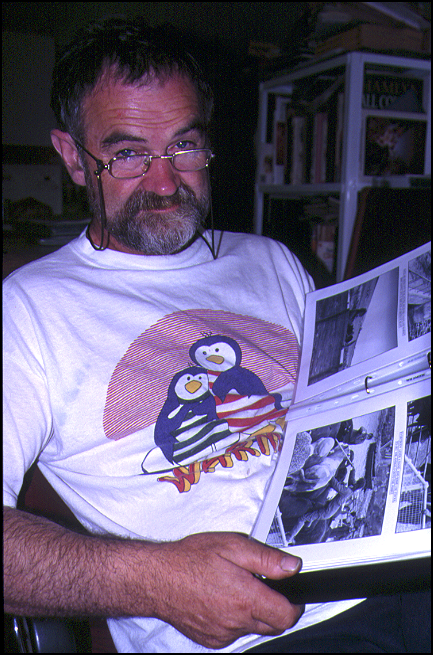
October 10th 2023
The island’s legendary history man has just passed away in his sleep. ‘Rousay Remembered’ would be nothing without the inclusion of his photographs and memories.
Rest in Peace dear friend.

by
Margaret Green

The Johnstons had farmed Crook, Rendall, for three generations – but soon after the First World War the farm was sold from under them. They had to find another tenancy and moved to Trumland – James Halcro Johnston, his wife Maggie, his two unmarried sisters Maggie and Clara (who lived at the Old Mill) and three teenage children, Bobby, James William, and Violet.
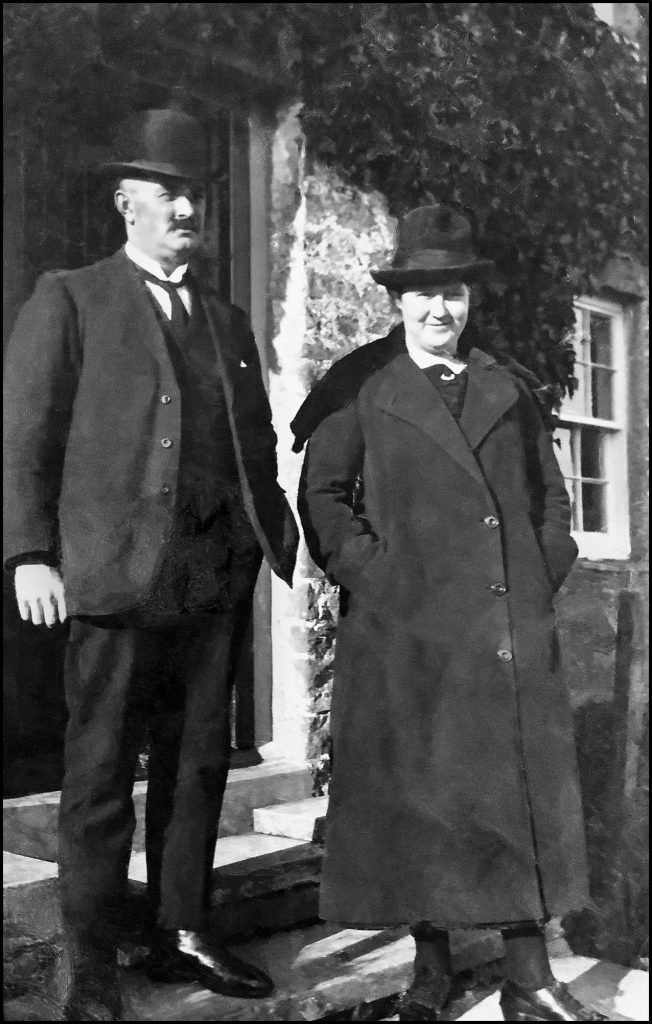
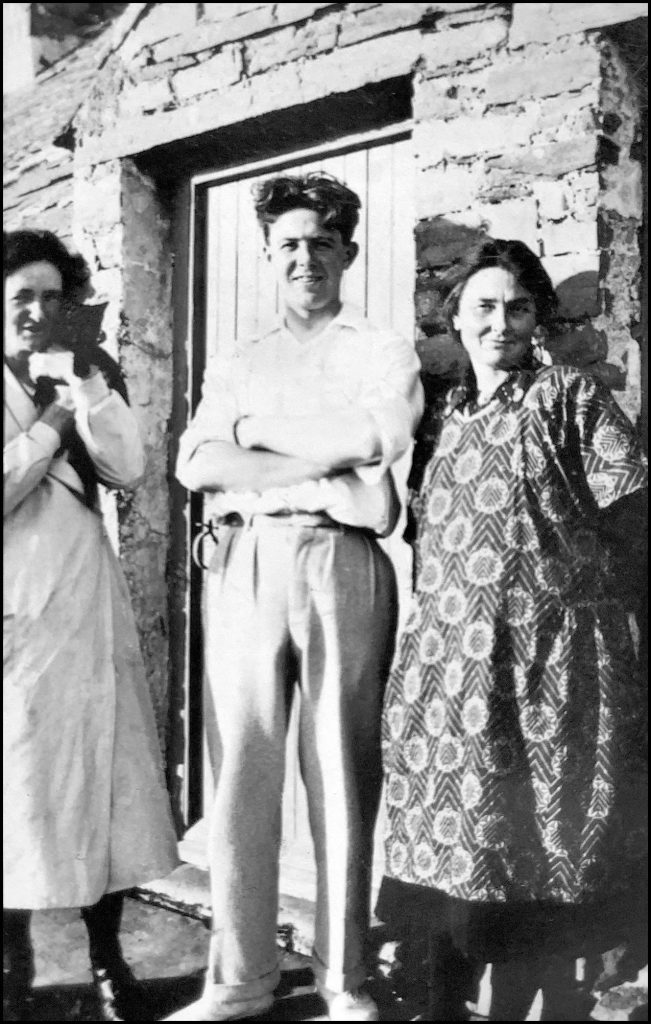
James took great pride in exhibiting livestock at the annual Rousay Agricultural Society Show. In 1926 he won a number of prizes in all classes of cattle, but it was his Clydesdale mare which won him the highest accolade – the Highland and Agricultural Society of Scotland’s medal for Best Mare in Yard. Below is a cuting from the Orkney Herald describing the event, and a photo of the actual medal – courtesy of Signy Spence, James’ great-great granddaughter.
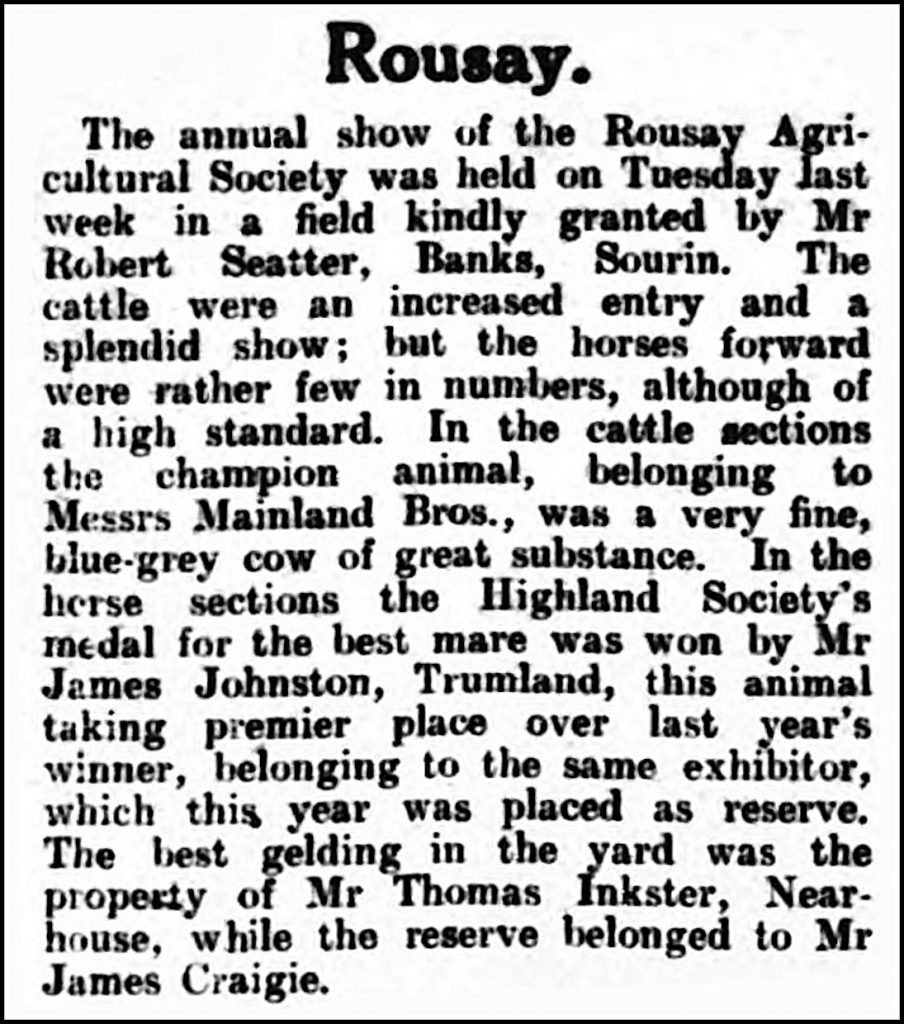
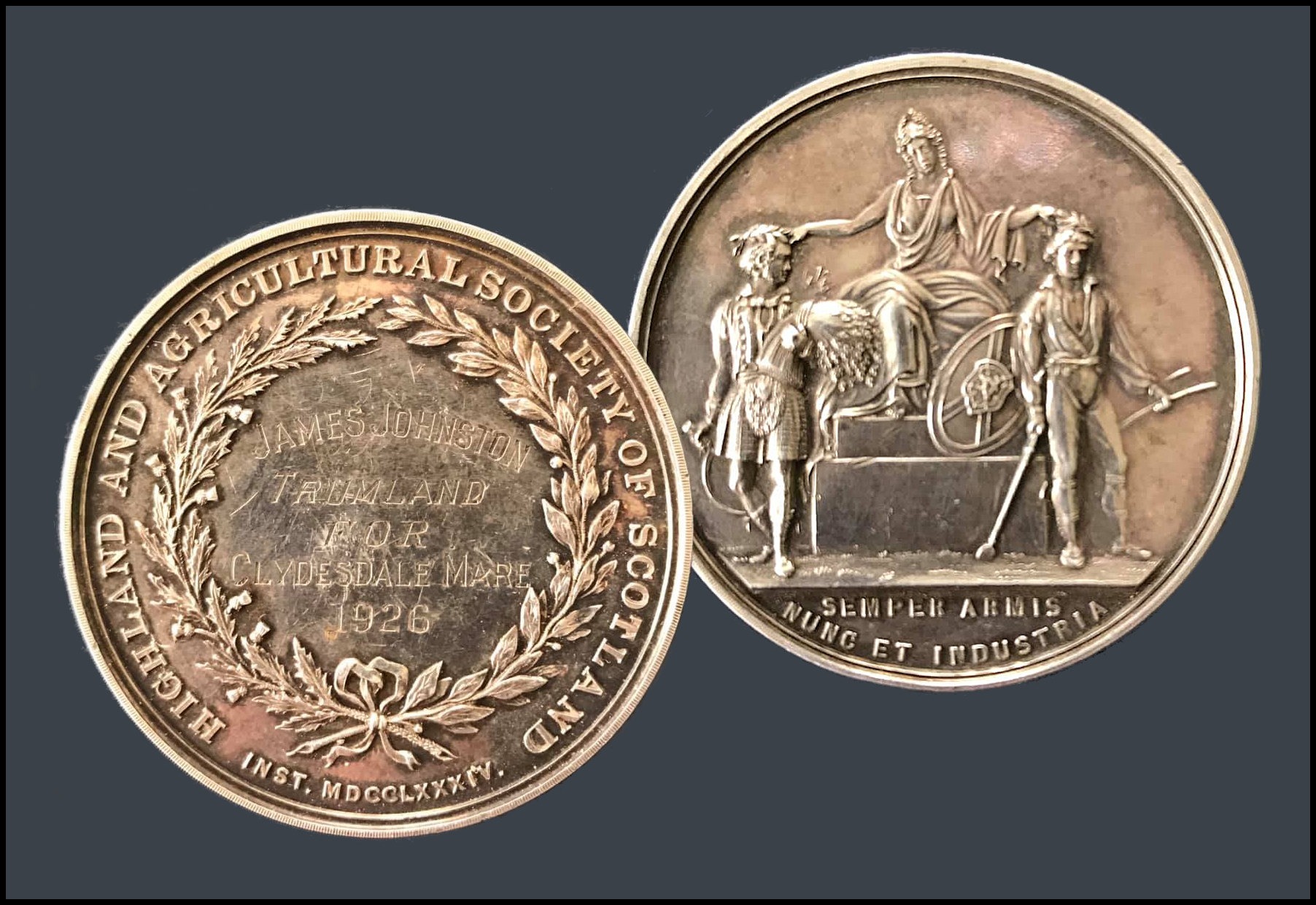

Margaret Green, daughter of James William and his wife Johan, has been kind enough to submit the following for inclusion on Rousay Remembered:-

This is James William’s story. Passages in italics are verbatim from his 90th birthday speech:-
My father had a strong musical bent. He played the fiddle at the local dances. He led the praise in church where there was no organ. He could strike the key of his tuning fork and read the tonic sol-fa at a glance. He participated in the concerts in aid of the Red Cross during the war, and my Uncle Jamie once told me he could be heard whistling all day long in the fields. He was a man of very deep feeling, and always in tears when I was leaving home in later life.
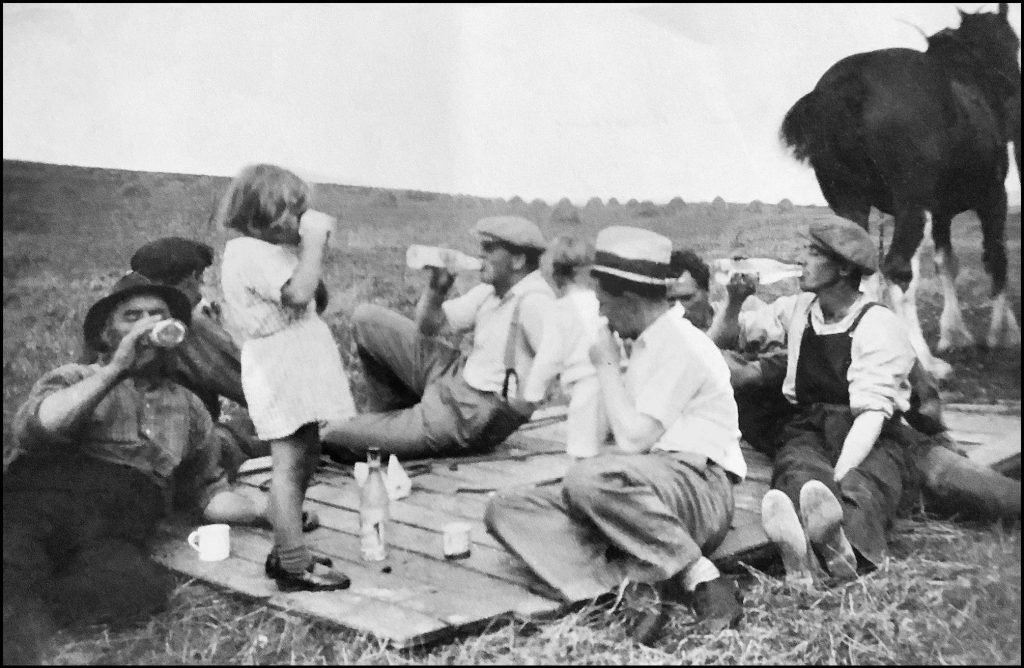

My mother put in a great deal of work. She milked twice a day and made butter and cheese and very often was out helping in the fields.
The children had been at Rendall School.
I got on reasonably well at school. It was a 2 teacher school, with a kind lady for the infants. The headmaster was an alcoholic who for this reason was probably forced to look for a small school in Orkney. He was from Dundee and for a time had sailed abroad. But 2 days every month he was quite drunk and very rarely in school. But he was a clever little man and made up for it when sober.
(I think the Rendall teacher must have been an interesting man; he was liable to illustrate a geography lesson with such words as “I remember, as we steamed into Valparaiso…..”.)
I had a turn of good luck in my last year in Rendall primary school. At that time there was an exam for primary schools in Orkney and Shetland. I sat this exam and was lucky enough to be 2nd in the county. When the minister who had supervised in the exam came to Crook with the prize he told my father that it was on condition that the winner went on for higher education. The nearest school was Kirkwall Grammar School 16 miles away. So I had to stay in digs.
There was of course no hostel at KGS in those days and the digs were pretty grim. For 5 shillings a week they got bed and light (a candle), no heat of course, and “something from the pot” – a share of the family meal. Breakfast was tea and bread, lunch was two caraway biscuits. The boys were often hungry. James William would cycle home to Rendall at the weekends and his mother would feed him up and send some food back with him.
All went well for two years but in the first term of his 3rd year there came the upheaval of the move to Rousay. There was no way he could commute to Kirkwall, he left school and started to work alongside his brother and sister on the farm. But the next summer the family had a visitor from Canada, a relative of James’s mother, Ann Wood, who was from Wyre. He was a man of some education who had made good in Canada (Do we know who this is? William Wood possibly? MG) He took an interest in the boy, particularly when Aunt Maggie showed him some of JWJ’s essays, and when he got back home he wrote to James saying “This boy should be in school”. So back he went.
When I arrived at school after this long absence the headmaster Dr Marwick was stunned. He told me to go to my old class meantime until he made up his mind what to do with me. But he forgot and I struggled along in class all 4th year. Then in the 5th year the Highers were due and I was allowed to sit them. I got Higher English and History, Higher Maths, Higher Chemistry and Physics and Lower Latin. So I got my Highers in 4 years. When Dr Marwick came in with the results he didn’t say well done, he said “Johnston, you lucky dog.“
(Dr Marwick incidentally introduced a lifelong love of poetry; in old age JWJ always enjoyed a good quoting match).
There was no question of going home every weekend. Sometimes he would go home with school friends, sometimes to relations on the Mainland. But he used to tell a story of going home to Rousay, cycling, presumably to Evie, lighting a fire of dry seaweed on the shore and watching the boatman across the water, who had to stop ploughing and unharness the horses before coming down the field and setting out to fetch him. A slow business.
In the holidays there was plenty to do in Rousay. Working on the farm was expected, but he also had a go at painting in water colours, tutored by John Logie.
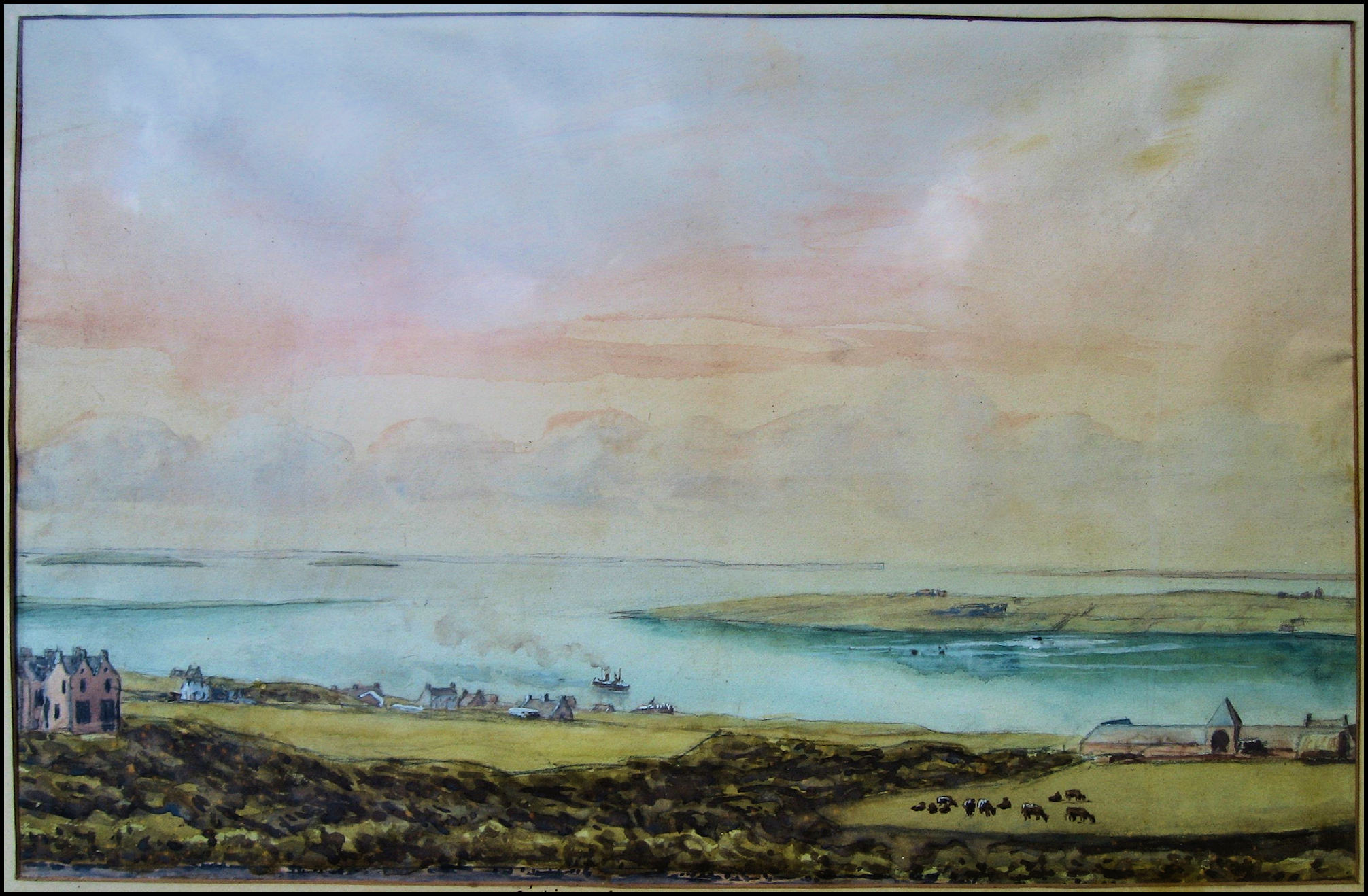
In the evenings the young folk would sometimes commandeer a fiddler and start an impromptu dance. Summer visitors joined in, including sisters Jessie and Nan from Aberdeen who came up every year, their mother was a Sabiston of Wyre ancestry and sister of Bab Harrold. And eventually, after keeping up with the family in Aberdeen, James William married Nan in the island’s only double wedding on July 26th 1933.
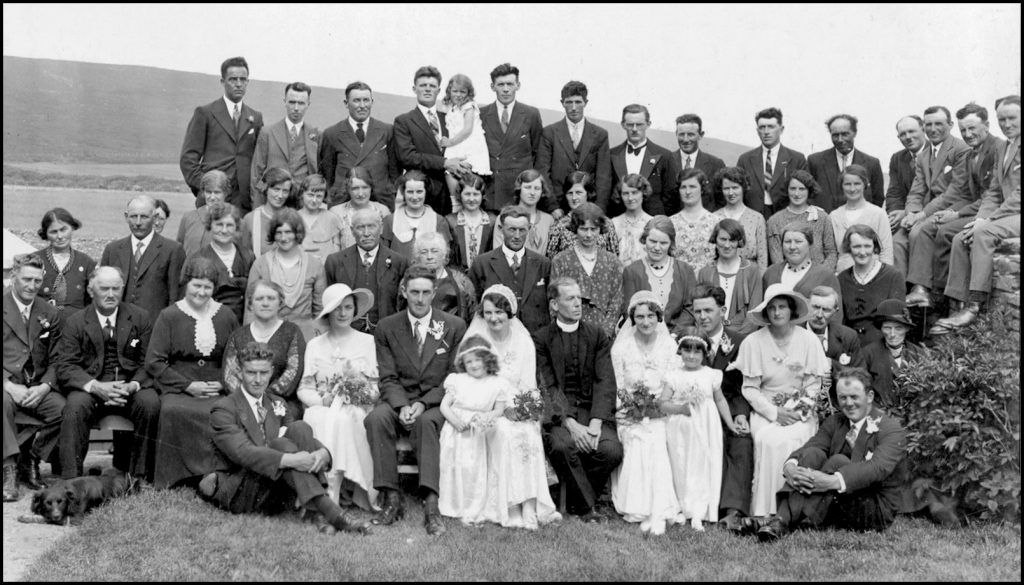
Samuel James Inkster was the son of John Inkster and Jane Irvine, Woo. Violet Johnston was the daughter of James Halcro Johnston, Crook, Rendall, and Margaret Ritch, Binaquoy, Firth, later Trumland Farm. They were involved in Rousay’s only double wedding, for on the same day, July 26th 1933, Violet’s brother James William Johnston married Johan [Nan] Johnston Leslie at Trumland church. Johan’s parents were monumental mason George Gerrard Leslie and Johann Johnston Sabiston, Aberdeen, who was a sister of George Harrold’s wife Barbara Sabiston, and having been a regular visitor to Rousay on holiday since childhood. At the time of the double wedding 27-year-old Sammy was farming the land at Wasdale and 23-year-old Violet was employed as a housemaid. James William was a 26-year-old research worker, living at Strathcona House, Aberdeen, and Johan, also 26 years of age, a ‘clerkess,’ living at Bedford Place in the same city. The ceremonies were conducted by the Reverend Robert R. Davidson, and the witnesses were Sammy’s brother Tommy Inkster, and Isabella Craigie of the Sourin school house, and Robert Ritch Johnston and Robina Ann Johnston, Testaquoy, Wyre.
Front row, from left: 1 George Leslie, Aberdeen, father of Nan. 2 James Johnston, Trumland Farm. 3 Margaret Johnston, Trumland Farm. 4 Mrs Johann Leslie, Aberdeen. 5 Bridesmaid, Isabel Grieve, Fa’doon. 6 Groom, Sammy Inkster, Wasdale. 7 Bride, Violet Johnston, Trumland Farm. 8 Flower girl, Marian Ritch, Aberdeen, a cousin of Violet. 9 Rev. Robert R Davidson. 10 Bride, Johan [Nan] Leslie, Aberdeen. 11 Groom, James William Johnston, Trumland Farm. 12 Flower girl, Joyce Ford, Aberdeen, daughter of Nan’s sister. 13 Bridesmaid, Ina Johnston, Testaquoy, Wyre. 14 John Inkster, Woo. 15 Jean Inkster, Woo. 16 Seated on grass, front left: Best man, Tommy Inkster, Woo . 17 Seated on grass, front right: Best man, Bobby Johnston, Trumland.
Second row: 1 Maggie Johnston. 2 Mr Fraser, Feavel, Birsay. 3 Mrs Fraser, Feavel. 4 Jessie Donaldson, Vacquoy. 5 George Harrold, Russness, Wyre. 6 Barbara Harrold, Russness, Wyre. 7 Jeck Yorston, Drydale, Stromness. 8 Bella Yorston, Drydale. 9 Violet Ritch, Kierfold, Sandwick. 10 Eliza Ritch, Myrtledene, Sandwick. 11 ?. 12 Maggie Jean Ritch, wife of Jamie Ritch and mother of Violet’s flower girl. .
Third row: 1 Clara Johnston [half hidden]. 2 ?. 3 Edda Mainland, Cott. 4 ?. 5 Bella Johnston, Trumland. 6 ?. 7 Lily Fraser, Feaval, Birsay. 8 Louisa Ritch, Braehead, Holm. 9 Anna Mathieson, Sourin Manse . 10 Jessie Ford, Aberdeen, sister of Nan and mother of Nan’s flower girl. 11 Tina Craigie nee Mathieson, Wasbister School. 12 Peggy Marwick, Ronaldsay. 13 Elsie Shearer, Curquoy, later Housegarth, Sandwick. 14 Jeannie Harcus, Knapper.
Fourth/back row: 1 ?. 2 Jim Craigie, Deithe. 3 ?. 4 Ronnie Shearer, Curquoy. 5 Thelma Shearer, Curquoy. 6 Bill Flaws, Hammerfield. 7 John Cormack, Witchwood. 8 David Craigie, Trumland. 9 Jamie Ritch, the youngest of the Ritch brothers, father of flower girl. 10 Willie Inkster, Woo. 11 Sandy Donaldson, Vacquoy. 12 Angus Harcus, Knapper. 13

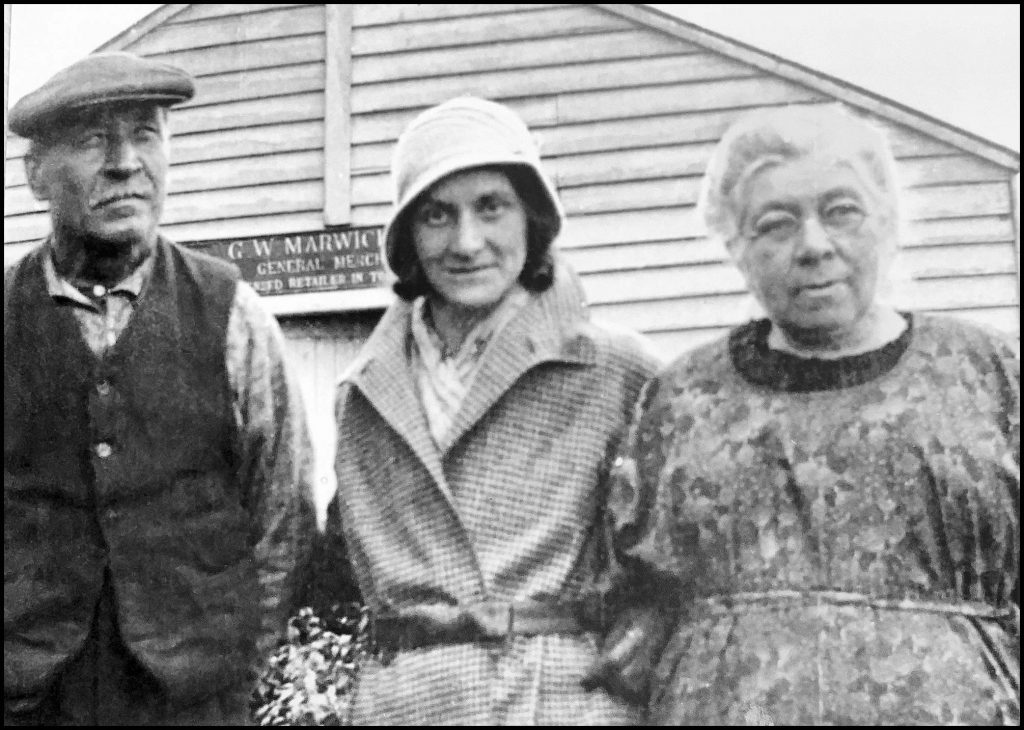
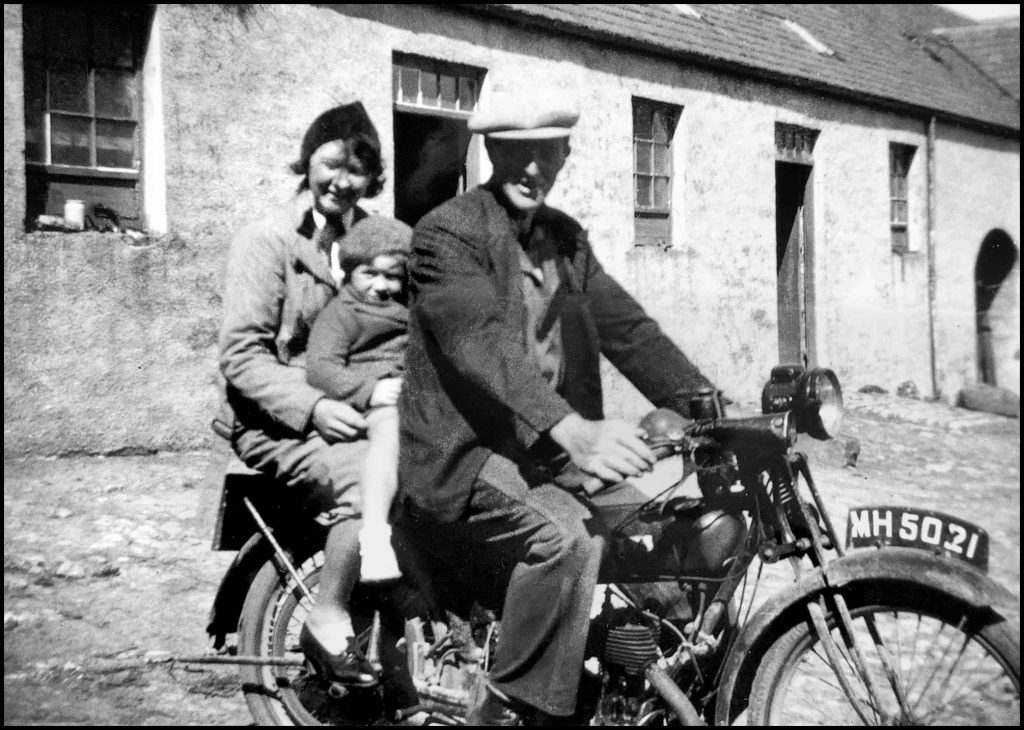
James William went on to Aberdeen University in 1926 to do a BSc (Agri) and on graduation got a job at the Rowett Nutrition Research Institute, then just outside Aberdeen, where he ended up in charge of the poultry department of the attached farm.
Unfortunately the war came in 1939 and it was decided that experimental work would have to be wound up. So I found myself without a job and with a wife and children in a tied house. Many people found themselves in a similar situation. In a desperate moment I offered on a small farm, Greenlands, in Fintray, and was allowed entry in May 1941. So with a month’s salary in my pocket I bought 20 tons of ware potatoes, cut them up and planted 14 acres. Luckily there was a small subsidy put on to grow a potato crop that year.
After struggling through the war he developed a good business selling day old chicks all over the north east (and by plane to Orkney) and when that failed due to the entry of the big firms from the south he moved on to beef cattle and in particular to the Aberdeen Angus Society.

James William’s obituary, printed in The Herald, Scotland’s edition of September 21st 2001, gives further details of his life and times:-
James William Johnston, Honorary president
of Aberdeen-Angus breeders.
Retired farmer and poultry expert James Johnston, 94, farmed at Newton of Fintray, near Aberdeen, for more than 50 years.
Orkney-born Mr Johnston – known to his relatives in the Orkney tradition as James-William and to his friends as Jimmy – hit the headlines in 1951 when his cross-bred heifer, Kilmeny, won the butchers’ cattle championship at the Scottish National Fatstock Show in Edinburgh and went on to win the reserve supreme championship at the Royal Smithfield Show at Earls Court, London.
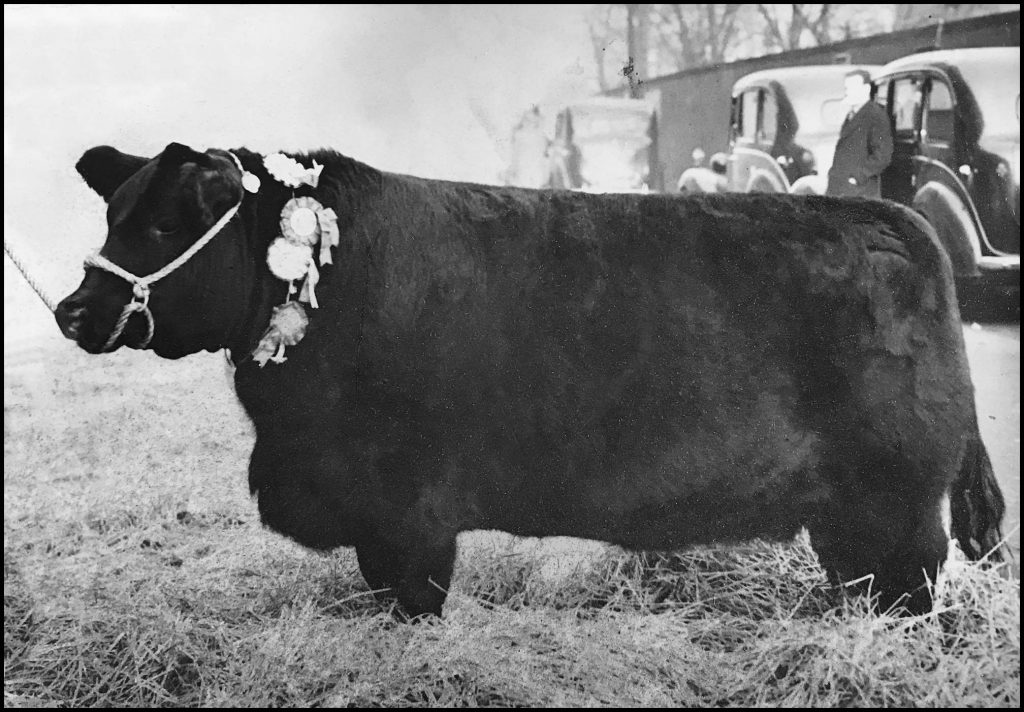
He was born in 1907 in a small, two-roomed cottage on the farm of Crook, Rendall, Orkney, where his family had been tenants since 1840, and moved to Trumland on the island of Rousay in 1922 when his father took on the Home Farm.
After being awarded equal first prize in the Orkney and Shetland Scholarship, he went to school in Kirkwall and then to Aberdeen University where he graduated BSc in agriculture.
Following his graduation, he joined the Rowett Research Institute at Bucksburn as a research worker and carried out an important research project on fowl paralysis which was a major scourge of the poultry industry at that time.
He set up an isolation unit at the Rowett and established that fowl paralysis was a transmissible disease which could be prevented through hygiene and isolation. His findings were published in a paper in the British Veterinary Record.
With wartime cutbacks in research causing considerable uncertainty, he took the lease of Greenlands Farm at Fintray – moving from a comfortable modern house at the Rowett to a house with neither running water nor electricity.
He established an incubator in a shed behind the Banks of Ury Hotel, Inverurie, and built up a business supplying day-old chicks to farmers throughout the north-east – a business which continued for many years.
He bought the adjoining farm of Newton in 1945 and, after being captivated by the view on the south side of Newton Wood, built a house there in 1948 which was his home until he was taken into hospital a few weeks ago.
Apart from his poultry business, his main interest was the bringing on and showing of fatstock, and he also built up a herd of pure-bred Aberdeen-Angus cattle.
At the time of his death, he was honorary president of the North East Aberdeen-Angus Breeders’ Club, in whose activities he had taken a keen and active interest since the club’s foundation in 1972.
He was a regular at the mart at Thainstone, Inverurie, and, along with the late Jim Maitland and the late Willie Lawson, comprised a trio who met for lunch at the mart every Friday and were affectionately known as ”The Last of the Summer Wine”.
ANM Group marketing manager and A-A club secretary Eddie Gillanders, said Mr Johnston would be sadly missed by all his friends at the mart and in the Aberdeen-Angus world.
”Jimmy was a much-loved figure who was always keen to encourage the younger generation and give them the benefit of his long experience,” said Mr Gillanders.
Despite colour blindness, he was naturally artistic and in his younger days painted watercolours which still hang in the homes of friends and family.
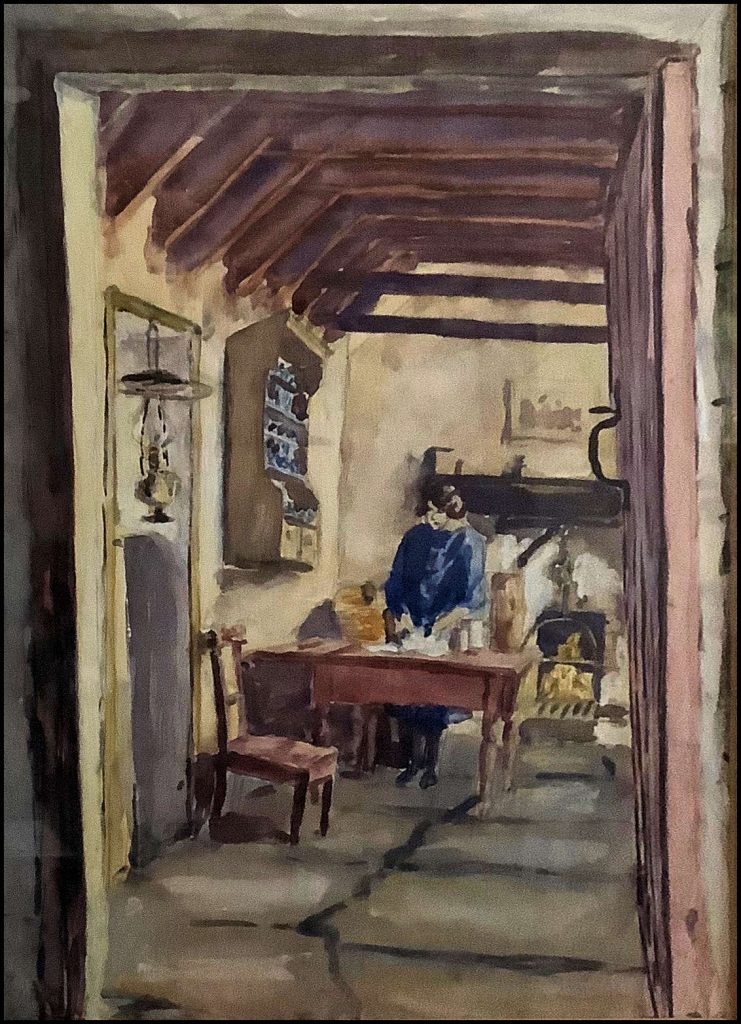
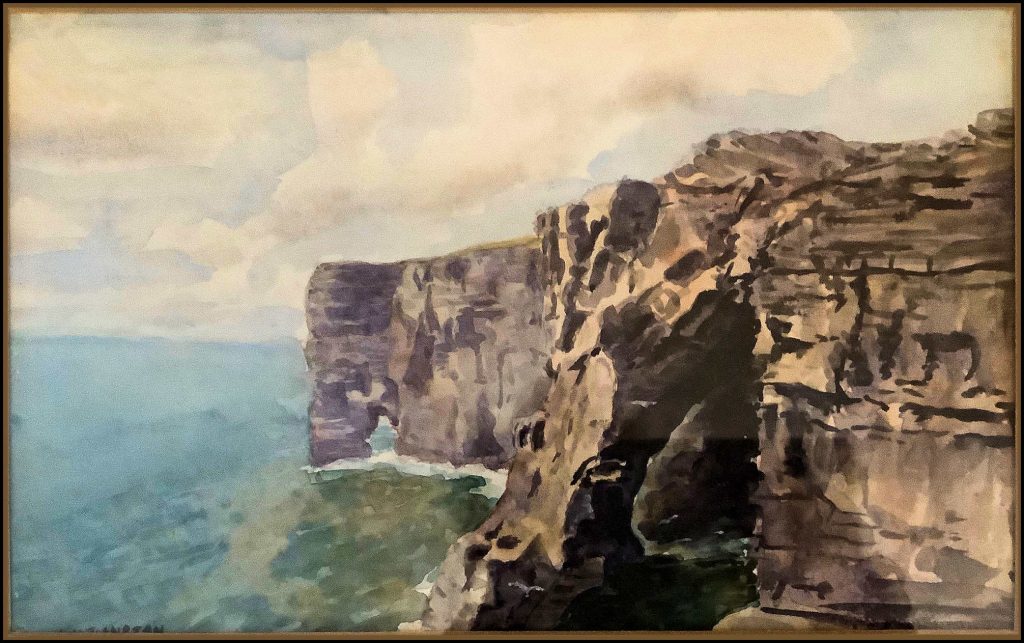
A fondness for poetry stayed with him from school days although – as an Orcadian rather than a Scot – Keats, Shelley, or Wordsworth were more to his taste than Robert Burns.
Mr Johnston was predeceased some years ago by his wife, Nan, whom he married in Rousay in 1933. He is survived by his sons, Robin, who recently retired from Ross Poultry, Hal, an actor currently appearing in the stage musical Fame in London’s West End, and daughter, Margaret, who lives in Coventry. He had seven grandchildren and four great-grandchildren.
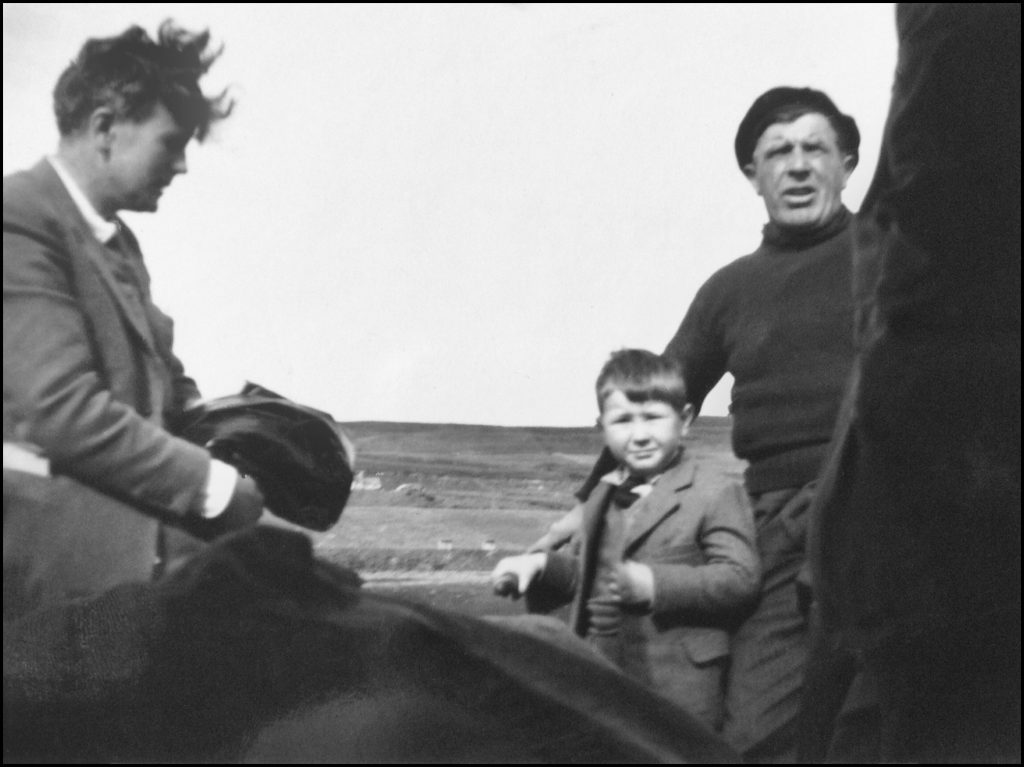

Margaret tells us about James William’s older brother Bobby:-
Bobby was born in 1905. He was said to be very clever but not interested in education; he couldn’t wait to be out working on the farm. He was a stockman at heart, first with the Clydesdales, then with cattle and in his later years he bred Shetland ponies. He was a big man, loud and joking and a born raconteur – he could make a story out of anything. He married Bella Cursiter in 1934; unfortunately they had no children. Bella died in 1959 and he later married Sadie the widow of Billo Gibson. He died in 1971 at the age of 66.
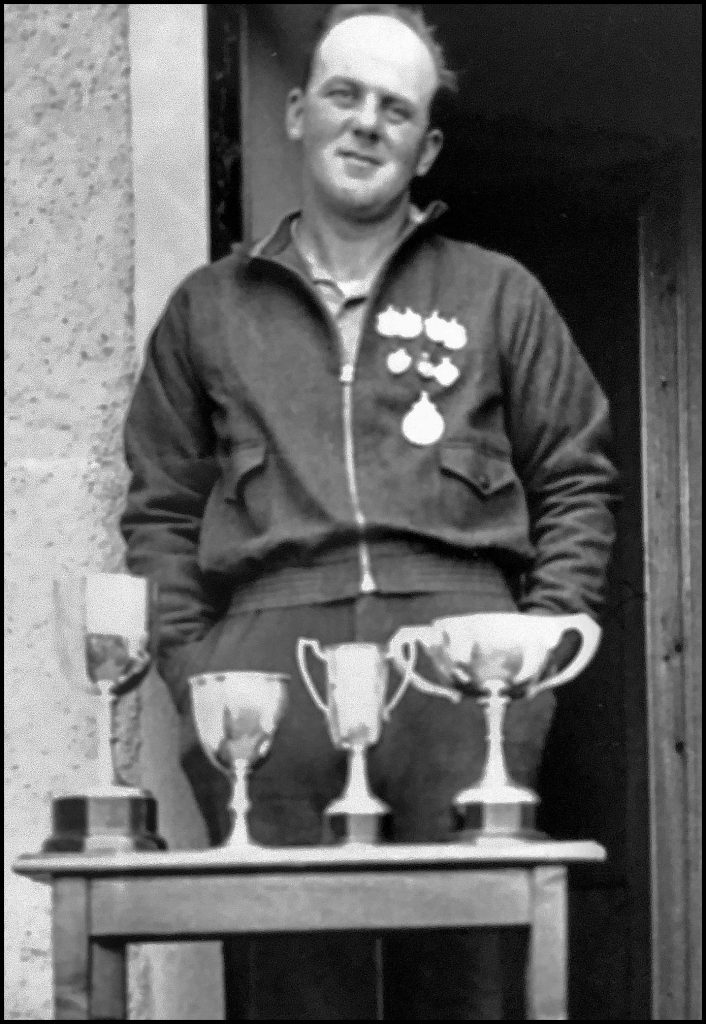
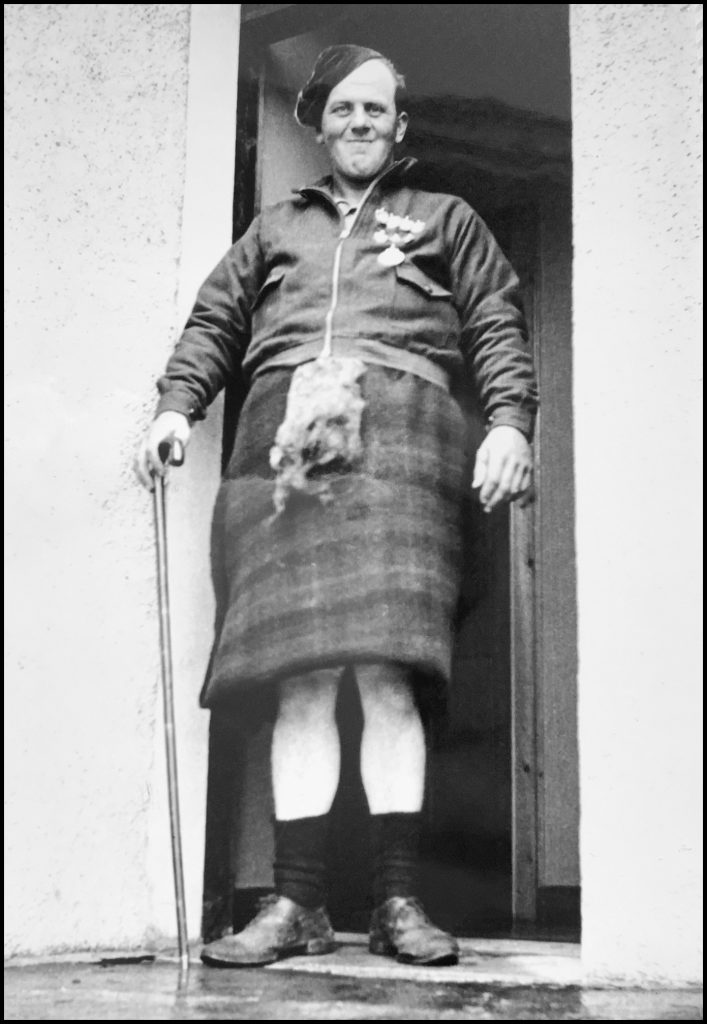
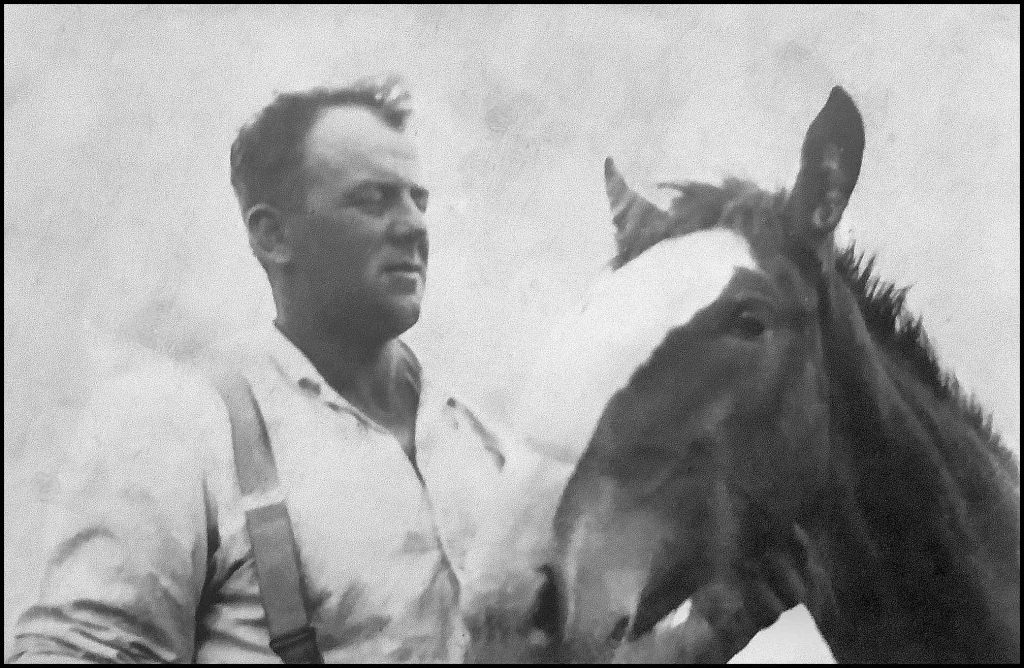
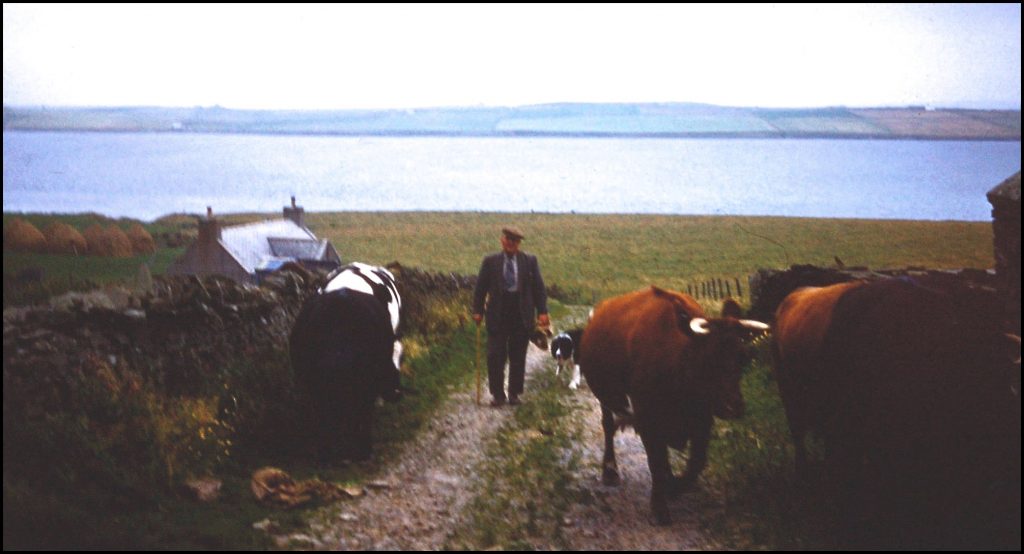

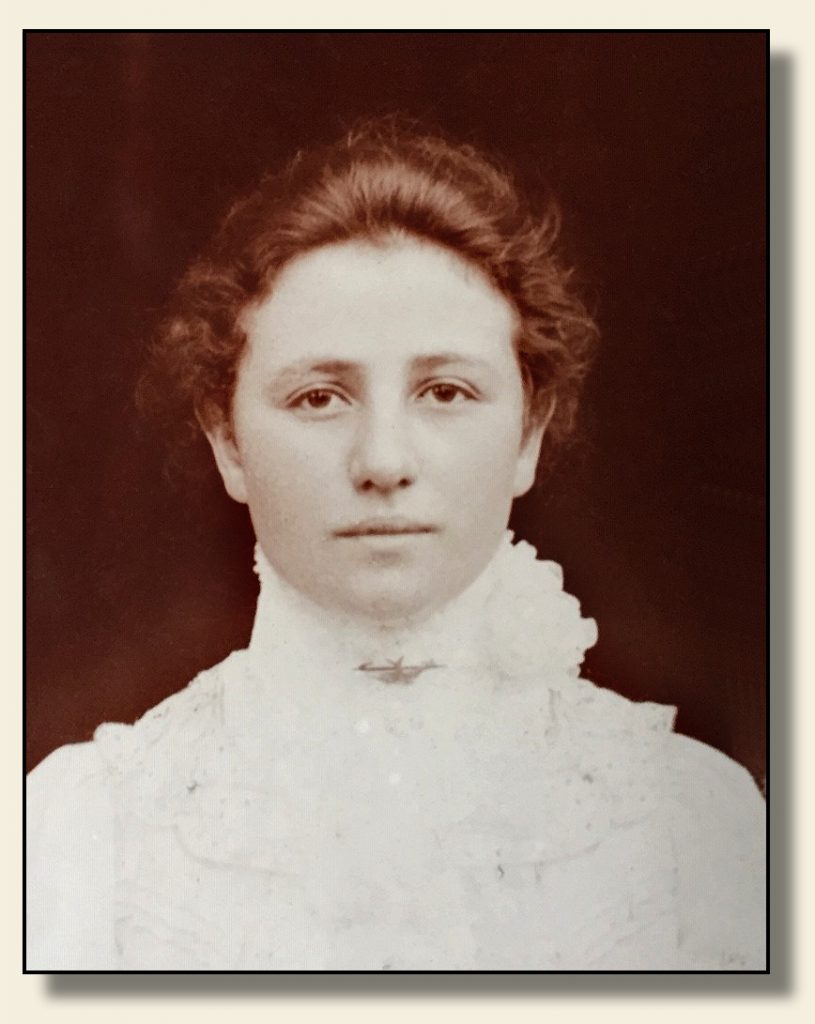
Lizzie Burroughs Murrison was born in a room above the coach house and stables in the grounds of Trumland House early on the morning of January 5th 1884. Her parents were Robert Mitchell Murrison and Margaret McDonald, who married in Rousay on October 29th 1879. At the time of the 1881 census Robert was employed by the laird, General Frederick William Traill Burroughs, as a gamekeeper on his estate. Robert and Margaret named their daughter after the laird’s wife – Lizzie Burroughs. Robert’s uncle, George Murrison, was the laird’s factor/land steward, living at Veira Lodge in Frotoft.

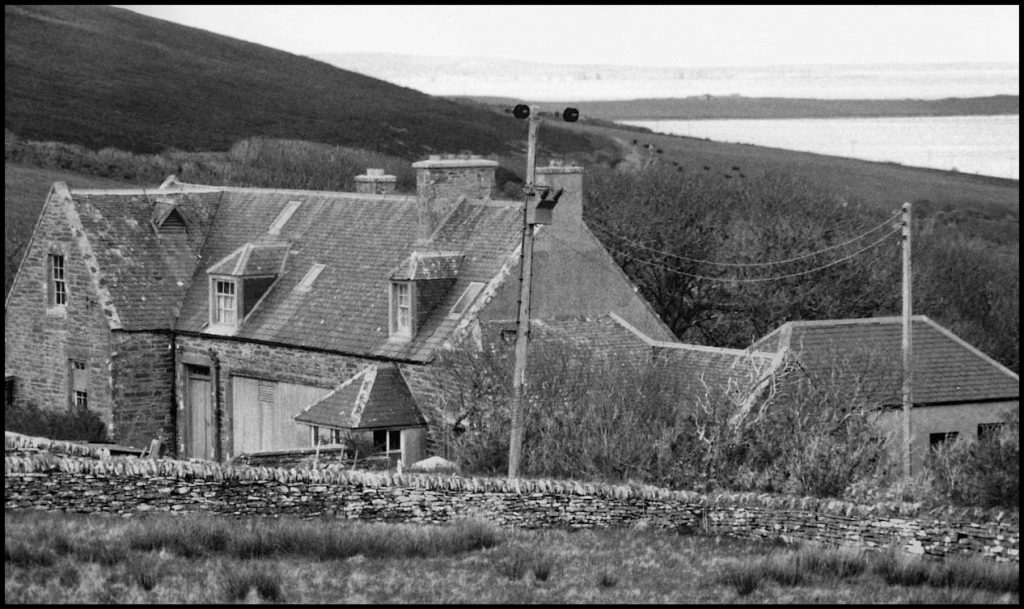
The Murrison family left Rousay in 1885, Robert having taken up the post of steward for the Hansford Flood family on their Farmley estate in County Kilkenny, southern Ireland. Pictured below: Robert and his wife Margaret with their children. Rear left is oldest son Alexander William, who was born on Rousay in 1880; Lizzie is standing beside him. The four younger children were all born in Kilkenny: standing to the right is Robert Edward, born in 1888; Eva Mary (left) born in 1892; Elsie Isabella (centre), born in 1895; and in the foreground is Alan McDonald, who was born in 1898.
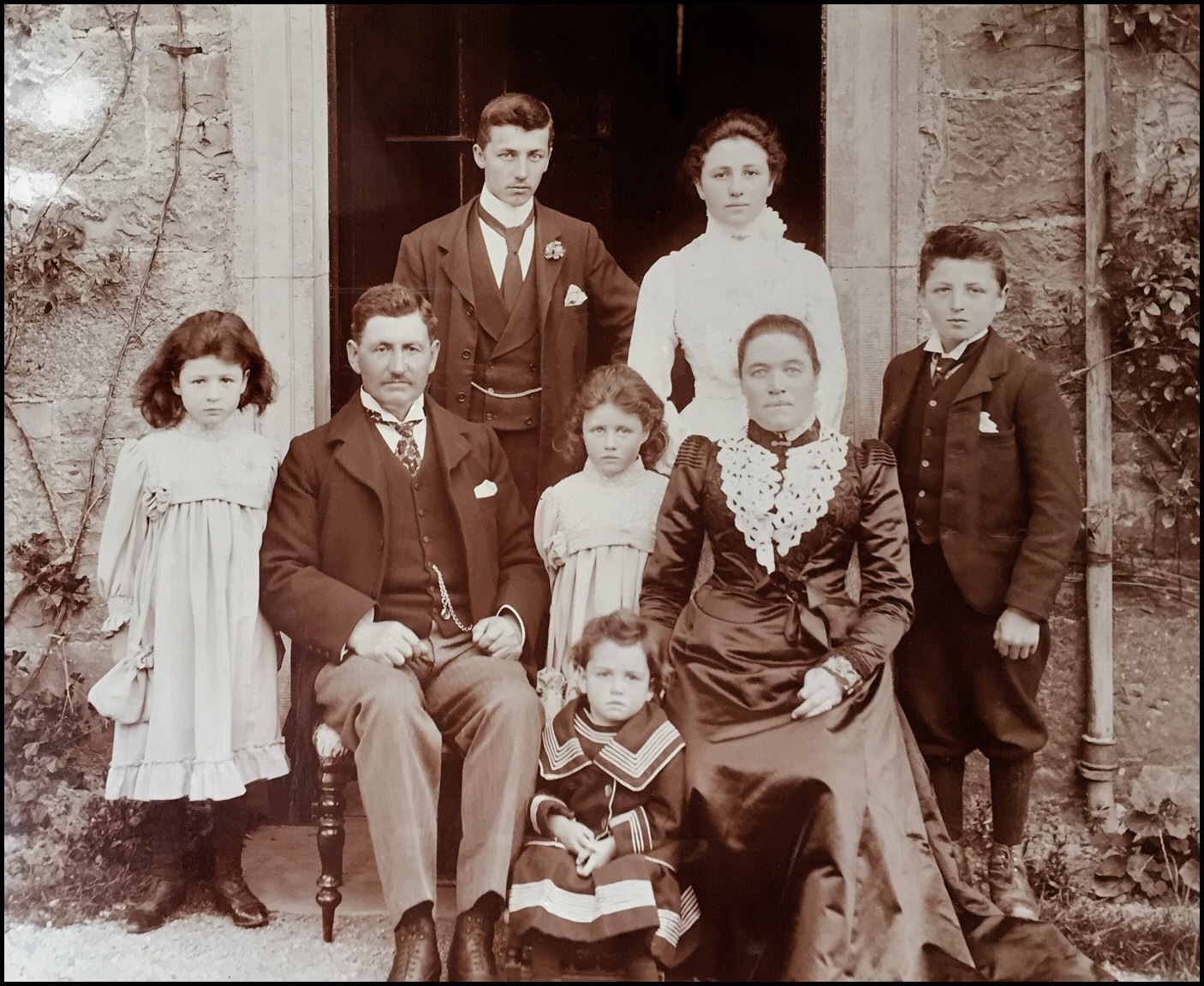
At the turn of the century the development of the British motor car industry was in its early days, and in September 1903, circumstances lead Lizzie Murrison to be present at a Reliability Trial being held at Crystal Palace, south London. Subsequent events lead to Lizzie being the first woman to drive a motor car from Land’s End to John o’ Groats.
Lizzie’s great nephew, Rod Calder-Potts, has been kind enough to send Rousay Remembered photos and information, including a transcription of an article in the Kilkenny Moderator and Leinster Advertiser, dated Wednesday Morning, October 7, 1903.
————————-
Unexampled Feat by a Young Lady.
Hearing that a lady had accomplished the unprecedented feat of driving a motor car from Land’s End to John O’Groats, and that she was staying in the town, our representative called upon her at Randall’s Station Hotel, Wick, last night, and was successful in obtaining an interview with her, and gleaned many interesting details concerning her record of driving unaided a motorcar over 900 miles. This lady, Miss Murison – who comes of an Orkney family – is an attractive-looking daughter of the Emerald Isle, and her speech “bewrayeth” her nationality. She is the daughter of a well-known Kilkenny country gentleman, and besides being an accomplished and intrepid equestrian, is passionately fond of all outdoor sports. Her acquaintance, however, with motoring is only of short duration, for it is only within the past few weeks that she has had any opportunity of indulging in this most exhilarating form of country travel.
Being on a visit to “Bonnie Scotland,” as she terms it, and staying with friends at Paisley, the main centre in Scotland of the “Mo-Car” industry, she obtained the privilege of driving several times on an Arrol-Johnston Mo-Car of the dogcart type. After some half-dozen lessons she attained a degree of efficiency which was surprising in a lady so young, Miss Murison is not yet being 20 years of age.
Recently there have been held at the Crystal Palace, London, what are termed Reliability Tests for motor cars, and the Motorcar Syndicate of Paisley had entered several of their cars for the tests, but owing to some misdirection on the part of one of the guides their cars arrived at the Palace grounds a few seconds later than the stipulated hour and were refused admittance. Miss Murison, hearing of this unfortunate contretemps, at once proposed that she might be allowed to drive one of the cars part of the way back from London. This courageous offer was accepted by the Paisley company in a modified form, to which Miss Murison readily assented, and this was that she should run the car from Land’s End to John O’Groats.
The run commenced on Tuesday last at 4 pm, she earlier in the day having been given her first and only lesson on the car she was to drive. The distance between the two points is approximately 900 miles, and this she covered in five days, running an average of 180 miles per day. Her largest drive on any one day was 213 miles. The roads in Cornwall and in some parts of the Highlands are particularly trying, and the drive was made for some considerable distance through rain and mist, yet Miss Murison accomplished the journey without the slightest hitch. The ladies and gentlemen who accompanied her express themselves delighted with the journey, and marvel at the skill displayed by the fair motorist. The subject of this interview grows enthusiastic over the beauties of the Scottish scenery, and in answer to our enquiries said, “Yes! I had the good fortune to steer quite clear of all accidents to either man or beast,” although, she added, with a twinkle in her liquid eyes, “several of my party expected, I believe, to end their journey in glory.”
A not unlikely result of Miss Murison’s feat will be to give an impetus to the motor industry, as the record of her trip conclusively demonstrates how easily a Mo-Car can be handled even without any technical skill, and how absolutely reliable those vehicles now are, especially those made to run with the maximum of comfort and moderate speeds, as is the case with those made by the Paisley firm. This is only to be expected when we state that Sir William Arrol of Forth Bridge fame is chairman of the Mo-Car Syndicate, Paisley, the makers of the car Miss Murison rode.
Miss Murison says she has no desire to shine as a record-breaker, and speaks of her task as a comparatively light one, and, with a faraway look as if thinking of the land of her birth, she says she hopes at no distant date to become as familiar with the beauties of “Ould Ireland” from the seat of her Mo-Car as she now is with those between Land’s End and John O’Groat’s. – [signed] “Northern Ensign”
(Miss Murison, who is of Scottish birth and parentage, was born in Orkney, but had been resident in Farmley, County Kilkenny, with her parents for a number of years.)
A correspondence writes me today – ‘With reference to your paragraph about this ”Irish Girl’s” motor car drive from Land’s End to John O’Groats, the name Murison or “Mearison” as it is sometimes called in Aberdeen awa’, is not exactly suggestive of Irish origin, and you may take it from me that the girl who accomplished the feat referred to is Scottish by birth and parentage. She has, however, spent a number of years with her people in the south of Ireland, a circumstance that no doubt sufficiently accounts for the adjective your contemporaries and yourself applied to her. – [signed] “Glasgow Evening Times”
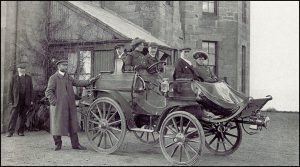
It was Nottinghamshire man Tony Thorpe who brought Lizzie’s story to my attention in the first place. I am indebted to him for that, for the use of the photo above, and allowing me to provide the link below to his ‘Britain By Car – A Motoring History’ website. There he describes the circumstances surrounding how, when, and why Lizzie made her epic journey in much greater detail.
https://www.britainbycar.co.uk/isle-of-rousay/552-the-trumland-estate
Cubbieroo is a cottage at the roadside in the Brinian and named from a nearby mound, traditionally known as ‘Cubbie Roo’s Burden.’
Cubbie Roo is the modern form of the name of a famous Saga chieftain, Kolbein Hrúga, who had his seat in Wyre. A cubbie was the name given to a large, round, straw basket carried on the back by a shoulder strap. Rousay tradition has it that Cubbie Roo once proposed to build a bridge between Rousay and Wyre, and for that purpose was carrying a cubbie-load of stones when the fettle or shoulder strap broke at this spot, and the mound of stones represents his fallen burden. Actually it is a pre-historic chambered burial cairn which had collapsed in upon itself – and the cottage was named after what is now a circular heather-covered mount – a scheduled archaeological monument, pictured below.
Somehow or other Cubbie Roo’s name is commemorated all over Orkney as that of a giant who used to hurl boulders from one island to another. Another old story about Cubbie Roo places him on the island of Westray some miles to the north, from where he flung a huge rock at an enemy giant on Kierfea Hill in Rousay. It fell rather short of its mark and now lies near the shore in the Leean in Wasbister. It is known as the Finger Steen. Those who look for them will still find on the rock the imprints of the giant’s fingers.
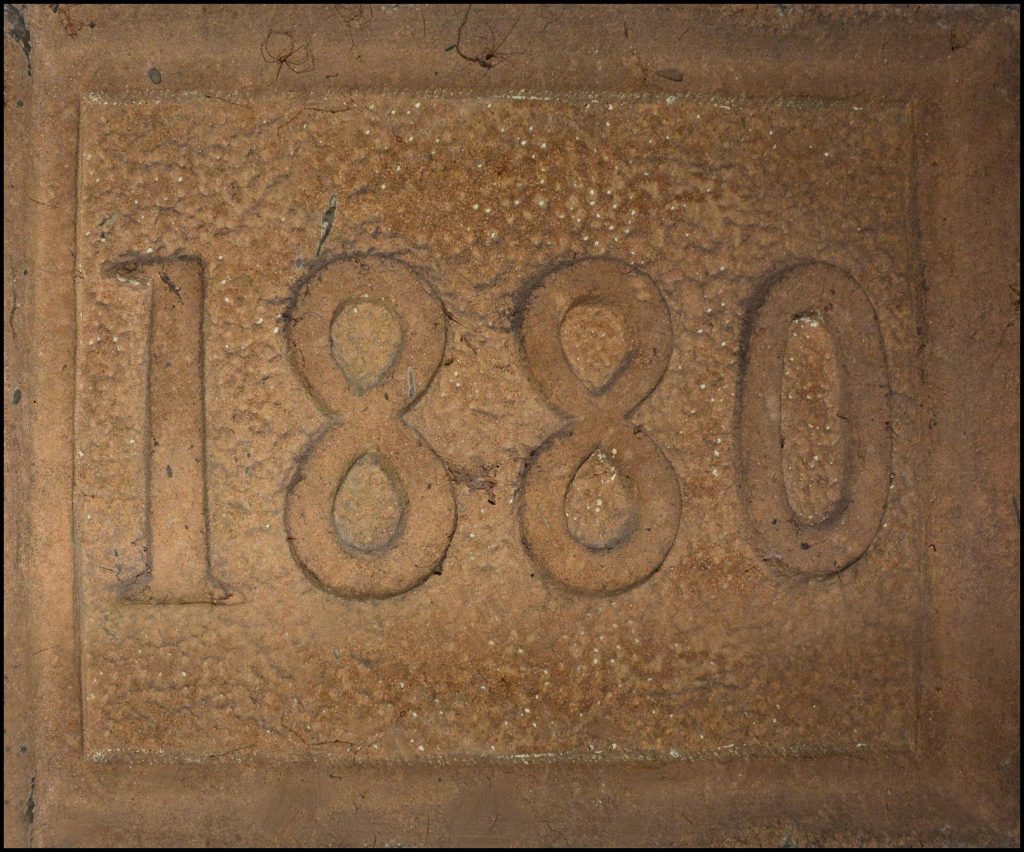
The house was built in 1880, proof of which still extsts in the stone plaque above the inner front door. Its first occupant, according to the census of 1881, was widower James Harrold, a 60-year-old stonemason. He was the son of Alexander Harrold and Marabell Corston of Wyre, born about 1820 at Boray, Gairsay. In November 1846 he married Bella Gibson, daughter of Hugh Gibson and Janet Marwick, who was born on August 20th 1821 at Newark. They had four children: Ann, born in 1848; Margaret, in 1852; John, in 1854; and James, who was born in 1856.
Bella died in September 1878, and the census records widower James living at ‘Kibbieroo’ with his 27-year-old son John and his family, 28-year-old wife Isabella, and children, three-year-old Alexander and William who was two. In November 1882 James married Margaret Mainland, one of the triplets born on February 23rd 1839 to Alexander Drever Mainland and his wife Janet Kirkness of Cruseday, Frotoft.
In 1891 the cottage was spelt Cibbierue in the census, and 64-year-old widow Sarah Craigie lived there with her daughter Sarah and three grandchildren. In 1851 Sarah, the daughter of John Sinclair and Magdalene Craigie of Tratland, married John Craigie of Hullion, known as ‘The Young Laird’. They had seven children between 1853 and 1867; John Inksetter, Anne Marwick, twins James Mainland and Margaret Marwick, Sarah, Hugh and Robert.
At the start of a new century Cubbieroo was occupied by 43-year-old fisherman John Mainland, his 34-year-old wife Isabella, and their 10-month-old son Robert. John was the son of John Mainland, Bu, Wyre, and Mary Sinclair, Tratland. John’s first wife was Annie Louttit, daughter of John Louttit and Jane Wilson, Reedlums, but she died in 1893 at the age of just 29. His second wife Isabella was the daughter of Robert Stevenson, Kirbist, Egilsay, and Margaret Marwick, Woo, and she was born in February 1867. Their firstborn was the already mentioned Robert, and they went on to have four more children – John Sinclair, born in 1901; Mary in 1902; and twins James William and Maggie Jessie Ann [Emmanetta] who were born in 1905. They later moved to Westness farm.
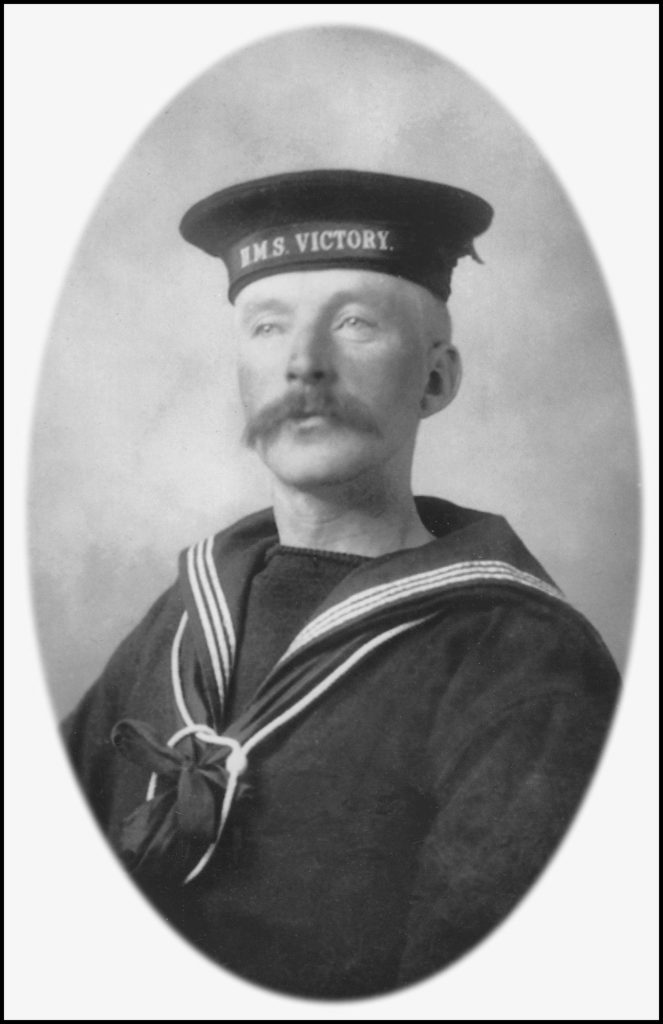
Later occupants were retired farmer James Robertson and his daughter Bella, who used to live at Hunclett. After they moved on another resident at Cubbieroo was Alexander Logie, the son of John Logie, Geo, Westness, and his second wife Jane Harcus, Blowhigh, he and his twin sister Mary being born in 1878. Sandy joined the Royal Navy and served aboard HMS Victory, which was used as a gunnery school in Portsmouth Harbour when the photograph was taken, c1914. He was the half-brother of Trumland House butler John Logie and joiner Charlie Burroughs Logie. He died in 1954 aged 75.
The photo above shows the steep ‘Doctor’s Brae, just along the road from Cubbieroo. Having posted the image on Orkney Past & Present it prompted a few memories from the past…..
Bertie Gillespie: I mind this Brae weel when I wis a young chap I can mind it being a lot steeper than it looks on this photo mind ye it’s maybe because the push bikes brakes were no very good & you built up a fair speed by the time ye got tae the bottom ??
Mary Hargreaves: It was always scary going down there in the Land Rover. Not quite as bad as when my mum used to turn by reversing down the old pier, but close. There was always that moment after the turn when you realised you were sliding off the seat and were about to face plant into the dashboard. At least until we all had to have seatbelts.
Richard Gregory: Brill. Very much my hunting ground. Is much steeper at the top and yes Mary in a LR is very much a leap of faith. Was most exciting when we had to get one of Lilleys gennies up there… Another story that might have involved a contemporary of myself…. no comment!! Once found a very well respected American’s Renault Five on its side just to starboard of the exit and the said State-side citizen on our couch early one morning.. not necessarily in that sequence!
Bellona
Now we ease into Sourin, the parish boundary between it and the Brinian being at the top of the ‘Doctor’s Brae.’ The first house we come to is Bellona [pictured above recently], a cottage at the side of the road near Avalshay, built in 1877 for William Charlesworth. He was sergeant of the Rousay-based 9th Orkney Artillery Volunteers [formed on December 30th 1874], his dwelling being named by the laird, General Burroughs, after the Roman Goddess of War. Before moving to Rousay William and his family lived in Stronsay where he was a sergeant in the Coast Brigade of the Royal Artillery.
In the 1881 census Charlesworth is described as being 45 years of age and a Chelsea Pensioner. He lived at Bellona with his 45-year-old wife Jane and son Thomas who was 14 years of age, and paid rent of just 1 shilling.
Hugh Sinclair, above left c.1900, and to the right in Greenock at the age of 83.
In the centre is his daughter Sarah, mentioned below.
Hugh Sinclair was the son of Hugh Sinclair, Newhouse, later Stennisgorn, and Isabella Gibson, Langskaill, and he was born in October 1853. He married Sarah Craigie, daughter of John Craigie, Hullion, and Sarah Sinclair, Tratland, and she was born in September 1861. They lived at Bellona and had three children: Sarah, born in July 1882; Bella, in August 1883; and John, who was born in October 1886. Hugh ended his working life as harbour master at Greenock.
In 1891, 37-year-old widower John Harrold lived at Bellona having moved a matter of yards along the road from Cubbieroo. He was a mason, and at that time paid £4 rent. He lived there with his three sons, Alexander, William, and Charles, who at that time were all scholars. John was the son of James Harrold, Boray, Gairsay and his first wife Bella Gibson, Lower Burness, and his wife Isabella was from Orphir.
James Lowe, a 52-year-old agricultural labourer, his wife Mary, also 52, daughter Mary Jane, 19, and 17-year-old son James, were the occupants of Bellona in the early 1900s. James senior was the son of James Low and Christina Hourston, Quoyjennie, Frotoft, and he married Mary in 1880. She was the daughter of Gilbert Craigie, Turbitail, Wasbister, and Jean Gibson, at nearby Lower Burness, and she was born at Burness in August 1848. Their son James was later a gardener at Westness House.
Come the census of 1911, Bellona was home to the Robertson sisters: Betsy, 77, was a retired cook; Jane, a 72-year-old retired nurse; and Ann, 69, a retired laundry maid. Their parents were David Robertson [1806 – 1899], South Tofts, Egilsay, and Barbara Craigie [d1888].
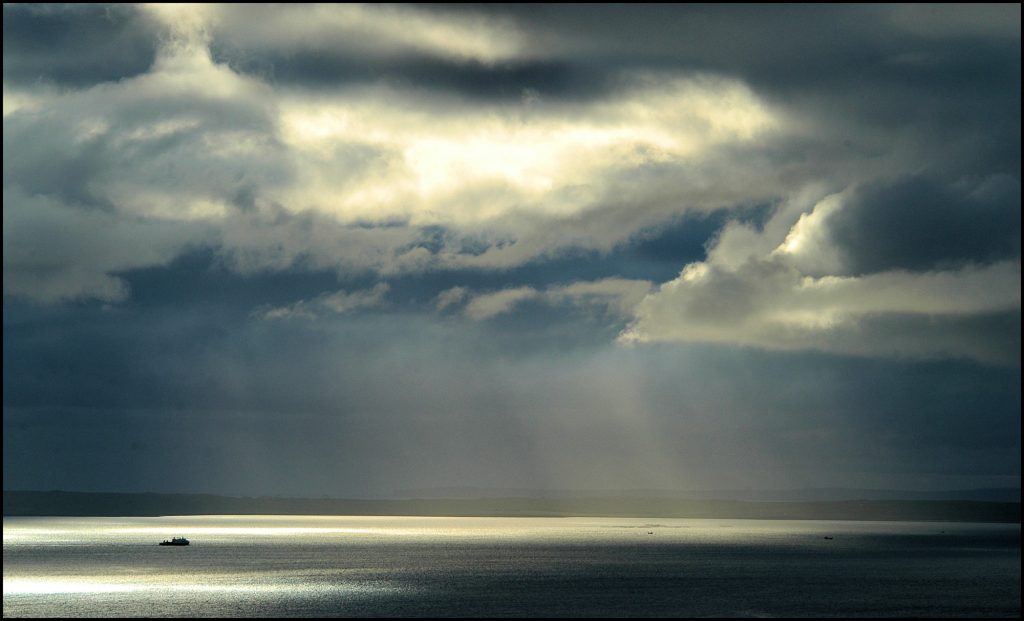
The heading mentioned Cubbieroo, Bellona….and more. Well, here is ‘more’ – and it refers to four ‘vanished’ houses – Ladyhammer, Kitchenhall, Topsquare, and New Grindly. The only place these dwellings are mentioned are in the 1841/51 census – and I am assuming all in the Brinian, the next houses to be mentioned being Kirkha’ and the United Presbyterian Manse. Hugh Marwick does not allude to them them in his ‘Place-Names of Rousay’, and they are not mentioned in Volume 16 of the Ordnance Survey Name Books of 1879-1880, which covers the whole of Rousay, Egilsay and Wyre.
Ladyhammer, or Leedihammer, was occupied in the early 1840s by 29-year-old fisherman John Johnston and his family. The son of Charles Johnston and Janet Harrold of Wyre, john was born c.1812. He married Elizabeth Reid, daughter of George Reid and Barbara Logie of Pow, Westside, who was born in 1815. Between 1838 and 1857 they raised nine children – six boys; John, Robert, William, James, Charles, and David, and three girls; Jemima, Jean, and Agnes. By 1861 the Johnston family had moved to Kirkha’ and Ladyhammer was then occupied by Mary Marwick, a 40-year-old fisherman’s widow and her six-year-old daughter Jessie. [See below]
Kitchenhall was occupied by 75-year-old pauper Robert Grieve and his 55-year-old wife Elizabeth in 1841. In 1851, 33-year-old fisherman William Marwick lived there with his family. William was the son of Hugh Marwick and Mary Yorston of Clook, Frotoft, and he was born on January 31st 1818. In 1846 he married Mary Craigie of Knapknowes, daughter of Hugh Craigie and Mary Yorston, who was one of twins born on April 26th 1819. They had three children; William, who was born on March 30th 1848; Peter, on December 11th 1850; and Jessie Alexina, who was born on June 11th 1854. William Marwick died in 1855, and Kitchenhall was never occupied again. His widow Mary moved into Ladyhammer, and towards the end of the 1800s she was living at ‘Brinian Cottage’, but she died in 1900 when she was in her 80th year.
Topsquare was occupied by 30-year-old Margaret Smith and her five-year-old daughter Betsy in the 1840s. Later occupants were stonemason William Robertson and his family. William was the son of Alexander Robertson and Margaret Irvine of Egilsay and he was born on January 3rd 1810. In 1844, he married Elizabeth Harcus, the daughter of William Harcus and Christy Flaws, who was born in 1809, and they had four children; twins John and William, who were born on November 16th 1846, Alexander on April 23rd 1849, and James, born on May 10th 1851. At the time of the 1851 census William’s widowed mother-in-law, at that time in her 90th year, lived with the family at Topsquare
New Grindly was the name of a house between Topsquare and Kirkha’ at the Brinian. When the census of 1841 was carried out it was occupied by 35-year-old fisherman Hugh Craigie and his family. Hugh was the son of Hugh and Isabel Craigie of Brough, Westside, and he was born on September 11th 1804. In 1823 Hugh was 19-years-old when he married Margaret Harrold (maiden surname Marwick – her second marriage). They had three children; Jean, Betty and Richard. The family emigrated to Dunedin in New Zealand in 1848 after the death of their elder daughter Jean. Sadly Betty, the younger daughter, died during the voyage. With them went Sinclair and James Harrold, Margaret’s sons by her first marriage, and their wives, Barbara Sinclair, and Agnes Grieve.
[All black & white photos courtesy of the Tommy Gibson Collection.]
Captain Ted Fresson and his Highland Airways Gypsy Moth G-AAWO on the Point Field at Trumland Farm, just along from the pier, – flights offered at five shillings a time. Highland Airways was set up by Captain Fresson in 1933, and the Rousay airfield was in operation between August 1934 and 1946.
Margaret Green writes: The year is 1937, that’s me aged 2 in the arms of my father, James William Johnston. My mother Nan (niece of Bab Harrold) is next. The older woman second from right is my Granny, Maggie Johnston, welcoming us to Trumland – or maybe seeing us off, who knows. Don’t know who the other two ladies are, visitors I imagine.
Above left is Maggie Simpson Sutherland, known as Peggy, and her cousin Jeannie Harrold. Peggy, born in 1910, was the daughter of Brinian blacksmith William Sutherland and Margaret Harrold. She married Willie Marwick who ran a shop at the pier, between the smiddy and Brinola. Jeannie, born in 1900, was the daughter of Esther and John Harrold [Margaret’s brother], a general merchant who ran a shop at Rose Cottage. The girls are pictured above right with Jeannie’s brother Jack in his army uniform.
Minna Logie was born in 1867, daughter of John Logie, Geo, Westness, and Cecilia Gibson, Vacquoy. She was the sister of Charlie Burroughs Logie, the joiner, and John Logie, the butler at Trumland House. She later lived at Rose Cottage, and passed away, unmarried, in 1957.
Trumland House gardener John Cutt at Daisy Cottage with baby Jackie MacDonald. To the right is James Grieve, Fa’doon, and standing next to him is Harry Logie, son of joiner Charlie Logie and Alice Gibson, Hullion. Harry married Alice Stout and they lived at Ivy Cottage. Alice is pictured below at Daisy Cottage with her daughter Alice – and her daughter, also christened Alice. c.1935
Brinian blacksmith’s sons George and Hugh Sutherland. George worked at Westness House, but Hugh left Rousay and emigrated to Canada. On the right is George Sutherland and his sister Peggy outside the blacksmith’s and joiner’s shops at the pier.
Two views of Rousay pier taken from the steamer in 1963. From the left: John Johnston, Testaquoy, Wyre; John Petrie, Tratland; Alice Mary Logie, Ivy Cottage; Tommy Inkster, Woo; Harry Sinclair, Newhouse; Neil Flaws, Halbreck, Wyre; James Marwick, Innister; George Sutherland, Viera View; Sheila Flaws, Halbreck, Wyre; ?; John Mainland, Cott. – No names for the folk in the photo to the right unfortunately.
Above left we see postman Roy Russell at the Post boat, with Neil Flaws on board. On the right is a photo sent in by Fred Garson, ex-Faraclett. It shows the ‘Last Clydesdale to leave Rousay’. c1966. Dave Gibson, Hullion, and Harold Grieve, Saviskaill, with the small herd of kye just landed at Rousay pier from the Islander. Also in the picture are Bill Harcus, Archer Clouston, Jim Steebly and Jock Harcus – with Harry Sinclair leading the horse out of the kye’s path before loading it onto the steamer.
[All the other b/w photos above are courtesy of the Tommy Gibson Collection]
Aerial view of Rousay Pier in 1975 courtesy of Charles Tait.
Rousay Pier and its surrounding area, seen from the deck of the Eynhallow in 2010.
The Brinian – including Pier Cottage, Rose Cottage and their Shops,
the Blacksmith and Joiner’s Shops, Ivy Cottage, Viera View,
Daisy Cottage, Cott, Kirkha’, and the U.P. Manse.
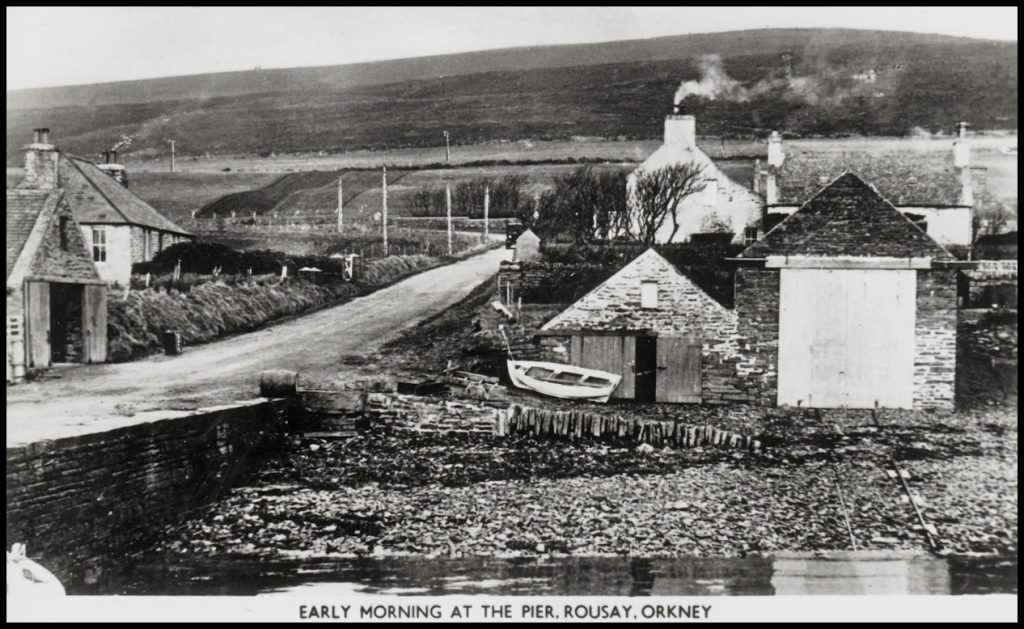
The Brinian is a small district between the Kirk Brae [known today as the ‘Doctor’s Brae’] in the East and the Burn of Trumland to the West. Though now cultivated for the most part it was not skatted, and does not appear in the old Rentals. [Skats were land taxes paid to the Earls or Bishops of Orkney for land tenancy].
The laird, Frederick William Traill-Burroughs, paid for Trumland pier to be built, and building work was completed in 1871 at a cost of £573, though the surrounding area in those days was fairly sparsely populated. The pier was of course built in that location for his own benefit, being very adjacent to the site for his new mansion house and would facilitate the bringing ashore of all the necessary building materials by ship from Kirkwall. Another of Burroughs’ ventures was the founding of the Rousay, Evie and Rendall Steam Navigation Company. The company’s small steamer was the ‘Lizzie Burroughs’, a 61-foot long 31-gross-tonnage vessel with a 15hp engine. She was a familiar sight plying the waters between Rousay and Kirkwall. Her schedule was as follows: Sourin 7.30am; Egilsay 7.45; Trumland 8.00; Wyre 8.15; Hullion 8.45; Evie 9am; Tingwall 9.40; Gairsay 10.00; Rendall Point 10.20 – and then on to Kirkwall.
The company lasted just 13 years and folded due to financial problems, the steamer’s mechanical defects, and even shipwreck. She was out of action for six weeks in 1883 for repairs, and suffered further damage the following year when she broke loose from her moorings and was driven ashore on Egilsay. She was badly holed and had to be towed to Stromness for repairs. In 1892 the company ceased trading and the Lizzie Burroughs was sold to Robert Garden for £484. The Orkney Steam Navigation Company’s vessel Fawn then provided the lifeline service between the isles and Kirkwall.
The reverse of the above photos reveals these are young ladies from Trumland House,
at the Leading [or landing] stone, just east of the pier.
Living in two buildings near the new pier in 1871 were the Marwick and Yorston families. Mary Marwick was a 52-year-old widow, and living with her was her 16-year-old daughter Jessie Alexina, who earned a living as a dressmaker. Mary was the daughter of Hugh Craigie and Mary Yorston of Knappknowes, Westside, and she was born on April 26th 1819. In 1846 she married William Marwick, son of Hugh Marwick and Mary Yorston of Clook, Frotoft, who was born on January 31st 1818. They had three children; William, Peter and Jessie Alexina. William died in 1855 at the age of 37.
Archibald Yorston was a 42-year-old fisherman, living in the Brinian with his wife Ann (44) and children David (14) and Jemima, a 13-year-old scholar. Ann’s widowed mother also lived with them, then in her 81st year. Archibald was the son of John Yorston and Mary Barnet, who lived in Whistlebare, Egilsay. In 1854 he married Ann Leask, who lived with her widowed mother Ann in Hillhouse, Wyre.
In the 1881 census these two dwellings were identified as Brinian Cottage West and Brinian Cottage East – latterly known as Ivy Cottage and Viera View.
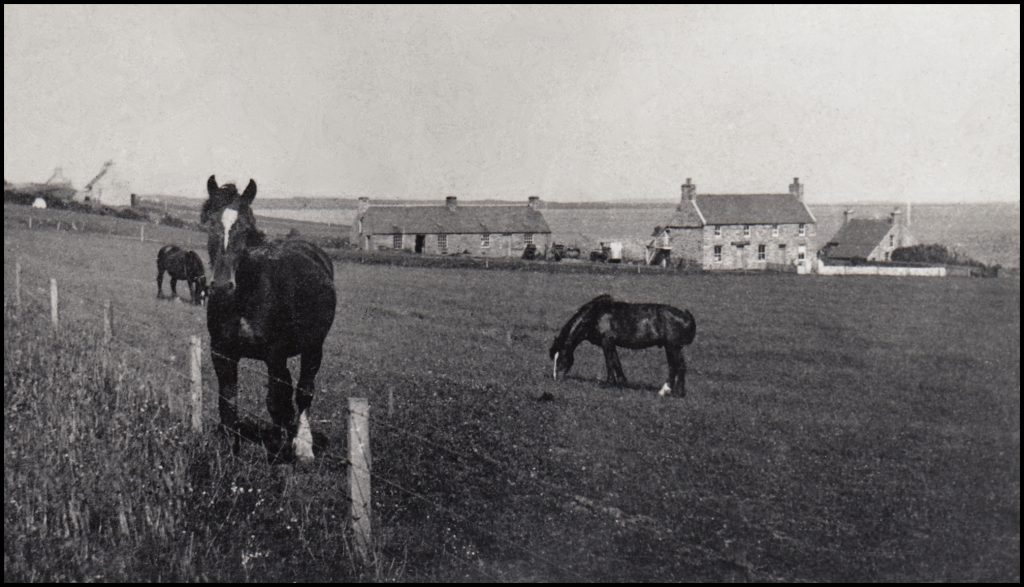
The West cottage was then occupied by agricultural labourer James Low and his wife Mary. James was the son of James Low and Christina Hourston of Quoyjennie, just above Hunclet in Frotoft, and he was born in 1848. In 1880 he married Mary Craigie, the daughter of Gilbert Craigie and Jean Gibson of Turbitail, who was born on August 2nd 1848. They had two children, Mary Jean and James, who later became a gardener at Westness House.
Mary Marwick lived in the East cottage, but now with her son Peter, a 29-year-old farm servant. At that time they had a lodger, 35-year-old John Fraser, who was employed as a road maker foreman.
The census of 1881 contained the first mention of Pier Cottage, built in 1877 especially to house the laird’s yachtmaster John Logie, having the privilege of living there rent-free. He was born at Geo, Westness, in January 1826, the son of John Logie and Mary Craigie of Whome. John married Cecilia Gibson, Vacquoy, and they raised a family of ten children: Mary, who was born in 1855; John, born in 1856; Alexander, in 1858, but died just four years later; William, in 1861; a second Alexander, born in 1863, but he too died at a young age; Annabella, in 1865; Henrietta Williamina [Minna], who was born in 1867, Charles Burroughs, in 1869, Hugh, born in 1872, but dying just eight years later; and James, who was born in 1874 – his mother Cecilia dying at the same time. Her widower husband John married a second time – to Jane Harcus, Blowhigh, daughter of John Harcus and Jean Reid, who was born in 1843. They had three children: twins Alexander and Mary, born in 1878; and Lizzie, who was born in 1883.
Come the census of 1891 the occupants of Brinian No. 1 were David Craigie and his family, paying an annual rent of £4. David earned his living as a joiner. He was the son of Gilbert Craigie and Jean Gibson of Turbitail, born on March 14th 1857. He was the younger brother of Mary Low living at the West cottage. On September 7th 1882 he married 21-year-old Ann Gibson, daughter of John Gibson and Jane Mainland of Knarston. They had four children between 1883 and 1895, Ann dying six days after the birth of their youngest child.
No. 2 was occupied by Isaac Marwick who was a blacksmith in the Brinian. Born on October 28th 1857, he was the son of Robert Marwick and Bell Mainland of Essaquoy. On December 13th 1883, he married Sarah Harrold, daughter of John Harrold and Margaret Mackay of Rendall, and they had two children; Maggie Ann, born on October 2nd 1884, and Robert, born on October 7th 1886.
Isaac served as engineer on the packet Lizzie Burroughs that plied between Rousay and Kirkwall in the 1880s and ‘90s. After that he became engineer on S.S. Hoy Head sailing between Stromness and the south isles. Later he was engineer on the S.S. Southford sailing out of Leith. While leaving Harwich harbour in 1917, the ship hit a mine and sank. All the crew were rescued but Isaac suffered a heart attack and died as a result of sudden immersion in cold water after the heat of the engine room. He was 59 years old when he died.
Two photos, taken ten years apart, of an immaculately-dressed Charles Burroughs Logie,
1890 to the left and the image on the right taken in 1900.
In 1893 John Kirkness occupied No. 1, paying rent of £3 10s 0d. He was employed as an engineer on board General Burroughs’ steam yacht Curlew. A year later John had moved on and a new family were in residence in what was now called Ivy Cottage. Head of the household was Charles Burroughs Logie, a joiner by trade, his family and birthdate of 1869 mentioned previously. His workshop and the Trumland smiddy were under one roof, just up from the pier. In 1896 Charles married Alice Gibson, daughter of David Gibson, Hullion, and Ann Sinclair, Newhouse, who was born in 1871. Charles and Alice had four children: Charles Sinclair, known as Lalla, born in 1903; Harry, born in 1904; Alice, known affectionately as Girlie, was born in 1906; and David John, born in 1908, and he was known as Totto.
At the time of the 1901 census the Logie’s neighbours along at Brinian No. 2, or Viera View as it is more commonly known, was blacksmith William Sutherland and his family. William was from Flotta, and was born in 1869. In 1899 he married Margaret Harrold, the then 37-year-old daughter of Hugh Harrold, Rendall, and Margaret Mainland, Bu, Wyre. They had three children: George, born in 1900; Maggie Simpson [Peggy] born in 1901, who later married George William Marwick [who latterly had a shop at the pier]; and Hugh Harrold, who was born in 1904 and later emigrated to Canada.
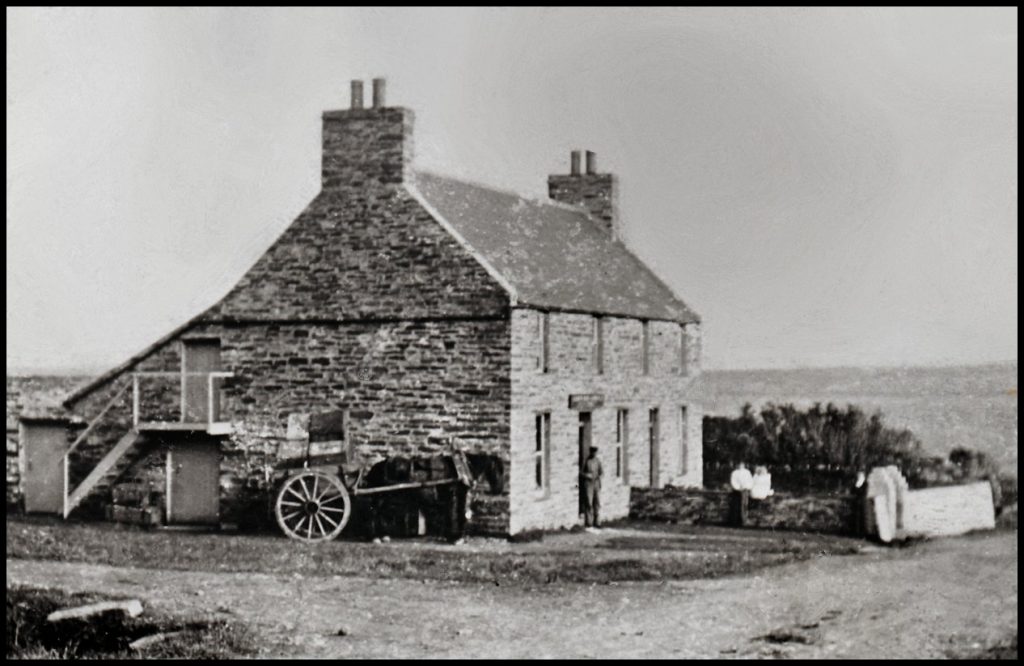
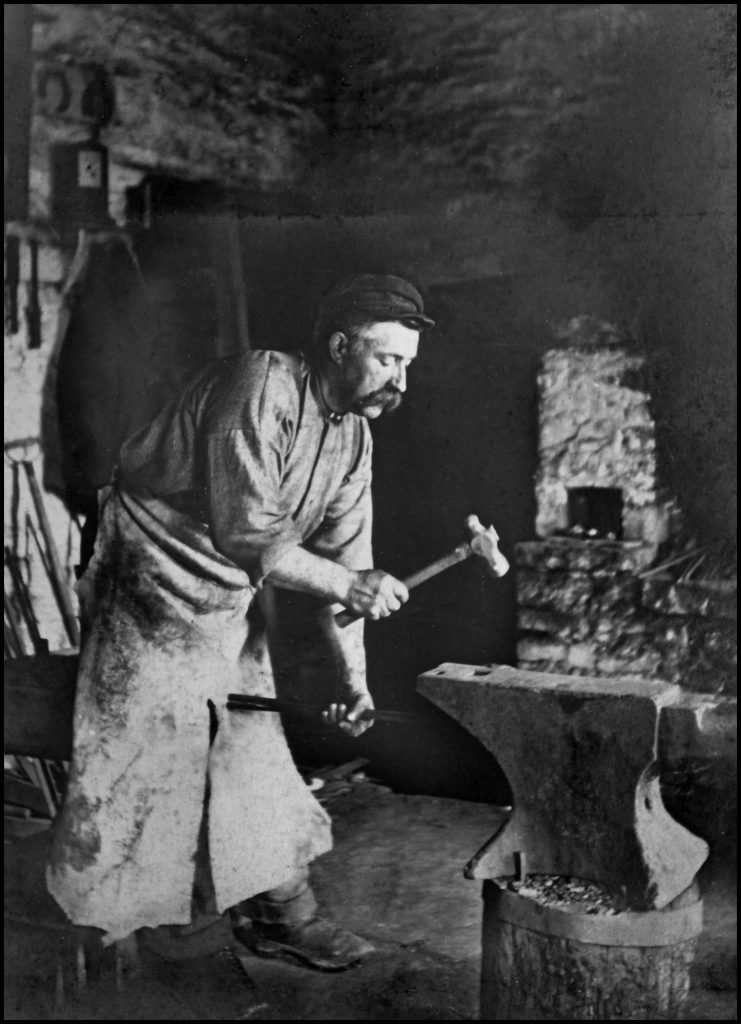
Rose Cottage and Harrold’s Shop, the two-storey building between Pier Cottage and the smiddy and joiner’s workshop, was first mentioned in the census of 1901, with John Mainland Harrold’s shop occupying the left ground floor rooms. Jock was the son of postmaster Hugh Harrold, Rendall, and Margaret Mainland, Bu, Wyre, and he was born in March 1859. On September 29th 1898 he married 27-year-old Esther Longbottom, daughter of Timothy Longbottom, agent for the Prudential Insurance Company, and Anne Powell of Alva, Clackmannanshire, minister Alexander Irvine Pirie performing the ceremony at Rose Cottage. Jock and Esther had two children, Jeannie, born in 1900; and John, who was born in 1904.
In the early 1900s Esther’s younger sister Mary Ann also lived at Rose Cottage, 15-year-old Maggie Jane Corsie was employed as a domestic servant, Samuel Inkster was a 25-year-old van man, and 15-year-old Kenneth McLean was an apprentice merchant in the shop. John Ernest Broadbent was a lodger, and at that time he was a 28-year-old registered general medical practitioner.
Master blacksmith William Sutherland at work at the Trumland smiddy.
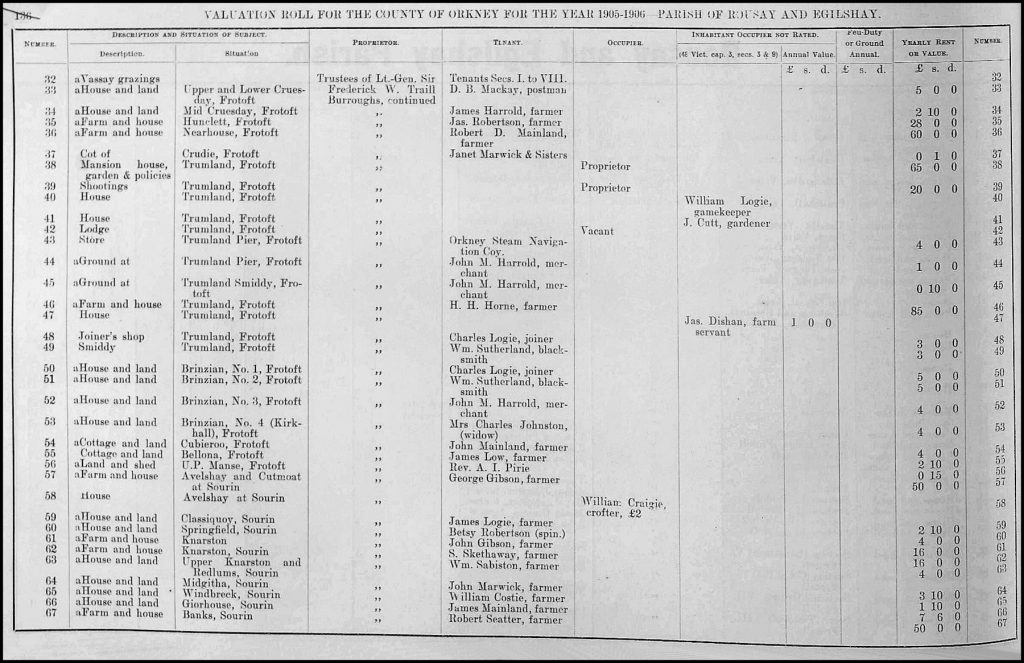
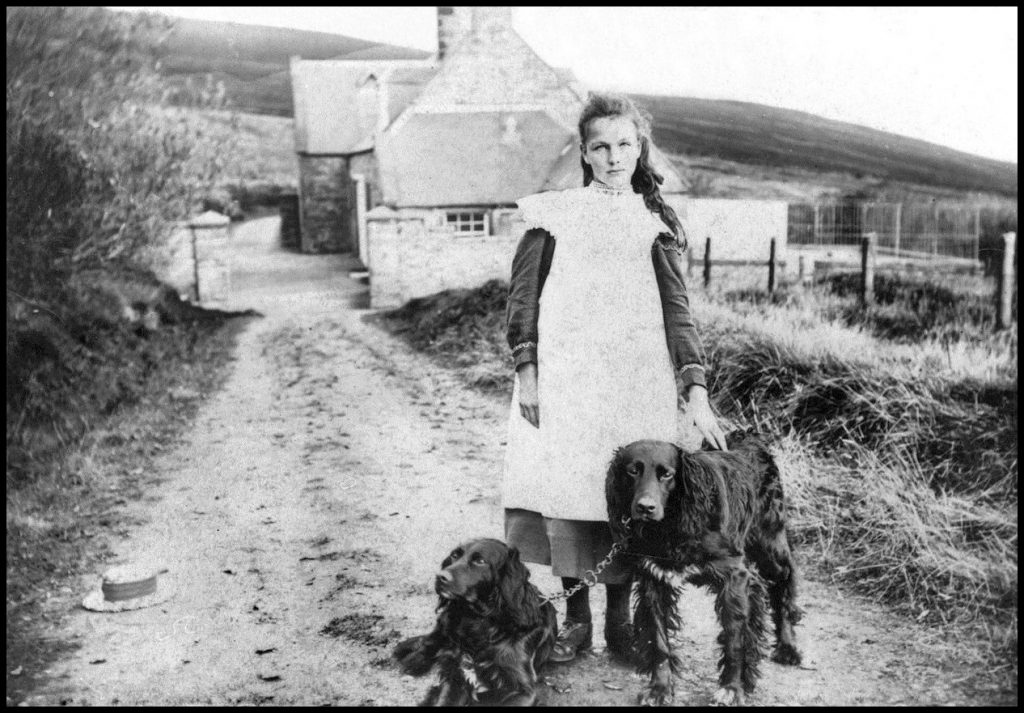
Meanwhile down at Pier Cottage John Logie, his wife Jane, and daughter Lizzie were still in residence, though John was working on the land and not at sea any more. He passed away in 1917 at the age of 91. His son, former Trumland estate gamekeeper William Logie moved into Pier Cottage from the accommodation above the stables at Trumland House. With him were his wife Helen Marwick, daughter Cecilia [known as Cilla] and her son James Marwick Craigie, the result of an illicit liaison with farmer James William Craigie. Young James was nicknamed ‘Steebly’ due to the location of his birth.
Rose Cottage was next to house a new occupant – and he was John Logie, Frederick William Traill-Burroughs’ butler at Trumland House. He was the oldest of the three Logie brothers, being born in 1856. William the gamekeeper was born in 1861, and Charles the joiner in 1869. John was the son of the laird’s yachtsmaster John Logie and his first wife Cecilia Gibson, Vacquoy, and he married Anne Marwick Craigie, daughter of John Craigie, Hullion, and Sarah Sinclair, Tratland, who was born in March 1855. The marriage took place at Hullion on January 26th 1882. Alexander Allardice of the United Presbyterian Church was the officiating minister and the laird, General Frederick William Traill-Burroughs and his wife Lizzie, were witnesses to the occasion.
John Logie’s tasks as butler were numerous. He would wait on the table at mealtimes, look after the silver in the house, do the rounds and lock up at night, care for the wine cellar, clean the knives and the shoes, answer to visitors who called, clean the furniture, and wind the clocks. On a more personal note John would look after his master’s clothes, take letters to and from his master and mistress, and in the latter years of the laird’s life he and his wife Ann would travel with and care for the Burroughs’ at their London residence.
Lizzie Burroughs, the laird’s wife, was a competent artist, a trait inherited from her D’Oyly grandparents. A number of her watercolours of the Rousay landscape used to hang in Trumland House, and she gave lessons and encouragement to any young servant who showed signs of artistic ability. John Logie was a superb artist in his own right, and an accomplished photographer too. Many of his paintings are still in existence today, and I have used a number of his photographs on the pages of this website.
Examples of John Logie’s artwork – Trumland Farm, Wyre and Gairsay [above left]; Westness House and Farm on the right [image courtesy of Ron Spence, Banchory]. Below are views of the Earl’s and Bishop’s Palaces and St Magnus Cathedral, Kirkwall – and Langstane, Frotoft. Images of the paintings are courtesy of Graham Lyon, Sandwick. Graham writes:- “The one of Langstane was a wedding gift to my great grandparents Betsy and John Mainland, dated the year they married [1896]. That of the Cathedral was a wedding gift to my grandparents Robert and Edda Mainland dated on the day of their wedding [1929].”
After the death of Frederick William Traill-Burroughs in 1905, and his wife Lizzie in 1908, John continued in his role as estate steward and caretaker to the executors of the Trumland estate. It was in this capacity he wrote a letter of reference for Thomas Marwick, who was forced to move south due to the state of his wife Emily’s health. The letter, written on Rose Cottage embossed notepaper, reads as follows:-
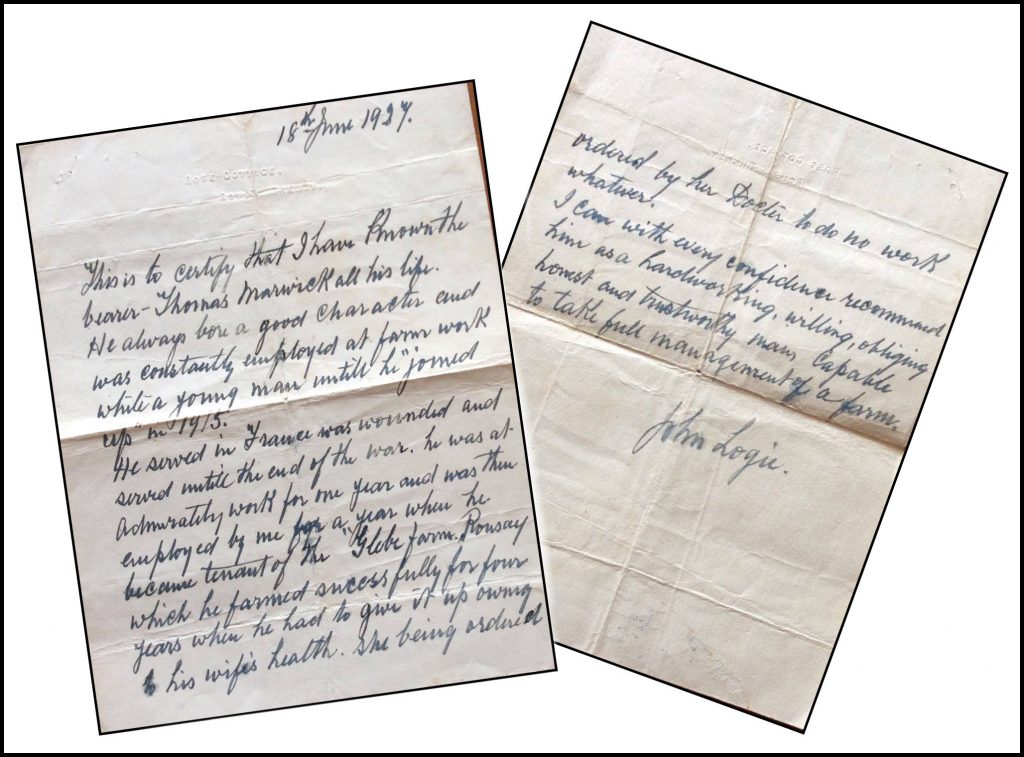
18th June 1927.
This is to certify that I have known the bearer – Thomas Marwick all his life. He always bore a good character and was constantly employed at farm work while a young man until he “joined up” in 1915.
He served in France, was wounded and served until the end of the war. He was at Admiralty work for one year and was then employed by me for a year when he became tenant of the Glebe farm, Rousay, which he farmed successfully for four years when he had to give it up owing to his wife’s health. She being ordered by her doctor to do no work whatever.
I can with every confidence recommend him as a hardworking, willing, obliging, honest and trustworthy man, capable to take full management of a farm.
John Logie.
I have already mentioned Maggie Simpson Sutherland [Peggy], daughter of William Sutherland, master blacksmith at Rousay pier. On November 22nd 1922 she married George William Marwick, known to everyone as Willie. He was the son of William Marwick, Corse, and Annie Taylor. William was a gardener at Westness House when in the ownership of Thomas Middlemore, who left Rousay in 1898 for Melsetter in Hoy. There William was employed as the estate steward, and it was that address that was used on 25-year-old Willie Marwick’s marriage certificate. His profession was that of a shepherd, and his bride Peggy was a 22-year-old cook. The proceedings were witnessed by Peggy’s brother George and Willie’s sister Edith, and the Rev David Simpson Brown of the United Free Church was the officiating minister.
In his book In Dreams We Moor, Robert Craigie Marwick tells us that in his childhood the shop at the pier [pictured below], located between the smiddy and what is now Brinola, belonged to Willie Marwick. He had a horse-drawn van which he took round the island once a week. Willie always seemed to want to move faster than the horse’s measured pace, giving the impression that he was dragging the animal along rather than leading it.
Shortly after the war Willie bought a car so that he could run a taxi service. One day a farmer who had shipped some cattle hired Willie to drive him home from the pier. A few days earlier Willie had had the misfortune to capsize his boat while out sailing. This gave the farmer an irresistible opportunity to have a little fun at Willie’s expense and as he climbed into the car he said to Willie that he hoped he was better at driving a car than he was at sailing a boat. These were the last words he was to utter until he had been set down at his farm on the other side of the island after the most hair-raising car journey he had ever endured. Never again, he vowed to himself, never again. Willie had scared the wits out of him with a display of devil-may-care driving at a breakneck speed that had broken every rule in the Highway Code. As his passenger staggered from the car Willie smiled to himself and drove off at his usual sedate pace.
Robert continues:- Standing cheek by jowl with Willie Marwick’s grocery shop were Charlie Logie’s joiner shop and the adjoining smithy of William Sutherland. The joiner and the blacksmith were great friends but this did not stand in the way of either one having some fun at the other’s expense whenever the opportunity arose. One day Charlie happened to look out of his window and spotted the minister, with a determined look on his face, heading in his direction. Charlie suddenly remembered that, six weeks earlier, he had promised the minister that he would attend right away to the repair of some broken windows at the manse. He had no excuses to offer the minister so he slipped out the back way and into the smithy next door. He quickly explained his predicament to his friend and asked if there was anywhere lie could hide till the coast was clear. The blacksmith suggested that Charlie could climb into the rafters where the minister was unlikely to spot him in the poor light. Charlie followed the suggested course of action and was crouched on a rafter like a hen on its perch when the minister entered the smithy. ‘I’m looking for Mr Logie’, he announced, ‘but he’s not in his workshop. Do you happen to know where I might find him?’ `Oh, yes’, replied the blacksmith cheerily, ‘he’s sitting up there in the rafters.’
A final mention of Willie Marwick comes from the wit and genius of Geordie Corrigall – the Bard of Ballarat. Here is a verse from one of his compositions entitled ‘Rousay Millionaires’.
And yi a’ ken Willie Marwick, he’s a most terrific wag,
His shop’s doon at Brinian whar the steamer dumps hids slag,
He’s aye prepared tae tak ye roond the island in his ker,
And his yarns’ll had yi laughan till yir very sides are sair.
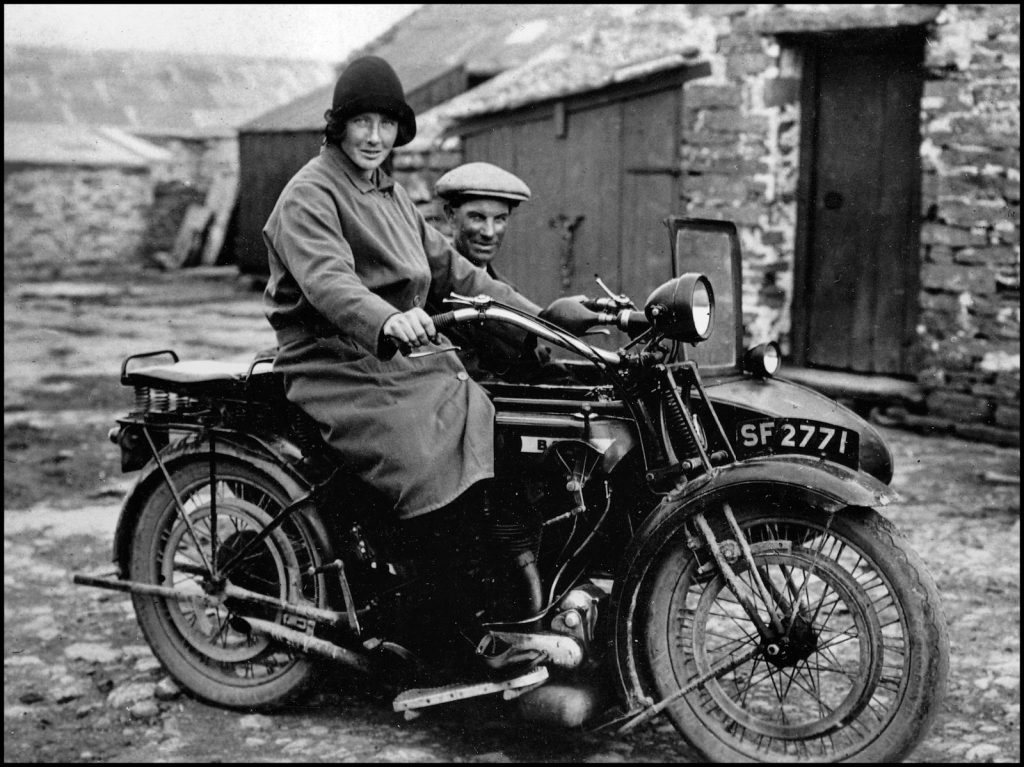
A house named Rognvaldsay was built in the mid-1930s, on the left just up from the pier storehouse. It was first occupied by James Thomas Reid Marwick and his wife Edith Gibson. James was the son of Mary Mainland Marwick, Midgar [no father on record] and he was born in December 1888. He married Edith, daughter of George Gibson and Annabella Logie of Avalshay, who was born in 1902. Edie was one of the first women in Rousay to own a motorcycle. Here she is on her 500cc BSA S26, with James in the sidecar. They were later occupants of Rognvaldsay.
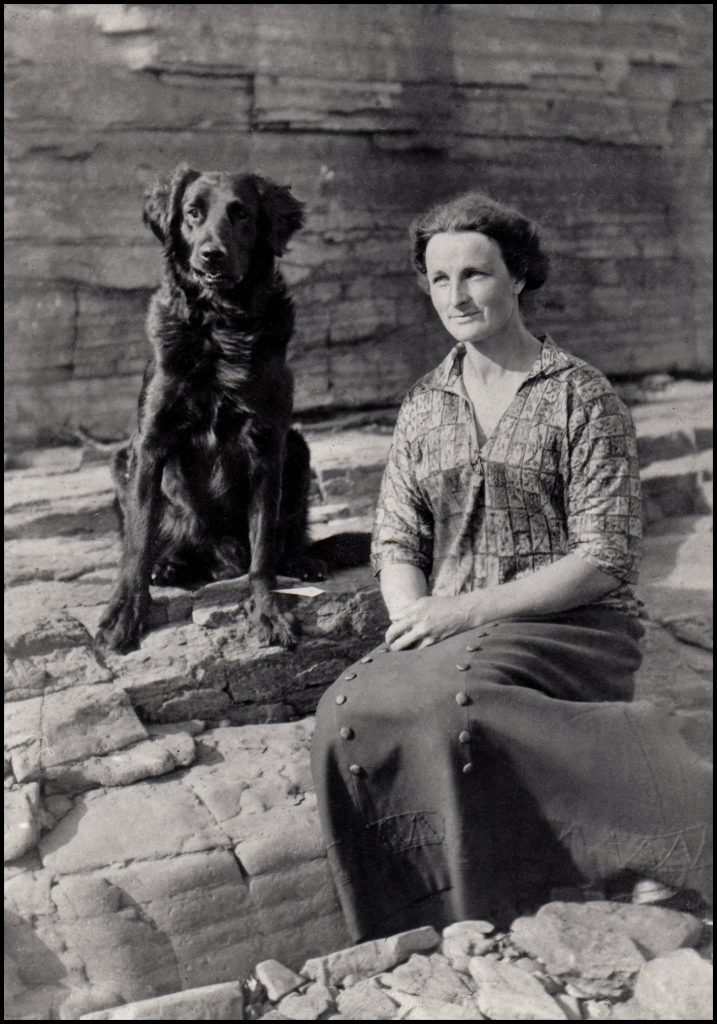
I never met Cilla Logie [pictured to the right on the shore with her dog c.1930] – but I encountered her son when I first came to Rousay in 1975. James Marwick Craigie was born above the Trumland House stables at noon on August 29th 1908, resulting in his nickname ‘Steebly’. He earned his living at the fishing, and later as a gardener at Trumland House. In 1958 James married Margaret Gibson Corsie (Peggy) of the Glebe, daughter of William Simpson Corsie and Lydia Gibson Baikie. Unfortunately Peggy was just 33 years of age when she died in 1964. James married again in 1975; his bride was Williamina McKenzie Flaws, daughter of Magnus and Williamina Flaws of Wyre, who was born in 1911. They ran a shop alongside Pier Cottage, and that is where I met and took the photo of them both in 1975.
Cilla passed away in 1983, James and Mina both died in 1988
Moving away from the pier, along the road beyond Ivy Cottage and Viera View, we come to Brinian Cot No. 3, later called Daisy Cottage. Its first occupant was Charlie Johnston, a ploughman at Trumland Farm, and in 1886/87 he was paying annual rent of £5.0.0. Charlie was married to Ann Harrold, and they and their six children later moved to nearby Cott.
Later tenants were John and Mary Cutt. They moved from the accommodation above the stables at Trumland House, where Orphir-born John was employed as a domestic gardener. His wife was Mary Craigie, daughter of shoemaker William Craigie of Lero, and Martha Mainland, Avalshay, who was born in August 1862.
Cott, or Cott Mowat as it was originally known, stood near the shore on what is now part of the land of Avalshay, a short distance west of the UP manse [now Brinian House] and the Established and United Presbyterian churches, and below Kirkha’. The old rentals reveal the earliest occupants as being James Linard in 1737, William Gairstie in 1769, and James Gairstie in 1771. In the early 1800’s it was where farmer Alexander Mainland and his family lived. He was married to Mary Cooper, the daughter of William Cooper and Cecilia Corsie, who was born in 1793. They had five children, William, Mary, Janet, Ann, and Betsy Scott, born between 1823 and 1831.
Alexander died in 1856 at the age of 86, and Mary died at Faro in 1877 when she was 84 years of age.
In 1861, Cott, by which name it was then known, was occupied by 31-year-old fisherman Archibald Yorston and his family. He was the son of John Yorston and Mary Barnet and he was born at South Tofts, Egilsay. He married Ann Craigie and they had three children, David, Jemima, and Margaret.
Cott was unoccupied in 1871, but ten years later William Marwick was farming four acres of land there. He was the son of Robert Marwick and Bell Mainland and was born on February 22nd 1847. On May 30th 1871 he married Sarah Leonard, daughter of James Leonard and Cecilia Inkster of Quoygray, who was born on October 20th 1847. They had six children; Bella, John, Betsy Ann, Williamina, Maggie, and Sarah, born between 1872 and 1882.
In 1891, 46-year-old farm servant Charles Johnston and his family lived at Cott. He was the son of John Johnston and Betsy Reid of the Brinian, born on July 24th 1844. In 1870, when he was living at nearby Kirkha’ he married Ann Harrold, the daughter of James Harrold and Bella Gibson of Boray, Gairsay, who was born on September 26th 1848, and they raised a family of four children: Margaret, born in 1871; Isabella Harrold, in 1873; John, born in 1877; Jemima, in 1879.
Kirkha’ was a croft close to the Established and United Presbyterian churches and the U.P. manse, now known as Brinian House. When the census was carried out in 1841, 75-year-old farmer William Reid from Stanecrew, Egilsay, lived there with his wife and family.
Originally he was married to Barbara Alexander, and they had a son, Archibald, who was born on August 21st 1805. William then married Christian Mowat and they had three children; Mary, born on May 9th 1810; Janet, on July 23rd 1812; and William, who was born at Pow, Sourin, on January 17th 1816.
By 1851 William had died, and his widow Christie, then a 74-year-old pauper, lived at Little Kirkha’. Agricultural labourer James Robertson and his family lived next door at Kirkha’ itself. James was the son of Alexander Robertson and Margaret Irvine, and he was born on April 6th 1818 on the island of Egilsay. At this time he and his wife Mary had two children; James, born in 1845, and Mary in 1847.
Widow Christy Mowat was still alive and living at Little Kirkha’ at the start of the 1860’s, but 49-year-old fisherman John Johnston had taken over the tenancy of Kirkha’. He was the son of Charles Johnston and Janet Harrold, and he married Elizabeth Reid, the daughter of George Reid and Barbara Logie of Pow, Westside, who was born in 1815. Between 1842 and 1857 they raised a family of nine children – six boys and three girls.
By 1871 Christy Mowat had passed away, and John and Elizabeth Johnston had been joined at Kirkha’ by their son Charles and his family. He was born on July 24th 1844, and like his father earned a living as a fisherman. In 1870 he married Ann Harrold, daughter of James Harrold and Bella Gibson of Boray, Gairsay, who was born in September 1848. At this time they had a three-month-old daughter, Maggie Ann, but they went on to have a family of four children.
Within ten years Charles was employed as a farm servant, and he and his family were living at Trumland. His father John still lived at Kirkha’, but was now farming four acres of ground there. Later, by 1891, when Charles was 46 years of age, he and his family had moved into Cott, close to Kirkha’, where his parents, John and Betsy still lived with their unmarried 39-year-old daughter Jane.
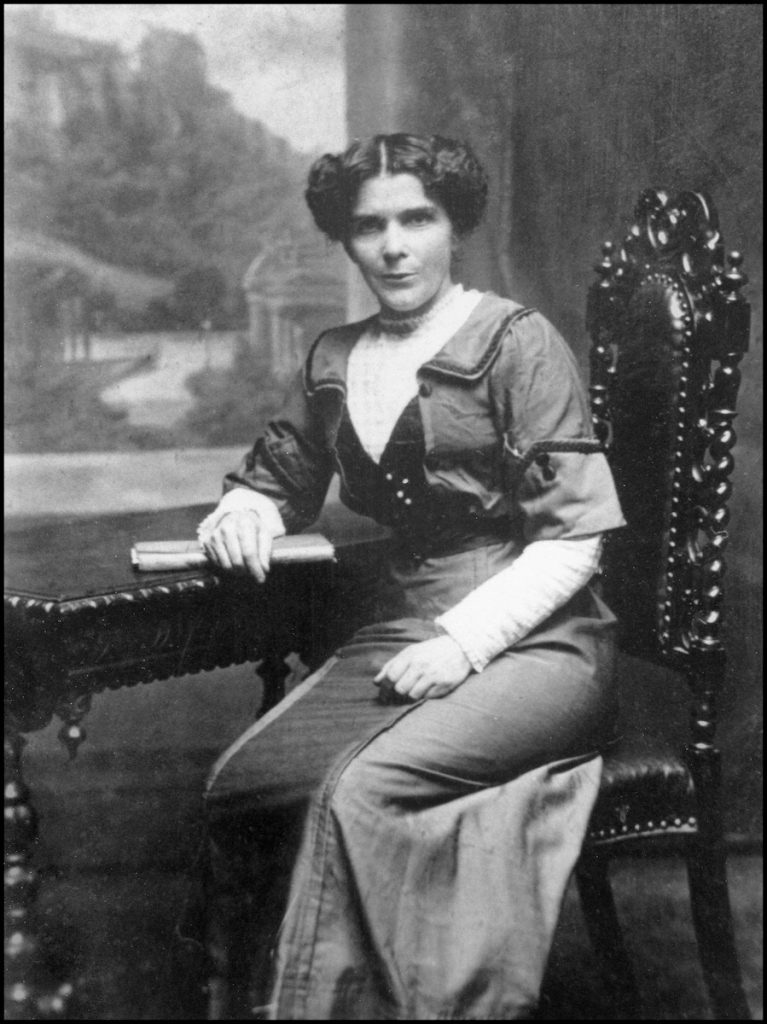
Later occupants of Kirkha’ were Sammy Inkster and his wife Maggie. Samuel Craigie Inkster was the son of James Inkster, Gorn later Scar, and Jane Inkster, Innister, and he was born in 1876. He married Jemima Johnston, daughter of Charles Johnston and Ann Harrold, but she passed away in 1924. On March 5th 1926 he married Maggie Jessie Louttit, pictured to the right] a 48-year-old cook from Maybank, Wasbister, the daughter of shoemaker William Louttit, Maybank, and Margaret Gibson, Broland. Maggie Jessie was born in 1877, and passed away at Kirkha’ in 1947. Sammy, seen below on various modes of transport, passed away in 1953.
The United Presbyterian Church and manse, pictured below, were situated east of Kirkha’. In the mid-1800’s the house was occupied by 45-year-old minister John McLellan, from Newton Stewart, Dumfries & Galloway, his 34-year-old wife Jane from Barrhead, East Renfrewshire and their three children Jemima, John, and William. The census of 1861 reveals 19-year-old Elizabeth Reid was employed as a domestic servant, and a border occupied one of the rooms at the manse – William H. Hankay, an unmarried 32-year-old gentleman from England.
In 1881 Alexander Allardice, a 36-year-old minister from Montrose, lived at the Manse, but by 1891 a new minister was in residence – 45-year-old Alexander Irvine Pirie from Drumoak, Aberdeenshire. He was married to 39-year-old Elsie Jamieson from Newburgh, Aberdeenshire, and they had three sons, Alexander Irvine, Alfred James, and John William. Come the time of the 1901 census being carried out Elsie’s 83-year-old widowed mother Margaret Jamieson was living with the Pirie family; Mary Mainland Marwick was their 42-year-old domestic servant, and George McLeod Lindores was a visiting piano tuner from Edinburgh.
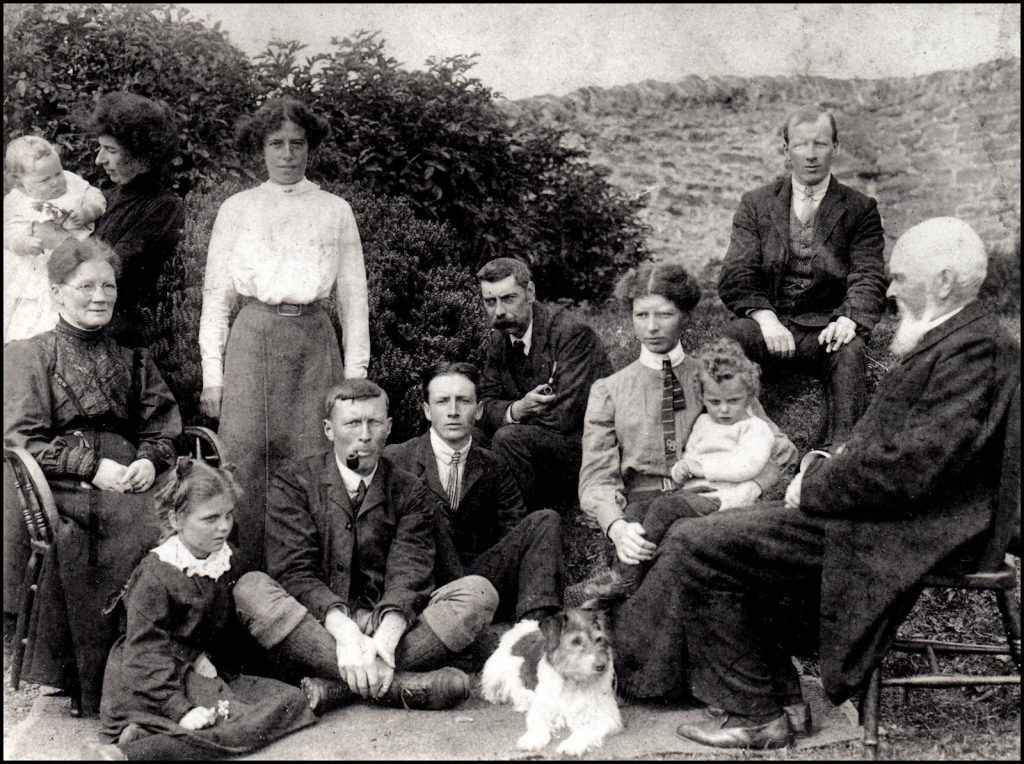
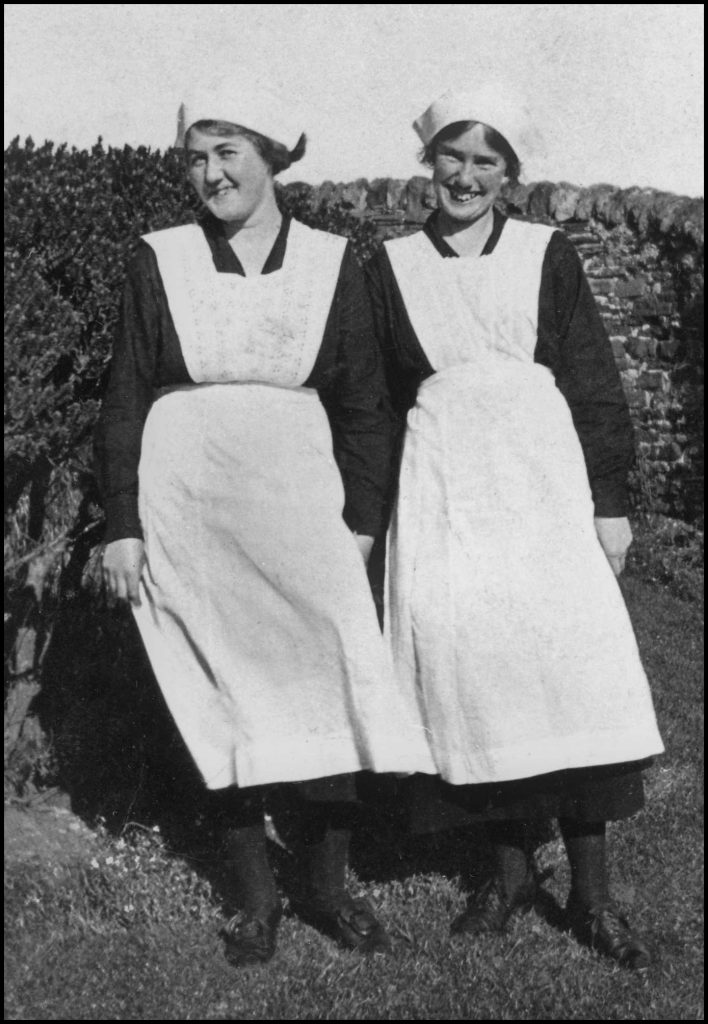
[All photographs are, unless otherwise stated, courtesy of the Tommy Gibson Collection.]
UNVEILING OF ROUSAY WAR MEMORIAL
Sunday July 3rd 1921
[From the columns of The Orkney Herald, Wednesday July 6th 1921]

On Sunday last, a very large gathering of people convened at the Parish Church of Rousay for the unveiling of the war memorial. The War Committee, knowing that the young men whose names are on the memorial scroll had grown up around Mr [Alexander Irvine] Pirie during his long ministry in the islands, and taking advantage of his visitation to Rousay, asked him and Mrs Pirie to perform the unveiling. The Kirkwall Pipe Band, under Conductor Forsyth, were present. The service commenced in the Parish Church. The Rev. D. S. Brown and Mr Shepherd read the Scripture lessons, Mr Pirie led in prayer, and Rev. John Williamson preached, taking as his text Galatians vi. 14. [‘But God forbid that I should glory, save in the Cross of Our Lord Jesus Christ, by whom the world is crucified unto me, and I unto the world’]. The Dead March in “Saul” was played on the organ by Miss [Janet] Longbotham at the close of the church service. The large congregation was marshalled on the road at the church door, with the ex-service men in front, and, under the leadership of the Pipe Band, marched to the memorial near to the Trumland pier.
The bereaved and relatives were accommodated inside the enclosure along with the band and the ex-service men. The proceedings commenced with the singing of the 100th Psalm, led by Mr Hugh Gibson, precentor of the Parish Church. Mr Williamson read the Scripture lesson from Revelation vii., Mr Pirie read the names of the fallen inscribed on the memorial, and Mrs [Elsie] Pirie unveiled the memorial. Mr Brown led in the prayer of dedication.
Mr Pirie, [the bearded gentleman in the centre of the photograph, above right] in his address, said that he stood amongst them on that solemn occasion with very mixed feelings. He was thankful that he was able to be with them, and had been invited by the Committee to take part in that service. He felt deep regret that so many of their heroic young boys had fallen in the war, and he felt much sympathy with the bereaved parents and relatives. Before the war they were living calm, peaceful lives never thinking of what was in front of them. Some men of vision, like Lord Roberts and the late Sir Frederick Traill Burroughs, kept telling them of the danger that was threatening; but they continued to live in peace, thinking no evil, until the storm cloud burst upon them. Mr Pirie then proceeded to speak of the intentions of Germany, of the remarkable unity of all classes in the British Empire, the great heroism of the men who went forth to meet the enemy, and the courage and determination of the men and women who remained at home. Proceeding to speak of the victory gained, the preservation of our liberty, and our nationhood, he touched upon the great cost of lives and wealth and the long struggle during the war, and which would continue still for many years in repairing the awful destruction made by the war. He hoped the abiding memorial to these great and costly sacrifices would be the building in concord and brotherly good-will of a better country for all to Iive in. He closed by expressing his deep sympathy with the men who had come back from the war maimed and broken in body and mind and his sincere sympathy with the relatives of those boys who would never return.
The Pipe Band then played “The Flowers of the Forest,” [the moving ancient Scottish folk tune commemorating the defeat of the Scottish army of James IV at the Battle of Flodden in September 1513], and the bugler sounded the “Last Post.” [In military tradition, the Last Post is the bugle call that signifies the end of the day’s activities – and also sounded at military funerals to indicate that the soldier has gone to his final rest.] The singing of the National Anthem closed one of the largest and most impressive services Rousay had ever witnessed.
The Memorial stands in a clump of trees near the Trumland Pier. It is a Celtic cross of granite, artistically cut and polished, rising some twenty feet from its pedestal. The cross is in Aberdeen granite, but the scroll on which the names are inscribed is of Peterhead granite, inserted at the foot of the cross. The ground around has been neatly surrounded with a stone wall and iron railing, with concrete steps and walk around the Memorial. We understand the plantation of trees and ground within the enclosing wall have been gifted for the purpose by the Rousay Estate Trustees…..

The newspaper report then revealed the names of the men inscribed on the memorial, their ranks, where they lived in Rousay, Egilsay and Wyre, and their ages when they fell. Since then another four names have been added – commemorating those islanders who lost their lives during WWII. The information has since been corrected and updated, and is reproduced below:

1914–1918
Capt. A. GRAHAM SPARK, M.C. Manse, 9th K.O.Y.L.I., 9th April 1917, age 28.
Pte. JAMES BEWS Maeness, Egilshay, 2nd Seaforths, 6th May 1917, age 20.
Pte. GEORGE CRAIGIE Triblo, 74th Battalion, Machine Gun Corps, 21st September 1918, age 19.
Pte. JOHN CRAIGIE Bu, Viera, 1/4th Seaforths, between 23rd and 24th April 1917, age 30.
Pte. JOHN CRAIGIE Ploverhall, 14th (Labour) Cameronians, 1st May 1917, age 27.
Pte. DAVID FLAWS Hammerfield, 2nd Seaforths, 11th April 1917, age 20.
L/Cpl. ALFRED GIBSON Langskaill, 7th Seaforths, 12th October 1916, age 40.
Pte. ALFRED G. GIBSON Avelshay, 130th Field Company, R.E., 16th February 1916, age 21.
Pte. HUGH GIBSON Oldman, 7th Seaforths, 2nd May 1918, age 18.
Pte. JOHN DAVID GRIEVE Falldown, 1/4th Seaforths, 20th November 1917, age 28.
L/Cpl. GEORGE INKSTER, D.C.M. Knapper, Princess Patricia’s C.L.I., C.E.F., 17th July 1916, age 35.
Pte. JOHN A.M. INKSTER Essaquoy, 4th (Reserve) Seaforths, 1st July 1918, age 18.
Pte. JOHN LOGIE Grindlesbreck, 1/6th Gordons, 22nd November 1916, age 36.
Engr. ISAAC MARWICK Essaquoy, M.M., S.S. Southford, 25th February 1916, age 59.
Pte. JOHN H. MARWICK Quoys, 58th Battalion, Machine Gun Corps, 7th September 1918, age 21.
Pte. DAVID MUNRO Old School, 15th H.L.I., 17th March 1916, age 28.
Pte. HARRY REID Brough, 3rd Seaforths, 14th May 1917, age 23.
Pte. EDWARD SEATTER Banks, 8th/10th Gordons, 21st April 1917, age 19.
1939–1945
Sjt. JOHN S. GIBSON Hullion, 2nd Seaforths, 11th September 1944, age 25.
Signalman THOMAS WALLS Store Cottage, 18th Division Signals, 6th July 1945, age 25.
L.A.M. JAMES S. MAINLAND Weyland, Fleet Air Arm, HMS Dasher, 27th March 1943, age 24.
Sgt. Pilot ROBERT M. MAINLAND Essaquoy, 605 Squadron RAF, 25th April 1940, age 23.

Now follows a potted biography of each man, the information provided by Brian Budge, war historian of the Kirkwall Branch of the Royal British Legion. The corresponding photographs of the men are all from the Tommy Gibson Collection, as are those of the unveiling itself.
WORLD WAR I
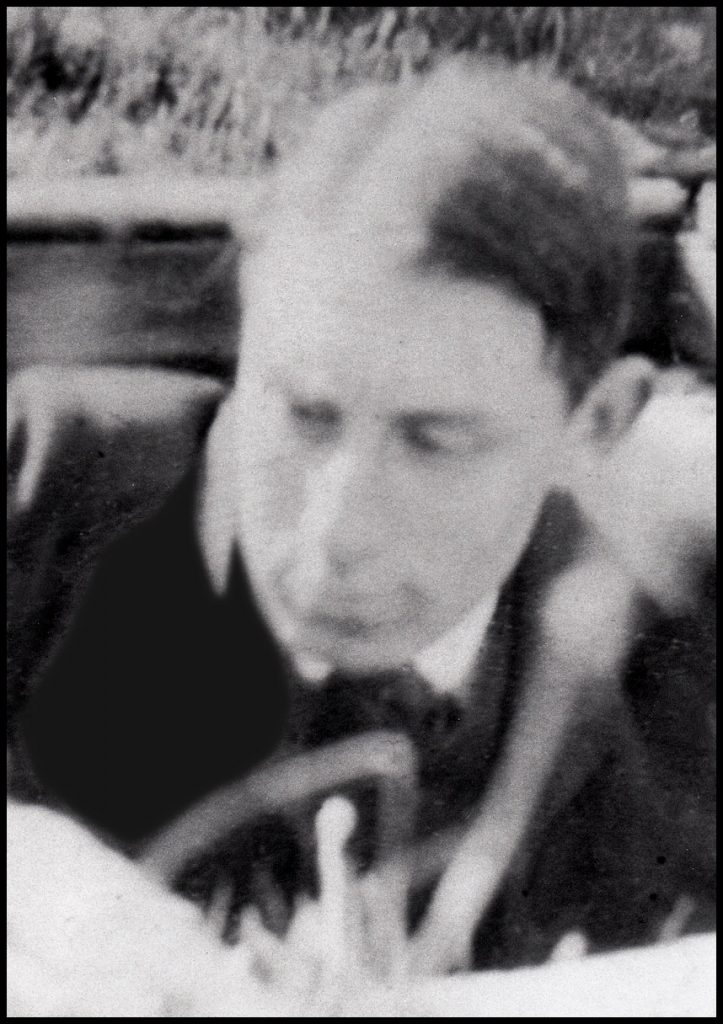
Captain Archibald Graham Spark, M.C.
9th King’s Own Yorkshire Light Infantry, killed in action near Hénin on 9th April 1917, aged 28.
Buried in Grave D.3, Cojeul British Cemetery, St. Martin-sur-Cojeul, Pas de Calais, France.
Born in Kirkwall on 14th June 1888, son of the Rev. Alexander Spark and Jane Livingstone Spark (née Oatt). The Orcadian reported his death in its “OUR ROLL OF HONOUR” section: “Captain A. Graham Spark, King’s Own Yorkshire Light Infantry, who has been killed in action was the third son of the Rev. Alex. Spark, parish minister (retired) of Rousay and Egilshay. He was trained for the legal profession in Kirkwall and Edinburgh, and held appointments with the Straits Trading Company, and also in Edmonton, Canada. He joined the K.O.Y.L.I. as a second lieutenant, and had been at the front since September 1915. For more than a year he was adjutant of his battalion, and had subsequently been selected for a staff appointment. He had been several times mentioned in dispatches.” Graham Spark was dead when the award of his Military Cross was announced in the 1917 King’s Birthday Honours List (see Sixth Supplement to The London Gazette of 1st June 1917).
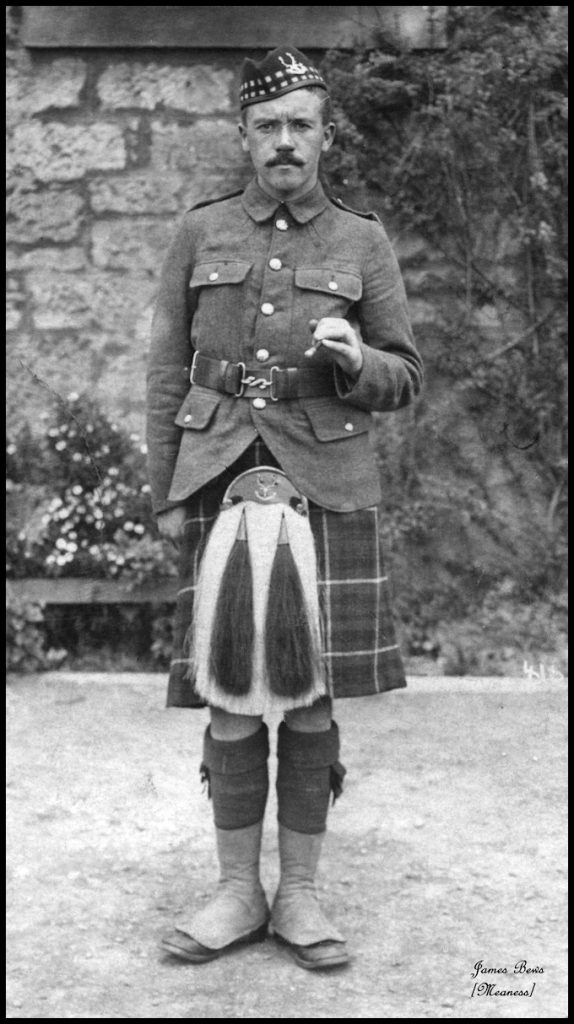
S/14935 Private James Bews
2nd Seaforths, died of wounds as a prisoner of war on 6th May 1917, aged 19.
Buried in Grave XIII.E.5, Cabaret-Rouge British Cemetery, Souchez, Pas de Calais, France.
Born at Whiteclett, Egilsay on 28th May 1896, son of James Bews and Robina Bews (née Grieve). James was a farm worker before he enlisted in Kirkwall. He was reported missing after 2nd Seaforth’s attack at Roeux on 11th April, had been wounded and taken prisoner. James probably died in a German field hospital in France nearly a month later (but not in Germany, as reported soon after in The Orcadian).
[Photo credit: The Bews family]
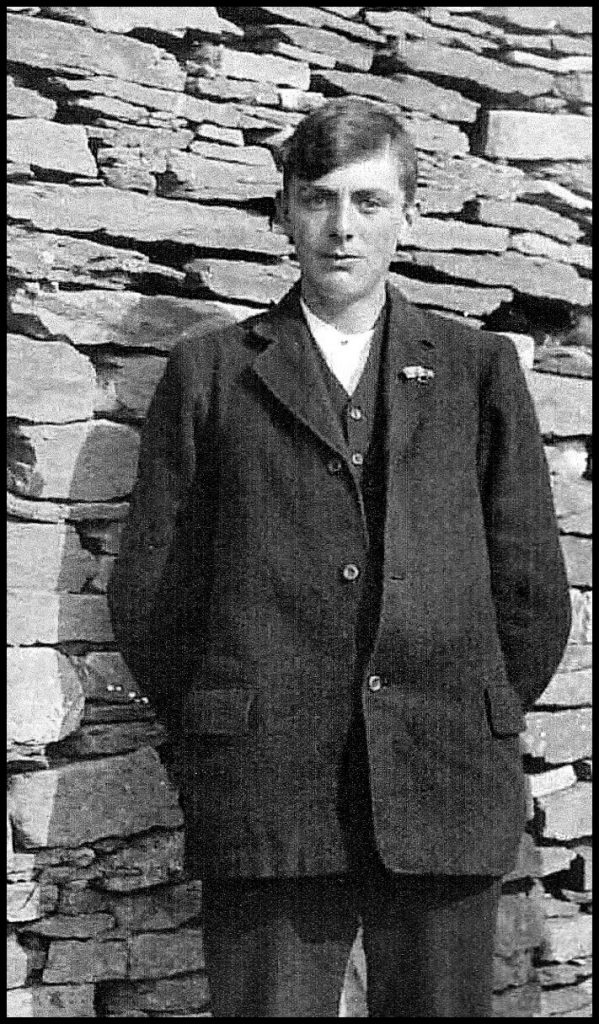
127655 Private George Craigie
74th Battalion, Machine Gun Corps, formerly S/22871 Black Watch, killed in action at the Quadrilateral, near Ronssoy on 21st September 1918, aged 19.
Buried in Grave I.AA.6, Unicorn Cemetery, Vend’huile, Aisne, France.
Born at Triblo, Sourin, Rousay on 23rd November 1898, son of John Craigie and Betsy Craigie (née Leonard). Before he enlisted in Kirkwall, George worked with his father at the Sourin Mill. The family was particularly badly affected by World War I, losing not only a son, but also a grandson, Hugh Gibson of Oldman, and a nephew, John Marwick of Quoys.
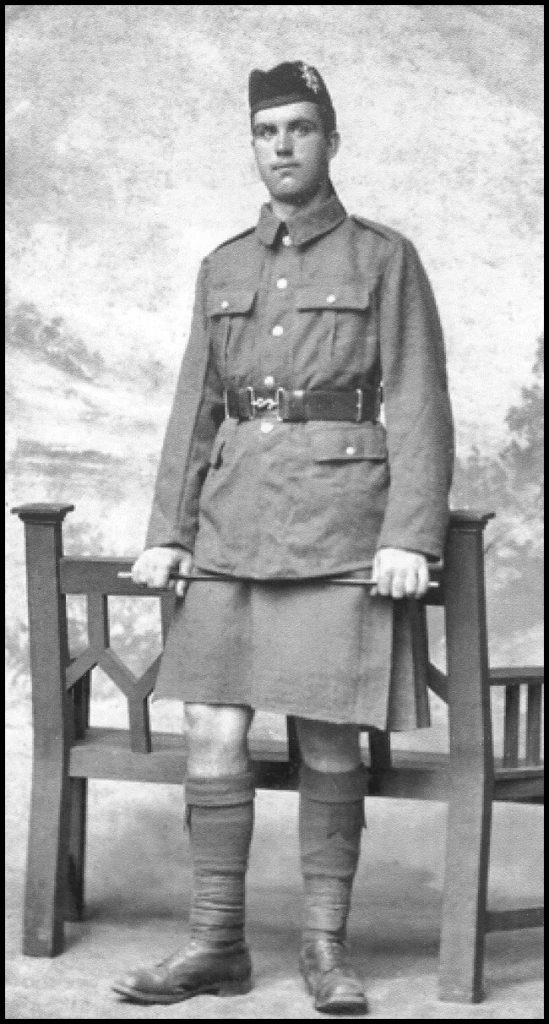
202650 Private John Craigie
1/4th Seaforths, killed in action at Roeux between 23rd and 24th April 1917, aged 30.
Commemorated in Bay 8, Arras Memorial, Pas de Calais, France.
Born at Breckan, Wasbister, Rousay on 25th March 1887, son of Samuel Craigie and Ann Craigie (née Craigie). Before he enlisted in Kirkwall, John worked on the family farm, at Bu on Wyre.
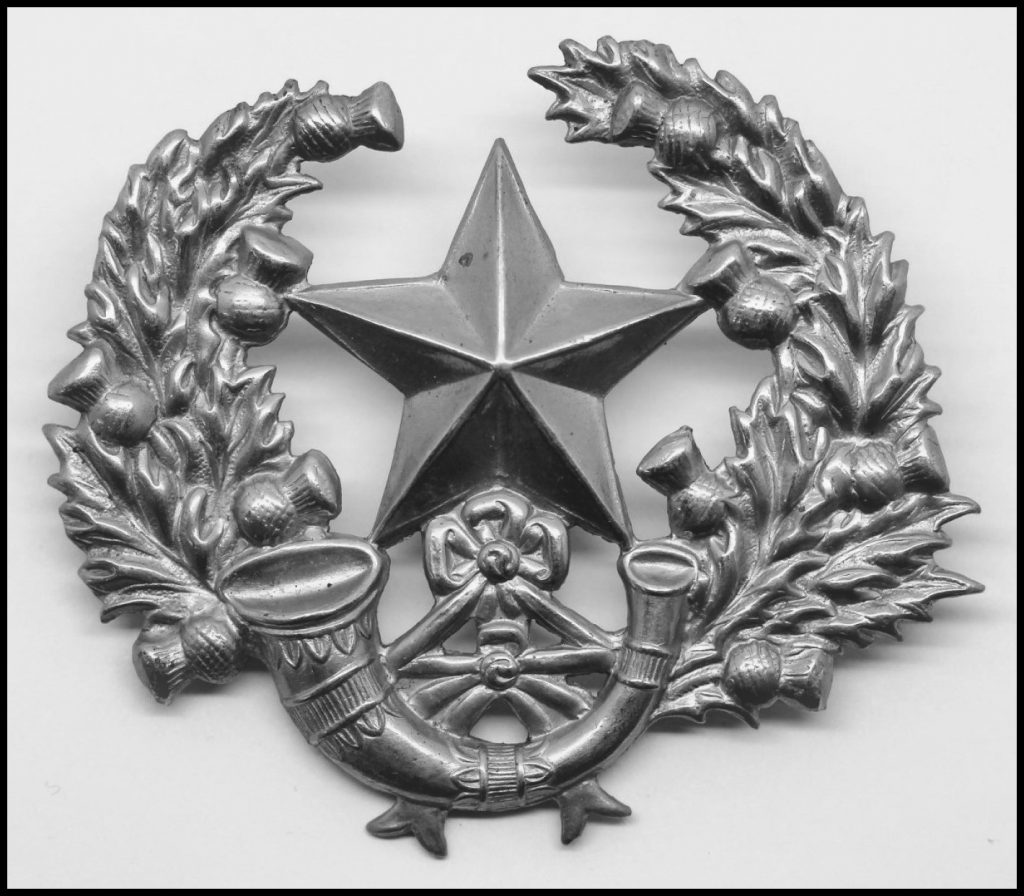
18963 Private John Craigie
14th (Labour) Cameronians (Scottish Rifles), died of tuberculosis in Edinburgh Royal Infirmary on 1st May 1917, aged 27.
Buried in Grave D.20, Comely Bank Cemetery, Edinburgh, Scotland.
Born at Claybank, Rousay on 18th February 1890, son of Magnus Craigie and Ellen Craigie (née Cooper). Before he enlisted, John was a farm worker at Cogar.
[As no image of John Craigie is available I have used a photo of his regiment’s cap badge]
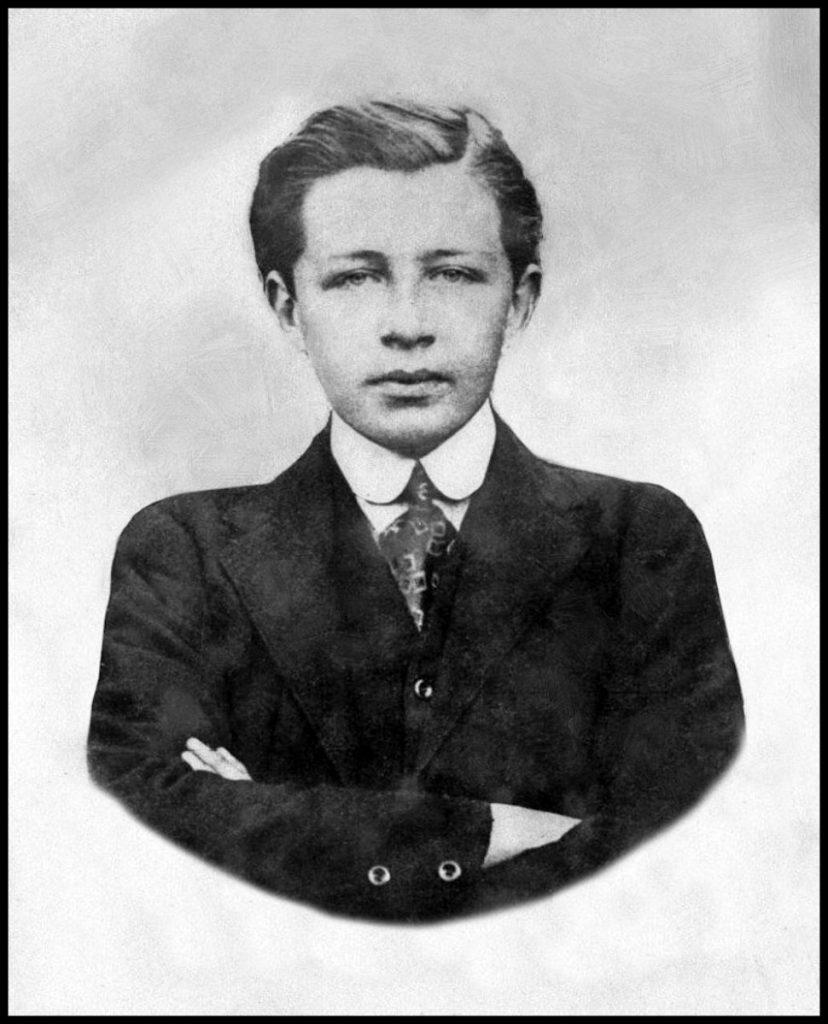
S/12631 Private David Flaws
2nd Seaforths, killed in action at Roeux on 11th April 1917, aged 20.
Buried in Grave J.30, Athies Communal Cemetery Extension, Pas de Calais, France.
Born at Hammerfield, Rousay on 17th March 1897, son of James Flaws and Mary Flaws (née Marwick). He was one of seven Orcadians who died as a result of 2nd Seaforth’s disastrous attack at Roeux on 11th April.
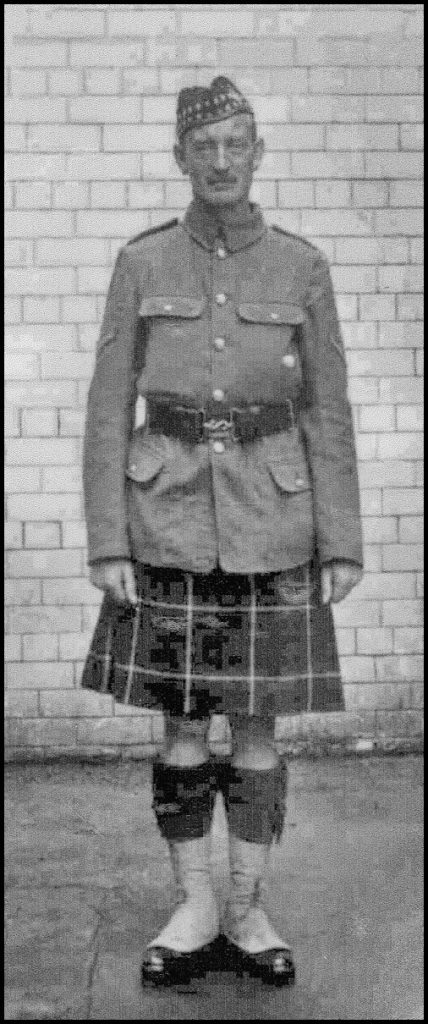
S/12881 Lance Corporal Alfred Gibson
7th Seaforths, killed in action at the Butte de Warlencourt on 12th October 1916, aged 40.
Buried in Grave V.E.5, Warlencourt British Cemetery, Pas de Calais, France.
Born at Langskaill, Rousay on 10th September 1876, son of John Gibson and Jane Gibson (née Gibson). Before he enlisted in Preston, Lancashire, Alfred was a draper in Manchester.

65947 Sapper Alfred George Gibson
130th Field Company, Royal Engineers. Died of wounds in hospital on 16th February 1916, aged 21.
Buried in Grave VIII.D.55, Boulogne Eastern Cemetery, Pas de Calais, France.
Born at Avelshay, Rousay on 1st December 1894, son of George Gibson and Annabella Gibson (née Logie). Before he joined up, Alfred worked on the farm at home. The Gibsons of Avelshay lost not only their son, but also a brother, Alfred Gibson of Langskaill.
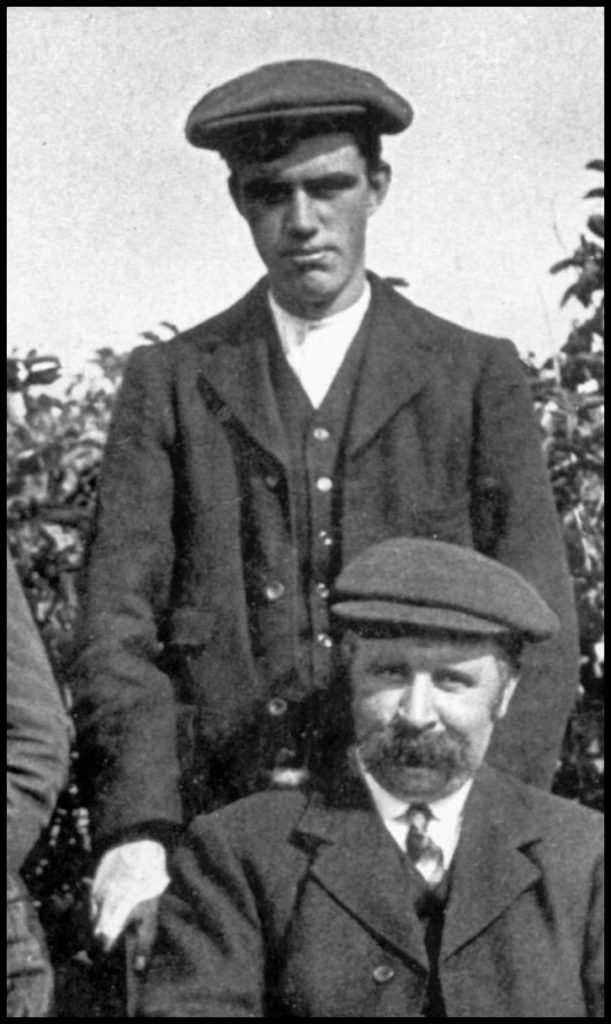
S/24029 Private Hugh Gibson
7th Seaforths, died of wounds in hospital on 2nd May 1918, aged 19.
Buried in Grave LXV.A.19, Etaples Military Cemetery, Pas de Calais, France.
Born at Triblo, Sourin, Rousay on 9th April 1899, son of Hugh Gibson [seated in the photo] and Betsy Gibson (née Craigie). The Gibsons later moved to Pow and Faraclett.
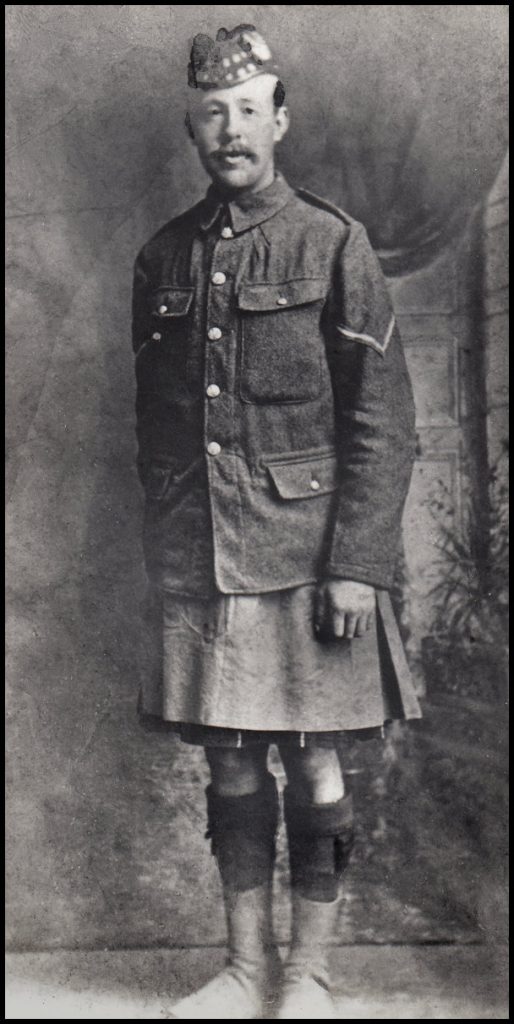
S/12611 Private John David Grieve
1/4th Seaforths, killed in action near Flesquières on 20th November 1917, aged 28.
Commemorated on the Cambrai Memorial, Louveral, Nord, France.
Born at Fa’doon, Rousay on 28th February 1889, son of William Grieve and Christina Grieve (née Craigie). Before he enlisted in Kirkwall, John was a joiner and worked for Peace’s of Kirkwall.
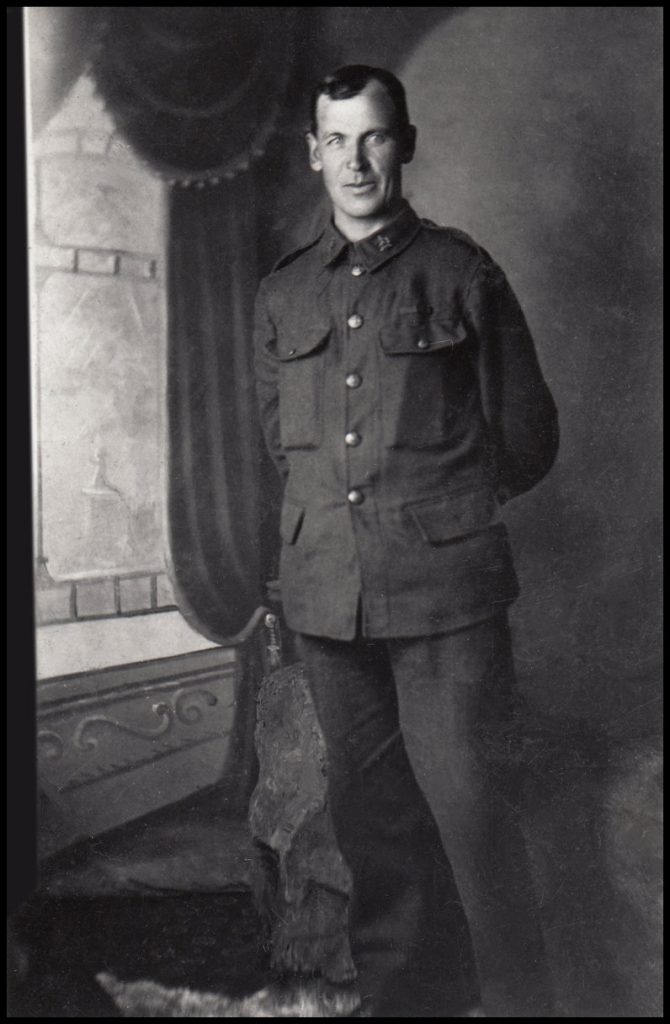
1593 Private George Inkster, D.C.M.
Princess Patricia’s Canadian Light Infantry, died of wounds on 17th July 1916, aged 35.
Buried in Grave VI.B.15, Railway Dugouts Burial Ground, Ieper, West-Vlaanderen, Belgium.
George served his trade as a carpenter. In Ottawa on 24th August 1914 he joined Princess Patricia’s Canadian Light Infantry, raised by Hamilton Gault of Montreal and named after the daughter of the Governor-General, the Duke of Connaught. Like most volunteers who joined that Battalion then, George had previous military service, having served in 31st Battalion, Imperial Yeomanry (Fincastle’s Horse) in South Africa. He was awarded the Distinguished Conduct Medal “for conspicuous gallantry and devotion to duty on May 8th 1915 at Hooge. Pte. Inkster stationed himself at the end of a communication trench and shot several of the enemy attempting to come down it. He was alone at the time. He also carried several important messages under a very heavy fire and was always willing to undertake dangerous work.”
Born at Hammer, Wasbister, Rousay on 29th April 1881, son of Hugh Inkster and Georgina Inkster (née Harcus). The Inksters moved to Knapper from Geo at Westness. Earlier they had farmed Hammer until the laird made it part of Innister, leaving them without a livelihood.
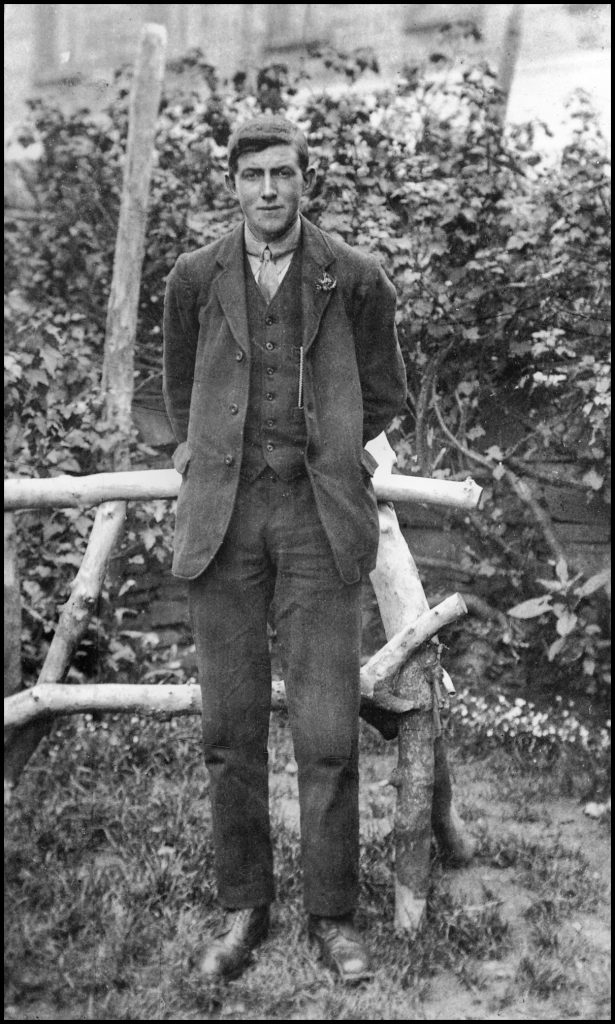
S/27889 Private John Angus Munro Inkster
4th (Reserve) Seaforths, died of meningitis in Loanhead Hospital, near Edinburgh on 1st July 1918, aged 18. John’s body was returned home and buried in Scockness Cemetery, Rousay.
Born at Swartifield, Sourin, Rousay on 4th November 1899, son of John Inkster and Jane Inkster (née Irvine). John enlisted in Inverness. His family later moved to Woo.
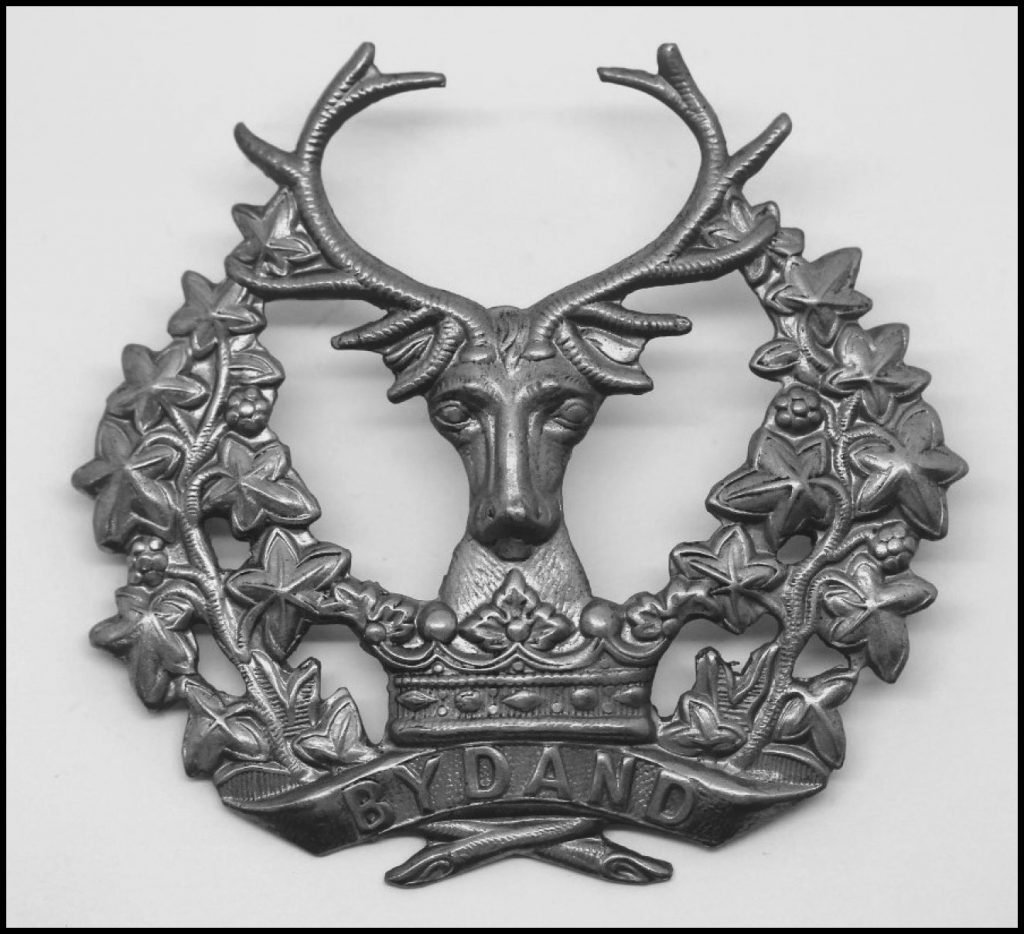
14066 Private John Gibson Logie
1/6th Gordons, died of wounds received at Beaumont Hamel on 22nd November 1916, aged 37.
Buried in Grave I.K.19, Mailly Wood Cemetery, Somme, France.
Born at Quoygrinnie, Rousay on 19th November 1879, son of John Logie and Mary Logie (née Gibson).
Before he enlisted, John was a cattle dealer. He spent his childhood at Quoygrinnie, his father being a shepherd at Westness. John’s sister, Mary, who was a nurse, lived latterly at Rose Cottage with her cousin, Minna Logie.
[No image is available of Pte Logie. Instead I include a photo of a Gordon Highlander’s cap badge]
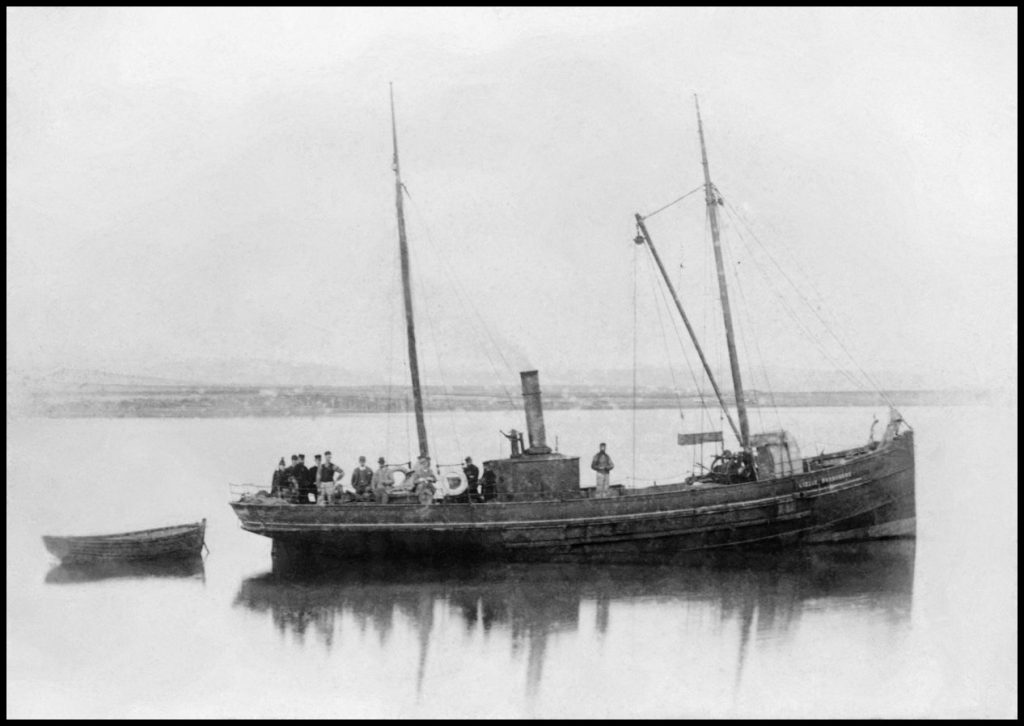
Engineer Isaac Marwick, Mercantile Marine
Died on 25th February 1916, aged 58, in the sinking of S.S. ‘Southford’ (Glasgow), which struck a mine and sank when leaving Harwich harbour. All the crew were saved, but Isaac died of a heart attack, brought on by the sudden immersion in cold water after being in the heat of the engine room.
Commemorated on the Tower Hill Memorial, London.
Born at Essaquoy, Sourin, Rousay on 28th October 1857, son of Robert Marwick and Bella Marwick (née Mainland). Isaac was married to Sarah Harrold from Rendall and they had two children, Robert and Maggie Ann. Isaac was a blacksmith at Rousay Pier, was engineer on the steamer ‘Lizzie Burroughs’ for a time. He was engineer on S.S. ‘Hoy Head’ for many years, was on the S.S. ‘Southford’, sailing out of Leith, when he met his death. He and Sarah had their home at 5 Inverleith Terrace, Edinburgh. [The ‘Lizzie Burroughs’ is pictured to the left at Trumland pier in the late 1800s]
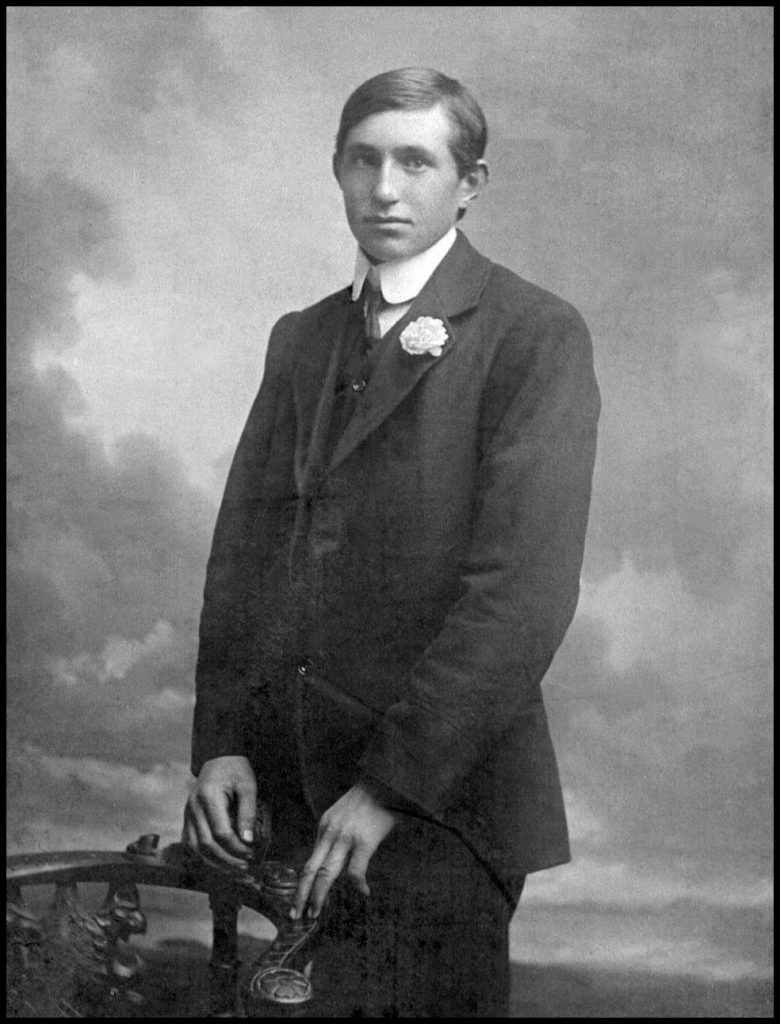
138391 Private John Hourston Marwick
58th Battalion, Machine Gun Corps, formerly 13092 Seaforths, killed in action near Epéhy on 7th September 1918, aged 21.
Commemorated on Panel 10, Vis-en-Artois Memorial, Pas de Calais, France.
Born at Essaquoy, Sourin, Rousay on 30th April 1897, son of David Marwick and Ann Marwick (née Leonard).

13423 Private David William Munro
15th Highland Light Infantry, killed in action near Aveluy on 17th March 1916.
Buried in Grave D.20, Aveluy Communal Cemetery Extension, Somme, France.
Born at Old School, Sourin, Rousay on 17th October 1887, son of Alexander Munro and Christina Munro (née Stephen). David was working in Glasgow when he enlisted there.
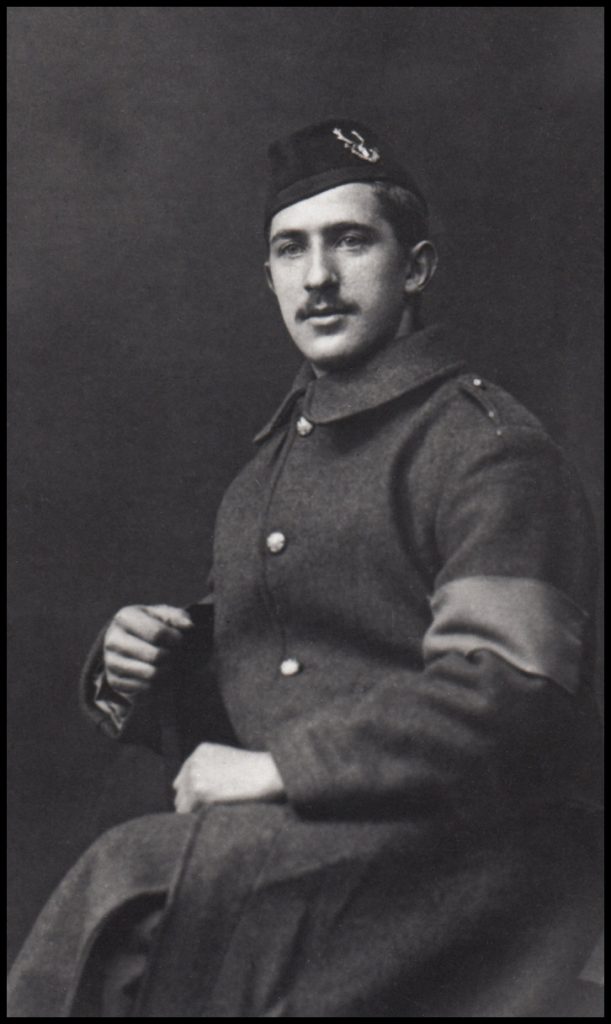
S/12891 Private Harry Reid
3rd (Reserve) Seaforths, died of measles and pneumonia on 14th May 1917, aged 22.
Born at Brough, Westside, Rousay on 26th November 1894, son of Alexander Reid and Harriet Henrietta Reid (née Logie). Harry’s mother died of haemorrhage three hours after his birth. His father later moved to Longhope on Hoy, where he was employed as a gardener at Melsetter House. Harry died in the family home there in 1917, but was buried in Westness Cemetery, Rousay in a military funeral. His brother Alex. served in a Canadian artillery unit and survived the war.
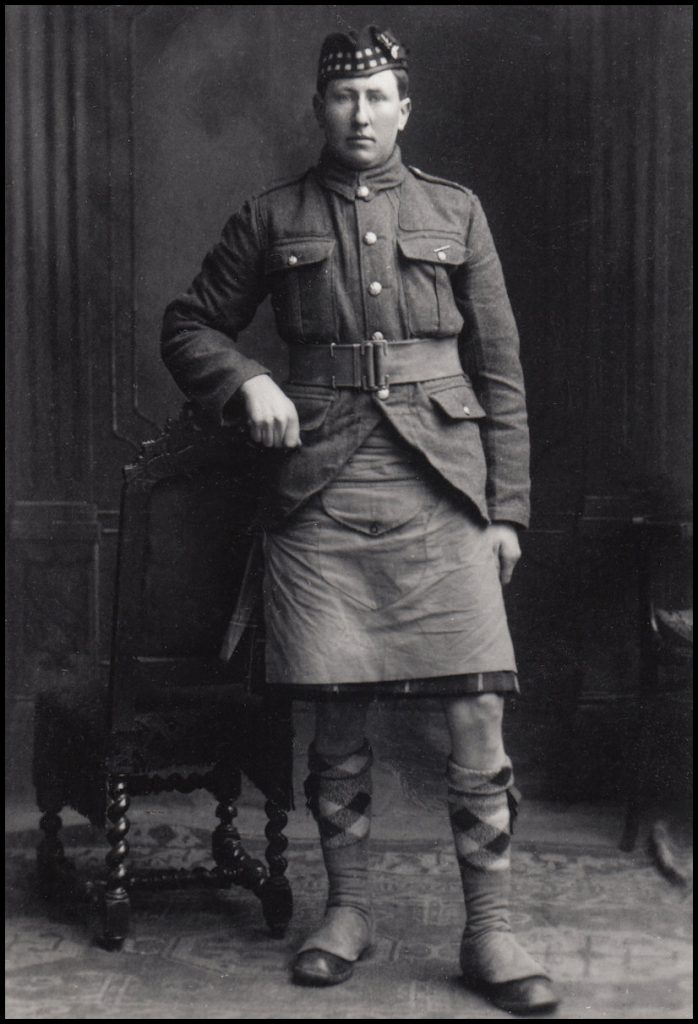
S/41098 Private Edward King Seatter
8th/10th Gordons, killed in action near Guémappe on 21st April 1917, aged 19.
Commemorated in Bay 9, Arras Memorial, Pas de Calais, France.
Born at Banks, Sourin, Rousay on 19th August 1897, son of Robert Seatter and Sibella Seatter (née King). Before he enlisted in Kirkwall, Edward worked on the family farm.
WORLD WAR II

2823354 Serjeant John Sinclair Gibson
2nd Seaforths, died at Le Havre on 11th September 1944, aged 25.
Buried in Grave 7, Row P, Divn. 67, Ste. Marie Cemetery, Le Havre, Seine-Maritime, France.
John’s parents were James Gibson and Mary Gibson (née Cooper). Before he joined up John worked at home, Hullion, Rousay. He went through the whole of the North African campaign, then returned to Britain to take part in the invasion of France. John survived the Normandy campaign, but was killed during the fighting to clear the Germans out of the port of Le Havre.
John is pictured at Hullion with his niece Mary Gibson.
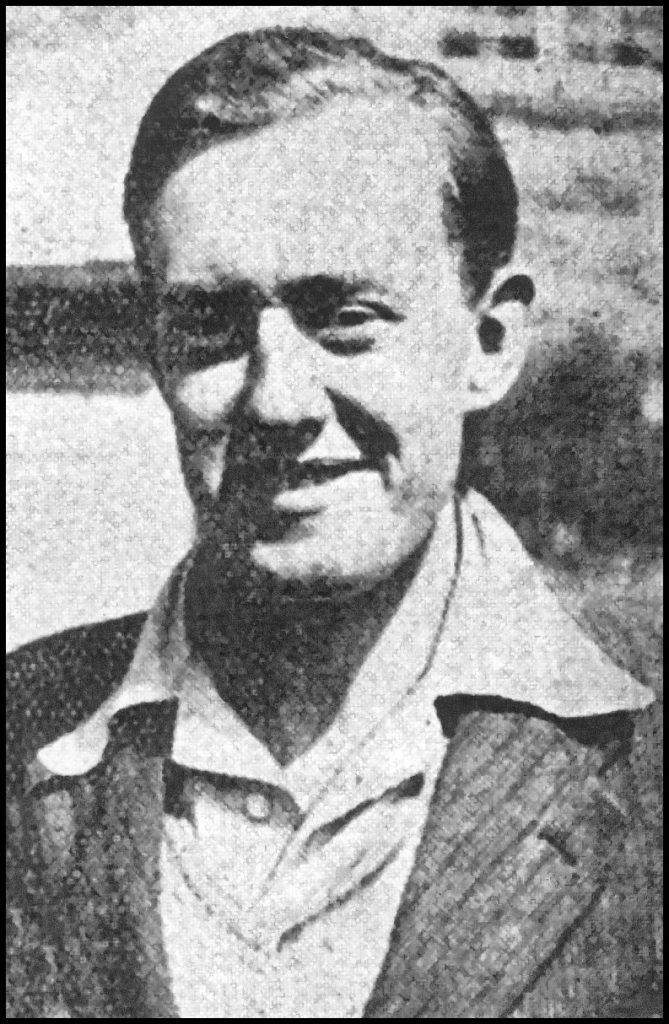
2365466 Signalman Thomas Walls
18th Division Signals, died in a P.O.W. Camp in Thailand on 6th July 1945, aged 24.
Buried in Grave 6.E.40, Kanchanaburi War Cemetery, Thailand.
Tom’s parents were William R. Walls and Jean Walls (née Ross) who had married in Glasgow in 1919. When Tom was born, the family lived at Store Cottage, Rousay. The family moved to Kirkwall and Tom was Dux of Kirkwall Grammar School in 1938. Tom worked for a couple of months delivering letters for the Post Office in Kirkwall, while he waited for his call up papers to arrive. Tom was taken prisoner at the fall of Singapore in February 1942, had to endure the harsh treatment to which the Japanese subjected those who worked on the Burma-Siam railway. Tom died only a month before the surrender of Japan.
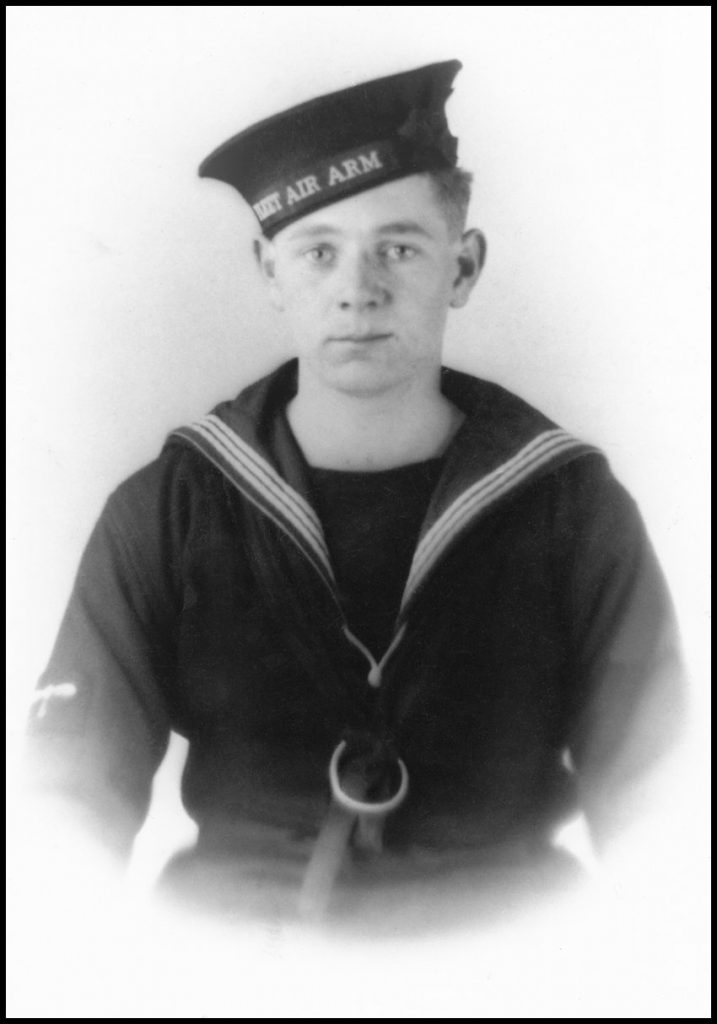
FAA/SFX.612 Leading Air Mechanic James Sinclair Mainland
Royal Navy, died when H.M.S. “Dasher” blew up in the Clyde on 27th March 1943, aged 24.
Commemorated on Panel 4, Bay 4 of the Lee-on-Solent Memorial, Hampshire, England.
James’s parents were George Mainland and Violet Mainland (née Sinclair). Before he joined the Navy, James worked on the family farm, at Weyland, Egilsay.
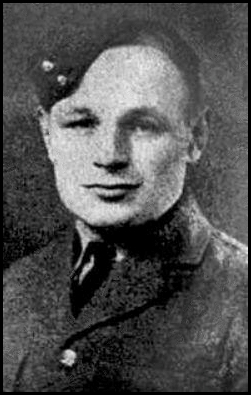
566410 Sgt. Pilot Robert Marwick Mainland R.A.F.
Robert Marwick Mainland was born on September 9th 1916 at 11 Broad Street, Kirkwall. He was the son of Robert Mainland, Essaquoy, and Jessie Marwick, Scockness.
Young Robert joined the RAF, and was later promoted as Sergeant Pilot to 605 Squadron in 1939. Then stationed at Tangmere, West Sussex, the squadron moved to Wick, Caithness in February 1940.
On April 25th 605 Squadron were scrambled to investigate unidentified aircraft activity in the sky in proximity to Scapa Flow, the Home Base of the Royal Navy. While flying in tight formation another plane came into contact with Robert’s, the damage causing his plane to plummet towards the ground. Robert managed to bale out but his parachute failed to deploy properly and his impact with the ground proved fatal. Sergeant Pilot Robert Marwick Mainland was buried with full military honours on 30 April 1940 in Grave 411, Section O, in Wick Cemetery, Caithness.
His name was added to the Rousay War Memorial in the Spring of 2017, and a dedication service was attended by his cousin, niece and nephew, and representatives of the Kirkwall Branch of the Royal British Legion Scotland.
[Photo credit: David W Earl / Hanover Publications]

ACT OF REMEMBRANCE
Let us remember before God, and commend to his sure
keeping: those who have died for their country in war;
those whom we knew, and whose memory we treasure;
and all who have lived and died in the service of mankind.
They shall grow not old as we that are left grow old:
Age shall not weary them, nor the years condemn.
At the going down of the sun and in the morning
We will remember them.
We will remember them.
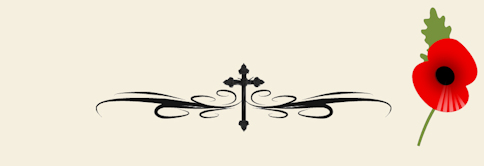
Grateful thanks to Brian Budge for allowing me to use information from the Rousay War Memorial
section in his extensive ‘Orkney War Memorials’ which can be found on the Kirkwall Branch
of the Royal British Legion website.
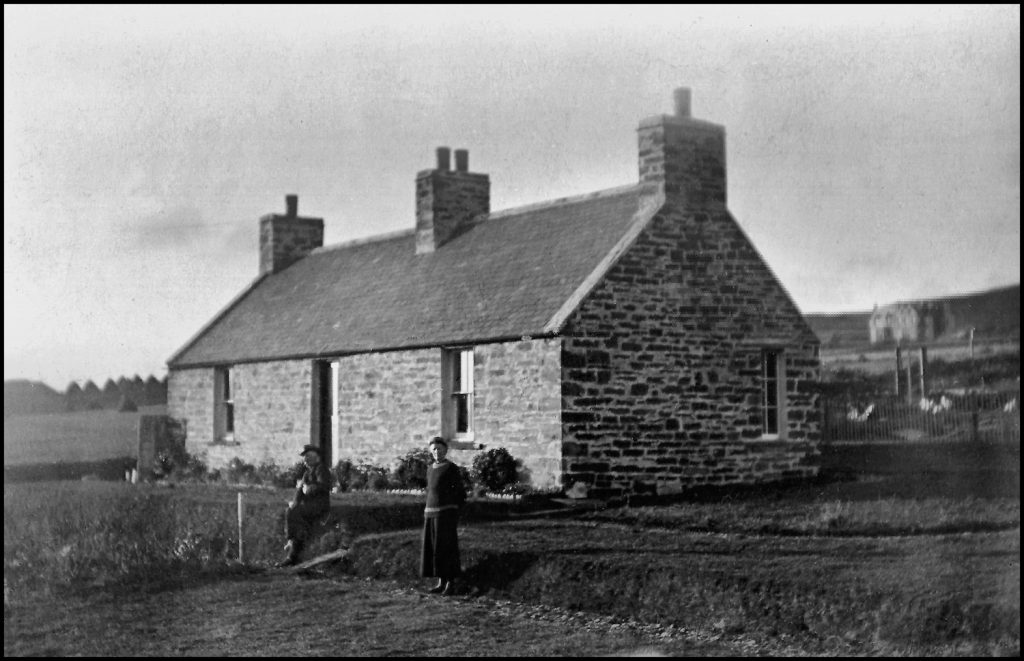
Frederick Traill Inkster was the son of Hugh Inkster, Ervadale, and his first wife Isabella Kirkness, Quoyostray. He was born on September 7th 1868 in Unst, Shetland, where his father Hugh had moved to farm 40 acres of land at Greenfield, Haroldswick. Isabella died in childbirth in August 1882. Hugh returned to Rousay and married Isabella’s first cousin, Mary Kirkness of Grain. They travelled back to Unst and went on to have another six children. In 1894 Hugh, Mary and all thirteen children from both marriages returned to Rousay, where Hugh took over the tenancy of Westness Farm.
Above left: The Inkster family of Westness. Back row (l to r) – Ann, Janet, Lily, Mimie, and Mary. Middle row – Hugh and Mary (the parents), Isabella, and Fred. Front row – David and Robert. – To the right is Fred, with his sisters, Ann, Mimie, Janet, Mary and Lilly. – The quality and composition of these two photographs is exceptional, and I feel confident in saying they were the work of John Logie, artistic butler at Trumland House at this time.
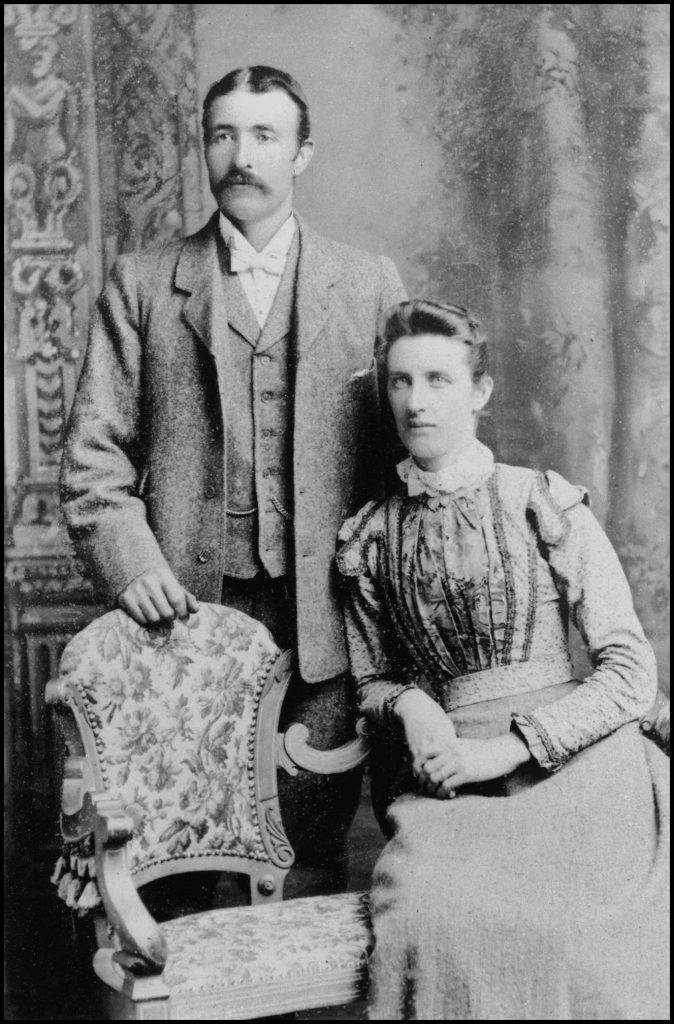
Fred Inkster moved from his father Hugh’s farm at Westness to farm land at Furse and Innister in Wasbister. At No. 3 Frotoft (Brough) on February 3rd 1898 he married 28-year-old Isabella Drever Craigie, daughter of James Craigie, Claybank, and Isabella Kirkness, Quoyostray, and soon after that he took over the tenancy of Trumland Home Farm in the early 1900s.
When Fred retired from farming in 1922 he had a house built on a triangle of land he retained, east of Trumland farm buildings. He called the house Greenfield, the same as the name of the farm in Shetland where he was born.
Fred served as a County Councillor for the island and was also a Justice of the Peace. He passed away in May 1944 at the age of 75, and his wife Isabella died in March 1953 in her 83rd year.
Isabella’s niece Maggie Ann Corsie Craigie was the daughter of John Kirkness Craigie and Annabella Scarth of Corse, and she was born in 1906. On November 11th 1926 she married James William Grieve of Westness in 1926 and they moved into Greenfield after Isabella’s death. Jim was the son of Malcolm Costie Grieve and Lizzie Thompson. At the time of their marriage Jim was employed as a chauffeur for Walter Grant’s sisters who lived at Westness House, and Maggie was a ‘table-maid.’
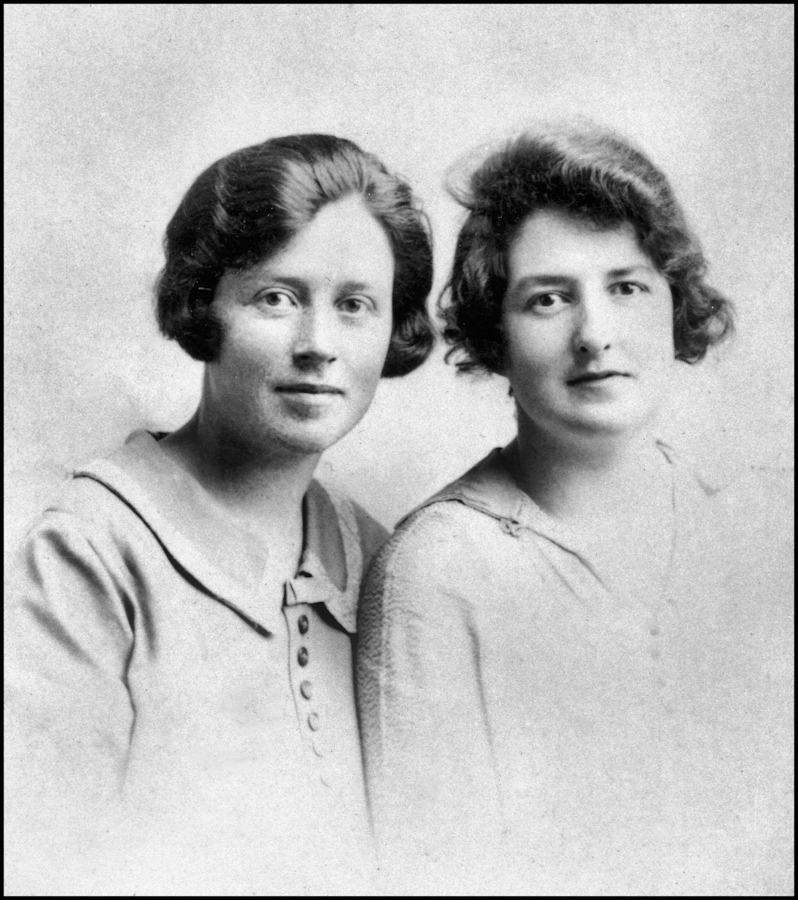
Maggie Grieve passed away in 1958, and Jim in the late 1970s. Greenfield was then occupied by Maggie’s nephew Ronald Stevenson, who was a farm worker at Westness. Ronald was the son of James William Stevenson and Isabella Inkster Craigie of Corse [Maggie’s sister]. The house was later bought by Hugh and Margaret Mainland in 1979, who repaired and modernised it, moving in during the following year. The garage was enlarged, and an extension built between it and the house, and that is where Margaret had the Post Office. In June 2008 Hugh and Margaret sold Greenfield to Erica Flaws and Danny Hall.
Maggie Grieve on the right, with her friend Edda Mainland, Nears c1920
Below: Two aerial views of Greenfield, the one above left taken in 1990 and that to the right in 2016
[Credit goes to Ron Spence, Banchory, for information and family photos of Fred and Isie Inkster;
Tommy Gibson for photos of Jim and Maggie Grieve, and to Hugh and Bruce Mainland and
Erica Flaws and Danny Hall for their contributions]
Having posted the photos of Jim and Maggie Grieve on social media a few folk were forthcoming with memories of them, Bertie Gillespie commenting first. ‘Jeemso’ mentioned below, was Jim Craigie, Maggie’s brother, and he lived at Corse. Cousins Leslie Craigie, Anna Laurenson and Alistair Craigie, all related to Jeemso’s brothers and sisters, share their memories of him:-
*Bertie Gillespie [now Lyness] writes: Me only claim tae fame in 1956. I bought a motor bike off Jim Grieve, he lived in this house, it was a BSA 500 Sloper 1932 vintage. It cost me a whole £1. Oooh a bargain !! Wae the girder forks she was a non runner when I bought it; me dad had an identical model so in good Rousay tradition I made one out o the two!
*Leslie Craigie writes: Ah Max, that is my father’s sister Maggie, she was the one that died young, I have never seen a photo of her before, that’s made my week.
*Anna Laurenson replies: I hiv 2 memories o Greenfield that stick wae me. One was Jim’s collection o clocks. Lord knows hoo many he had bit I can mind him gan roond windan them all up. They were mainly all strikan clocks so you can imagine the noise every hour! Also dae you mind all the glass balls or buoys they had? Must have been hundreds I think. They had them lining the edge o the garden. Used tae fascinate me when I wis peedie! My last memory o Jim was at my wedding. I think he danced every single dance!
*L.C.: Thats right Anna, I mind the clocks indeed, being a peedie kid I had never seen so many, I mind the multi coloured fishing floats at Briarlea as well.
*A.L.: Don’t think that means a lot tae me though. Wan thing I do mind at Briarlea wis the thing that Jeemso rigged up for speakan back and fore atween him and Briarlea. He wis a right knacky chap!
*Alistair Craigie comments: He meed hid oot o auld gas masks (carbon granules, tobacco tins). He also meed a waal in his workshop oot o jamjars fur storage! He was a genius!
*L.C.: Thats right Anna, I mind when I was about maybe 7 or 8 he had made a wheel barrow, he had a steel float for a wheel, would go anywhere, about 30 years later Dyson made the roller barrow, looked exactly the same.
*L.C.: He was also linesman with GPO, he invented a tool to join broken lines from the ground, same thing again GPO invented exactly the same thing.
*A.C.: I remember that tool!
*L.C.: He also had electric lights at Corse with a wind generator and a bank of batteries.
*L.C.: And his contraption to clean the byre straight into the cart, haha, I could go on and on!
*L.C.: Do you remember the whisky still up in the peat hill between Peedie water and Muckle water? I remember Uncle Jock showing me it in the peat cutting, it was half burried in the peat, must have been old as the hills!
*A.L.: I mind the jam jar wall indeed. Hid used tae fascinate me. Whit a great idea that wis! Mind the byre scraper tae Leslie. Never saw the still bit noo when you say it sure I heard aboot it indeed. Used tae love gan tae Jeemso’s peedie wooden hoose at the back o Corse tae see whit I could see.
*L.C.: Auntie Mary’s wasnt hid?
*A.L.: That rings a bell tae.
*L.C.: Was our grandad’s auntie that stayed there when it was built.
*A.L.: That’s right. Mind noo indeed. Think your memories a lot better than mine!
*L.C.: Just sticks in me mind, mind going into Corse when I would have been maybe 6 or 7, was amazing, he had a prop for a Spitfire and all kinds of things in there, a young lad’s dream, anyway he caught me and I remember I wet myself, he petrified me!
*A.L.: All I can say tae that Leslie is hahaha!
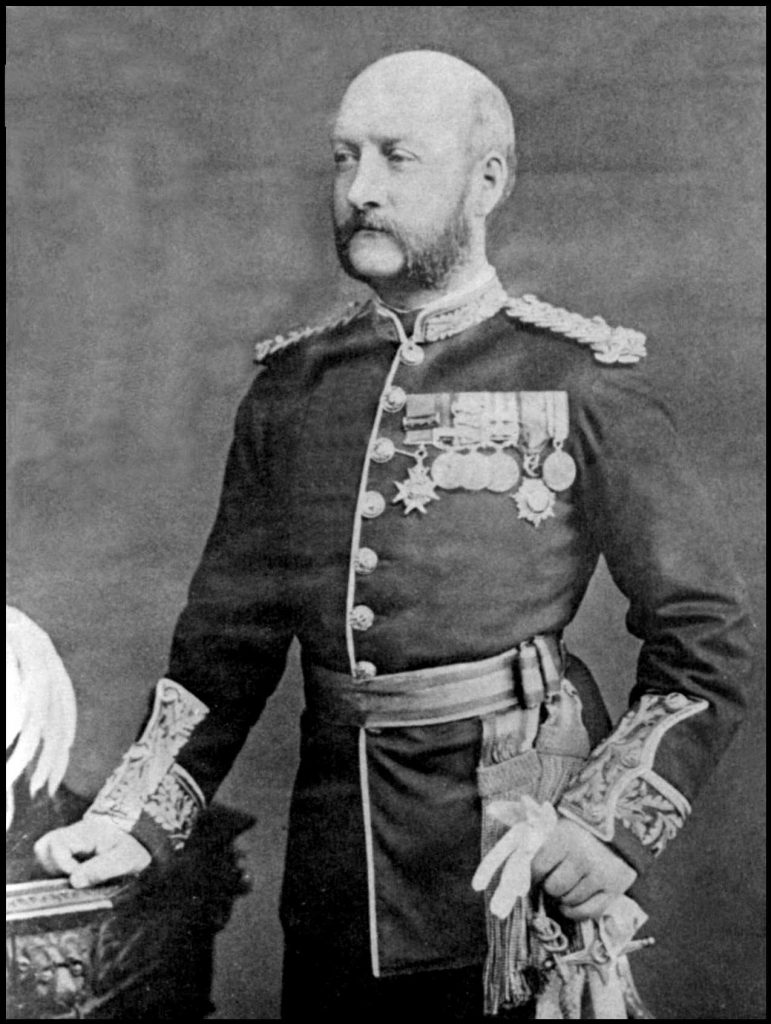
Frederick William Burroughs was sixteen years of age when he inherited the estate of Rousay and Viera on the death of his great-uncle, George William Traill, in 1847. It was at that time he assumed the name Traill, hence Frederick William Traill-Burroughs. He was the eldest son of Major-General Frederick William Burroughs, of the Bengal Army, and grandson of Sir William Burroughs, of Castle Bagshawe, Belturbet, County Cavan. Through his mother Caroline, the only daughter of Captain Charles Adolphus Marie de Peyron, of the 3rd Bengal Light Cavalry, he was the great-grandson of the Chevalier Charles Adrien de Peyron, who was killed in a duel in Paris in 1784 by Auguste Marie Raymond, Prince d’Arenberg, Comte de la Marck. He was educated at Kensington Grammar School, at Blackheath Grammar School, and at a select establishment managed by a German count at Hofwyl in Switzerland.
Burroughs was gazetted Ensign in the 93rd Sutherland Highlanders on the 31st March, 1848, being then just 17 years of age. On September 23rd 1851 he was promoted Lieutenant, he became Captain on November 10th 1854, and Major on July 20th 1858. He served with the Regiment in Bulgaria, and throughout the Crimean War, took part in the Battles of the Alma, Balaklava, in which battle he commanded the Left Centre Company of The Thin Red Line, and throughout the Siege of Sebastopol. He was present at the assaults of the 18th June and 8th September, 1855, and the fall of the Sebastopol. He also took part in the expeditions to and capture of Kertch and Yenikale.
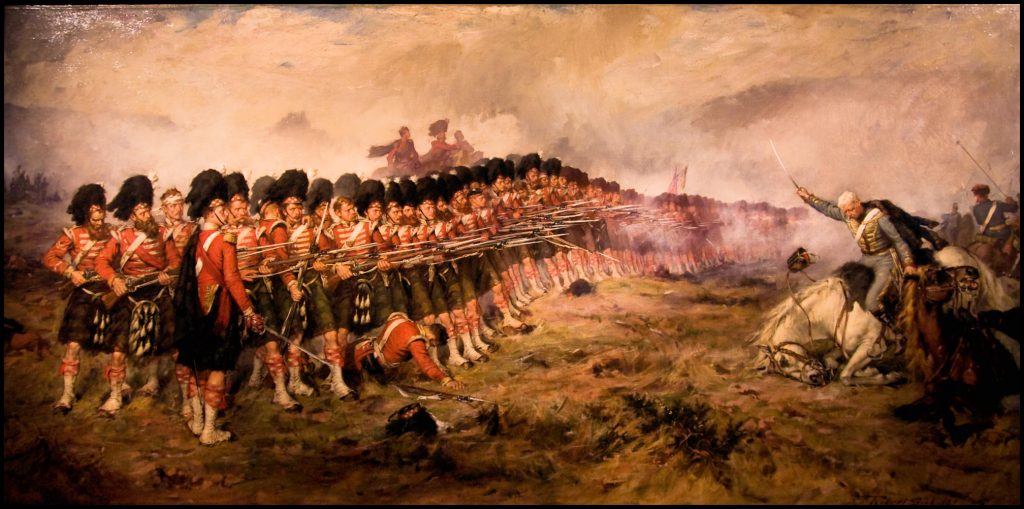
The Indian Mutiny campaign of 1857-58 again saw the 93rd Highlanders under their old chief, Colin Campbell, and Captain Burroughs had the fortune to serve with his regiment throughout all the fighting which preceded the relief and the final capture of Lucknow. He was the first, or one of the first through the breach at the storming of the Sikanderbagh, and with Lieutenant Gordon Alexander and some dozen men overpowered the gate guard. For this service, in which he received a deep tulwar [sabre] cut on the head, he was recommended for, but was not awarded, the Victoria Cross; but his conduct on this and other occasions, such as the battle of Cawnpore, the pursuit to Serai Ghat at the action of Khodagunge, the storming of the Begum Khotee, and, finally, the siege and capture of Lucknow (during which he sustained comminuted compound fractures of both bones below the knee in his right leg), was rewarded at the close of the campaign with the brevet of Major. The wounds he received in the Mutiny campaign disabled him for two years, and compelled him to return home – during which time he paid a visit to his Rousay estate and received the Freedom of the Borough of Kirkwall.
He rejoined his regiment in India in 1860, and in 1862, being then still a Captain and Brevet Major, succeeded to the temporary command of the 93rd, which lost two commanding officers within ten days of each other through an outbreak of cholera. He took the regiment over the River Indus below the fort of Attock [Punjab, Pakistan], after which there were no further cases of cholera. He was thanked for his services by the Governor General in Council. In that year he obtained his substantive majority, and two years later, being then in his 34th year, became Lieutenant-Colonel commanding the 93rd. Although he held the command of the regiment for nearly ten years, his only further active service was in the Umbeyla Pass in 1863-64, where he was again mentioned in despatches. He became a Colonel on August 10th 1869, and after going on half pay in 1873, commanded the 1st Brigade of the Orkney Artillery Volunteers till 1880 when he became Major-General, and retired in 1881 with the rank of Lieutenant-General.
Burroughs received numerous decorations for his military services. From the Sultan of the Ottoman Empire obtained the Order of the Medjidie of the 5th Class; he had the Crimea Medal, with clasps for Alma, Balaclava, and Sebastopol. He was also presented with the Indian Mutiny Medal, with clasps for the Capture and Relief of Lucknow. He was also awarded the India General Service Medal, with clasp for Umbeyla; the Turkish Crimea Medal 1855; and he was several times mentioned in despatches from the Crimea and India. He was awarded the Companionship (Military Division) of the Most Honourable Order of the Bath [CB] on May 24th 1873, and on Tuesday July 5th 1904 he was made Knight Commander (Military Division) of The Most Honourable Order of the Bath [KCB] in the Throne Room at Buckingham Palace, where he was dubbed by King Edward VII.
Now let us go back to 1870. Burroughs had already been laird of the estate of Rousay and Viera for twenty-three years, but he was virtually unknown to his tenants since these years had been spent in the army. In Edinburgh on June 4th 1870 he married Eliza D’Oyly, youngest daughter of Colonel William Geddes, C.B., Bengal Horse Artillery, and Emma, daughter of Edward D’Oyly, of Zion Hill, Yorkshire. The following month he and his new wife came to Rousay and Westness House, which they made their home. It was not too long before Mrs Burroughs found the house unsuitable and suggested to her husband the building of a larger and more imposing mansion – somewhere more salubrious to entertain family and friends. They employed Edinburgh architect David Bryce, who promised to build ‘a very compact, complete and nice looking house’ for less than £3000.
The work of building Trumland House started in 1873. Such a house with its surrounding offices – coach house, kennels, joiner’s shop, stables and game-keeper’s house – could not have been cheap and indeed turned out to be a good deal more expensive than Burroughs had expected. Plans for a tower were, perhaps fortunately, abandoned as was the west entrance with its second lodge. Even after these economies the eventual cost of the house, grounds and furnishings was £11,887, a figure which contrasts sharply with the price of a cottar house which could be erected for less than £5.
The impressive Coat of Arms above and to the right of the main door of Trumland House is an amalgamation of the Burroughs and Geddes family heraldic arms.
On the left of the display is a version of the Burroughs of Castle Bagshaw, County Cavan, arms, depicting the blasted trunk of an old oak tree, eradicated, [meaning its roots are visible]. To the right are the arms of the Geddes family, an escutcheon Argent between three pike-heads, or ‘gedds’ heads – it having been suggested that the surname was a patronymic created from the personal name Geddie, which may come from the Scots dialect word ‘gedd’, meaning ‘pike’.
Below is the old Burroughs motto:- Audaces Fortuna Juvat – Fortune Favours the Bold. Below that are Burroughs’ war medals – details of which are as follows:-
1 Turkish Crimea Medal 1855
2 Crimea Medal 1854-55, three clasps – ‘Alma’, ‘Balaklava’, ‘Sebastopol’.
3 Turkish/Ottoman Order of the Medjidie, 5th class
4 CB – Companion of the Military Division of the Most Honourable Order of the Bath 1873
5 Indian Mutiny Medal 1857-58, two clasps – ‘Relief of Lucknow’, ‘Lucknow’
6 India General Service Medal 1863-64, one clasp – ‘Umbeyla’
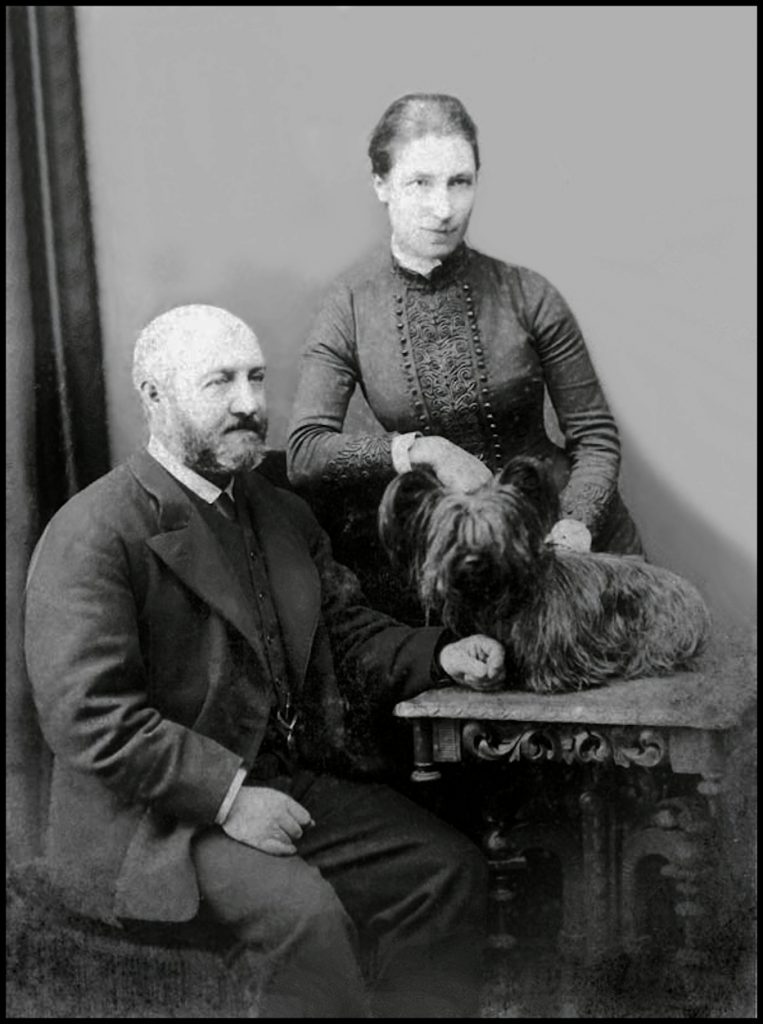
The schoolchildren of Rousay eagerly looked forward to the annual picnic, which had always been held at Westness House. Now the laird was in residence at Trumland that was the new venue for the picnics. A report in The Orcadian of August 1876 stated that 75 pupils from Sourin, 54 from Frotoft, 39 from Wasbister, and 18 from Wyre gathered at Trumland on a day of torrential rain. The Sourin contingent carried bannerettes, putting the others in the shade! On these happy occasions the General and Mrs Burroughs, along with any house guests of the time, led the children through a programme of games and races followed by tea on the lawns. At the end of an enjoyable afternoon the children were sent home with a paper poke of goodies and a small gift which sometimes consisted of nothing more than a picture cut from a magazine.
The census of 1881 informs us fifty-year-old General Frederick William Traill-Burroughs, Deputy Lieutenant, Companion of the Order of the Bath, and Justice of the Peace, and his 30-year-old wife Eliza D’Oyly Geddes, were in residence at Trumland House. The butler was 24-year-old John Logie, and the cook was 37-year-old Betsy Robertson; Elizabeth Copeland was a 28-year-old housemaid; Margaret Rendall was a 42-year-old laundry-maid; and Anne Gibson was a 19-year-old under-housemaid – all of whom were unmarried.
Living at Trumland Lodge at this time was a 39-year-old general labourer and foreman Alexander Munro, his 36-year-old wife Christina, and their two young daughters, two-year-old Malcolmina and 9-month-old Agnes. Alexander and Christina were born at Bower, between Thurso and Wick in Caithness. They had a boarder staying with them, 32-year-old John Geddes, a blacksmith and wire fencer, and a visitor named George Munro, a 44-year-old unemployed forester, both from Bower.
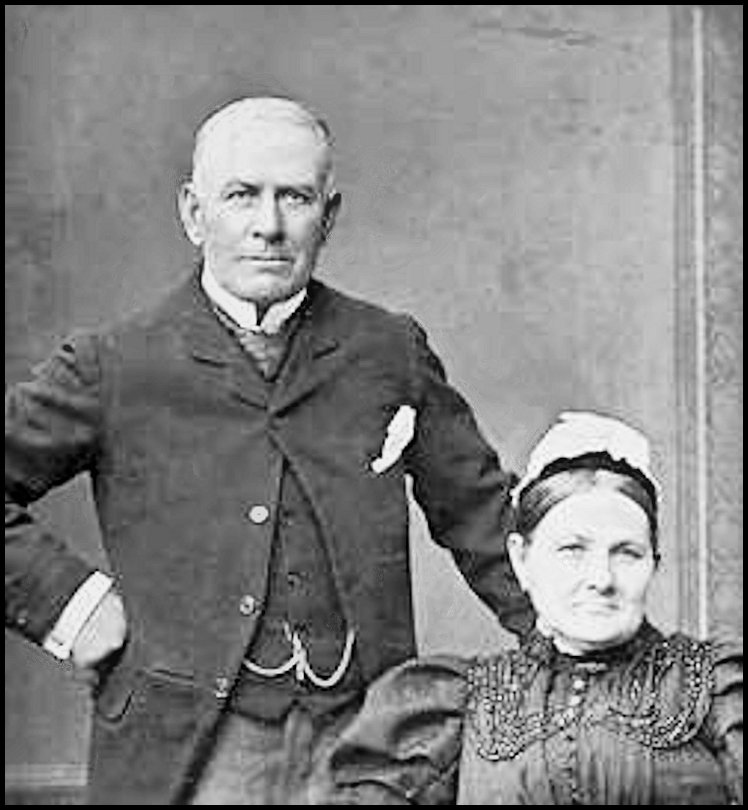
Also living at Trumland was 42-year-old Alexander Auld, who was the coachman. Under the same roof was his 40-year-old wife and their eight children. Catherine Auld, like her husband, was born in Wick, as was their first child, John, now a 17-year-old apprentice gardener; their five other children were Elizabeth, James, Catherine, Alexander, and Ellen, whose ages ranged from 15 down to 7 years, all born at Bower near Wick, and all of whom were scholars. There were two other youngsters, George (3) and two-year-old Maggie.
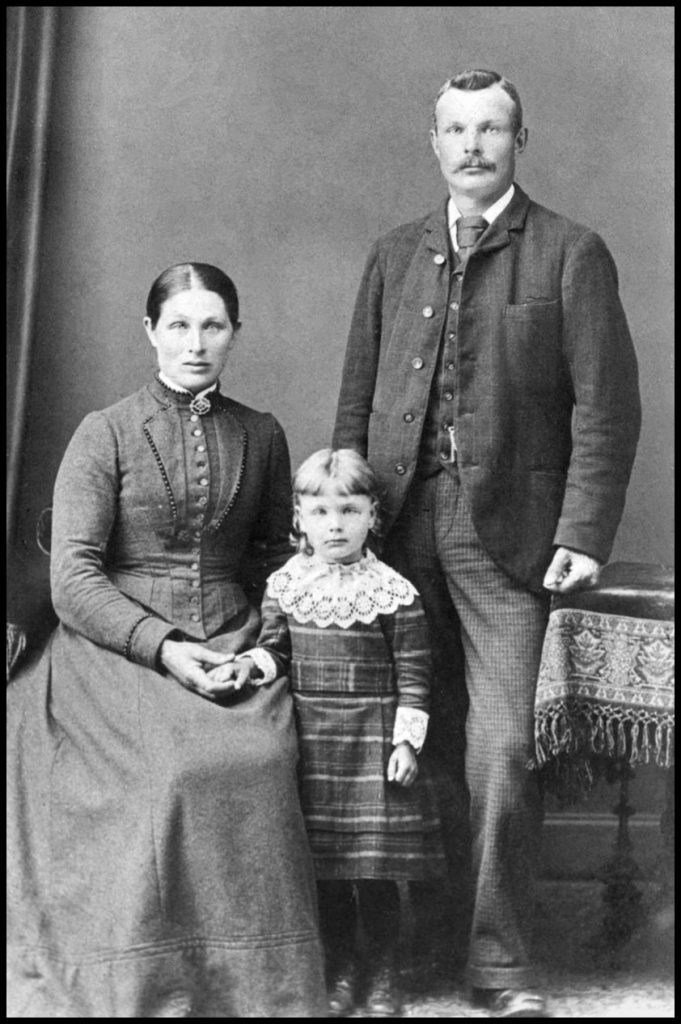
Then there was the gamekeeper. He was 31-year-old Robert M. Murrison, who was born at Monymusk, west of Aberdeen. With him was his wife Maggie, who was 23 years old and from Inverness, and their 6-month-old son Alexander William.
In 1891 there were two families living at Trumland Cottage. William Logie was then a 30-year-old gamekeeper but he later became General Burroughs’ yacht-master. He was the son of John Logie and Cecilia Gibson of Geo, Westness. His wife was Helen Marwick, the daughter of William Marwick and Helen Grieve of Hanover and she was born in 1854, and they had one child, a daughter christened Cecilia, who was born in 1890.
Gamekeeper William Logie, his wife Helen, and young
daughter Cecilia – or Cilla as she was known
The Burroughs’ at home – Reading a newspaper, writing a letter, with a visiting group
of tenants and children, and strolling in the graden.
I will not dwell on the conflict between the laird and the Rousay crofters, for the subject has been covered in minute detail within the Rousay in Newsprint pages elsewhere on this site. Burroughs set about disposing of his estate but couldn’t find any buyers so he resigned himself to remaining on the island. Despite the bitterness caused by the Crofters Commission findings he did find honours in old age. In 1889 he was returned unopposed as Rousay’s first County Councillor, and he re-appeared on the School Board. He was made honorary colonel of the Warwickshire Regiment, and of his own regiment [which had been amalgamated to form the Argyll and Sutherland Highlanders]. He was appointed a Vice-Lieutenant of Orkney and Shetland on January 17th 1900, and he received a knighthood in 1904, which he saw as a recompense for his failure to win the Victoria Cross at Lucknow. The photo above shows Sir Frederick with his war medals, the CB hanging from the neck ribbon, and the KCB breast star pinned below.
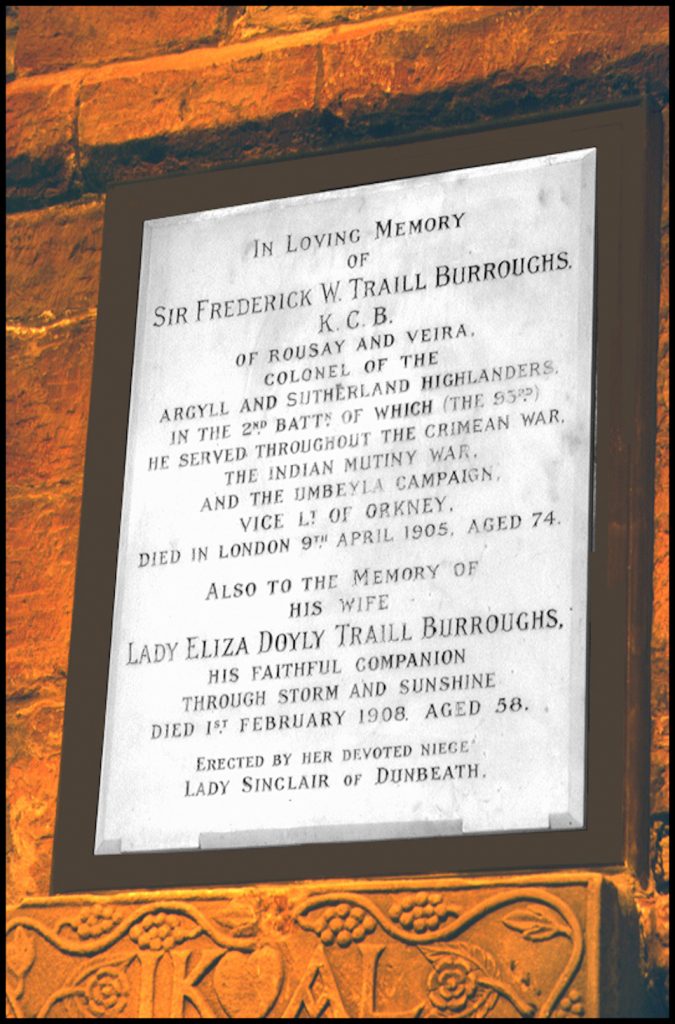
When the 1901 census was carried out on April 6th Frederick and Lizzie were living in their London residence – 87 Ecclestone Square, in the Borough of Westminster. Faithful butler John Logie was on hand, as was his wife Annie, who was the cook, and Bella Mainland [31], who was the housemaid. She was the daughter of John Mainland and Lydia Mowat, Langstane.
Frederick William Traill-Burroughs died in London on April 9th 1905 and was interred in the vault of the late George William Traill of Rousay and Viera in Brompton Cemetery in the Royal Borough of Kensington and Chelsea. His wife passed away on February 1st 1908.
A memorial commemorating the lives of both husband and wife was erected in St Magnus Cathedral, Kirkwall, by Lady Edith Marion D’Oyly Dunbar or Sinclair, wife of Sir John Rose George Sinclair, 7th Baronet of Dunbeath, Barroch House, Wick, and executrix of Lizzie’s will.

This superb photograph, with Trumland House in the background, is almost certainly by John Logie. Fred Inkster, hands on hips on the right, was tenant of Trumland Home Farm in the early 1900s, and during this particular harvest he had the assistance of his father Hugh, seated behind the horses to the left, to get the crop in. All the farm workers have their pieces and if you look closely, cups of tea – for the lady in the centre has just filled them from her teapot!
Trumland House was in the hands of the Traill-Burroughs family trustees until 1922 when it was purchased by the Grant family of Highland Distilleries/Highland Park whisky distilling fame, and was used as the summer residence for Mr Walter G Grant, a director James Grant & Co and a board member of Highland Distilleries Co Ltd. Christened Walter Gordon, he was the son of distiller James Grant and Helen McIntosh, and born in Elgin, Moray, in 1886. He lived at Hillhead, St Ola, just south of the Highland Park distillery, and on October 26th 1911 he married Florence Davidson of Viewforth, Kirkwall, daughter of shipping agent Charles Davidson and Mary Dickson Cowan Bain, who was fifteen years his senior.
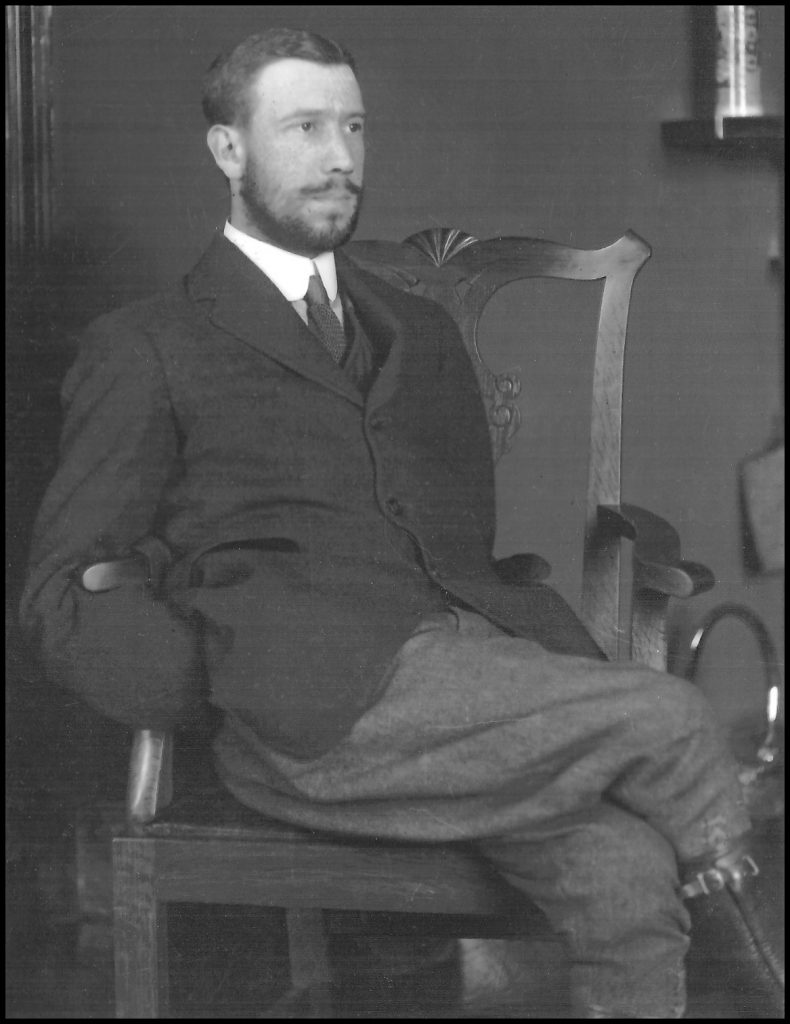
Walter Grant’s involvement in local affairs is illustrated by his work as president of the Orkney Trout Fishing Association, and his assistance with the introduction of an airmail service to and from Orkney. Captain Ted Fresson’s Highland Airways began the first scheduled flights in the Highlands between Inverness, Wick and Kirkwall in 1933. After 12 months of successful operations the company was awarded a contract by the Royal Mail to begin an airmail service between Inverness and Kirkwall. This was Britain’s first internal scheduled airmail service at normal postal rates and it commenced on 29 May 1934.
Walter G. Grant was regarded as one of the greatest patrons of the archaeology of Orkney and Scotland, having funded some of the most important digs and research sites across the country. He was prompted by the work carried out at Skara Brae by Professor Vere Gordon Childe and after initial sites were unearthed he undertook what was to be his greatest archaeological achievement – the excavation of the broch of Midhowe on Rousay’s Westside.
A young Walter G Grant – and below, details of Trumland House and policies on the 1931-32 valuation roll
Walter Grant’s involvement in local affairs is illustrated by his work as president of the Orkney Trout Fishing Association, and his assistance with the introduction of an airmail service to and from Orkney. Captain Ted Fresson’s Highland Airways began the first scheduled flights in the Highlands between Inverness, Wick and Kirkwall in 1933. After 12 months of successful operations the company was awarded a contract by the Royal Mail to begin an airmail service between Inverness and Kirkwall. This was Britain’s first internal scheduled airmail service at normal postal rates and it commenced on 29 May 1934.
Walter G. Grant was regarded as one of the greatest patrons of the archaeology of Orkney and Scotland, having funded some of the most important digs and research sites across the country. He was prompted by the work carried out at Skara Brae by Professor Vere Gordon Childe and after initial sites were unearthed he undertook what was to be his greatest archaeological achievement – the excavation of the broch of Midhowe on Rousay’s Westside.
With Dr J Graham Callander, director of the National Museum of Antiquities of Scotland, giving personal supervision during the summer months, work continued from 1930 to 1933. In a paper written in 1934 it was stated that ‘The time taken to excavate the broch lasted for five consecutive summers and a few winter months and practically the whole work of cleaning out the structures was done by Mr James K Yorston. It has been computed that he wheeled out from 1500 to 2000 tons of fallen stones and debris.’
The excavation aroused a considerable amount of interest and acclaim. In an Office of Works minute, dated November 5th 1933, Mr James Richardson of HM Office of Works wrote, ‘…..not only has Yorston cleared the interior of the broch and excavated the labyrinth of secondary buildings between the outer rampart and the main tower, but he has also consolidated part of the structure in a sympathetic manner quite equal to the best of our own work. Mr Grant has spent a very considerable sum on the undertaking and he has also borne the expense of having the monument carefully surveyed.’
Callander, writing in The Scotsman, dated April 13th 1933, stated: ‘It is many years since an excavation on such a large scale as this has been attempted of a prehistoric site in Scotland by a private individual and so Mr Grant has earned the cordial thanks of all interested in Scottish archaeology. He and his assistant Mr J Yorston are to be heartily congratulated on the patience and skill displayed in their work… .’
Grant was elected a Fellow of the Society of Antiquaries of Scotland in 1930, and in the ensuing years carried out excavations on many of the monuments on Rousay. He enlisted the help of Callander for a number of excavations, in addition to that at Midhowe broch, notably the chambered cairns at Midhowe, Knowe of Yarso, Knowe of Ramsay and Blackhammer. J Hewat Craw, who was working at the Broch of Gurness, Aikerness, on the opposite side of Eynhallow Sound between 1930 and 1933, was invited across to excavate at Midhowe chambered cairn. An excellent draughtsman, David Wilson, was employed by Grant, and invaluable assistance was given by Mr J K Yorston and his son from the Trumland estate.
Following Grant’s death the property was occupied by a Mr Dolby, until 1966 when Major Rio Ritchie was in residence until his demise in 1979. Trumland House was undergoing renovation by a subsequent owner but disaster struck on April 4th 1985 when a fire caused considerable damage, leaving the property roofless and with the upper floors and principal rooms seriously damaged or destroyed. The fire started with a workman leaving a hot blow torch (turned off) on a very dry beam as they went for lunch, and it wasn’t long before the flames took hold. Much of the damage to the house was caused by water, as the huge thick doors on the upper floor kept the fire at bay. The smoke was visible from all parts of the island, and many residents hurried to the house and formed a human chain, saving valuable furniture and paintings from destruction. After re-roofing the house was again sold, and passed un-restored through a series of owners until purchased by the present owners in 2002, who are now in the process of returning the house and gardens to its previous form – and the photos below show just that.
[Details of FWT-B’s war service record were taken from his obituary, published in the 93rd
Sutherland Highlanders regimental newspaper The Thin Red Line and the Orkney Herald.
Other extracts within the text have been reproduced by permission of Birlinn Ltd.
Reference was made to the following publication regarding Walter Gordon Grant:-
Walter Gordon Grant: an archaeological appreciation written by Diana M Reynolds
and J N Graham Ritchie and published in Proc Soc Antiq Scot, 115 (1985), 67-73,
available at Orkney Library & Archive.
Photo credits: Orkney Library & Archive; Tommy Gibson; Brian Halcro;
and the present owners of the Trumland Estate.]
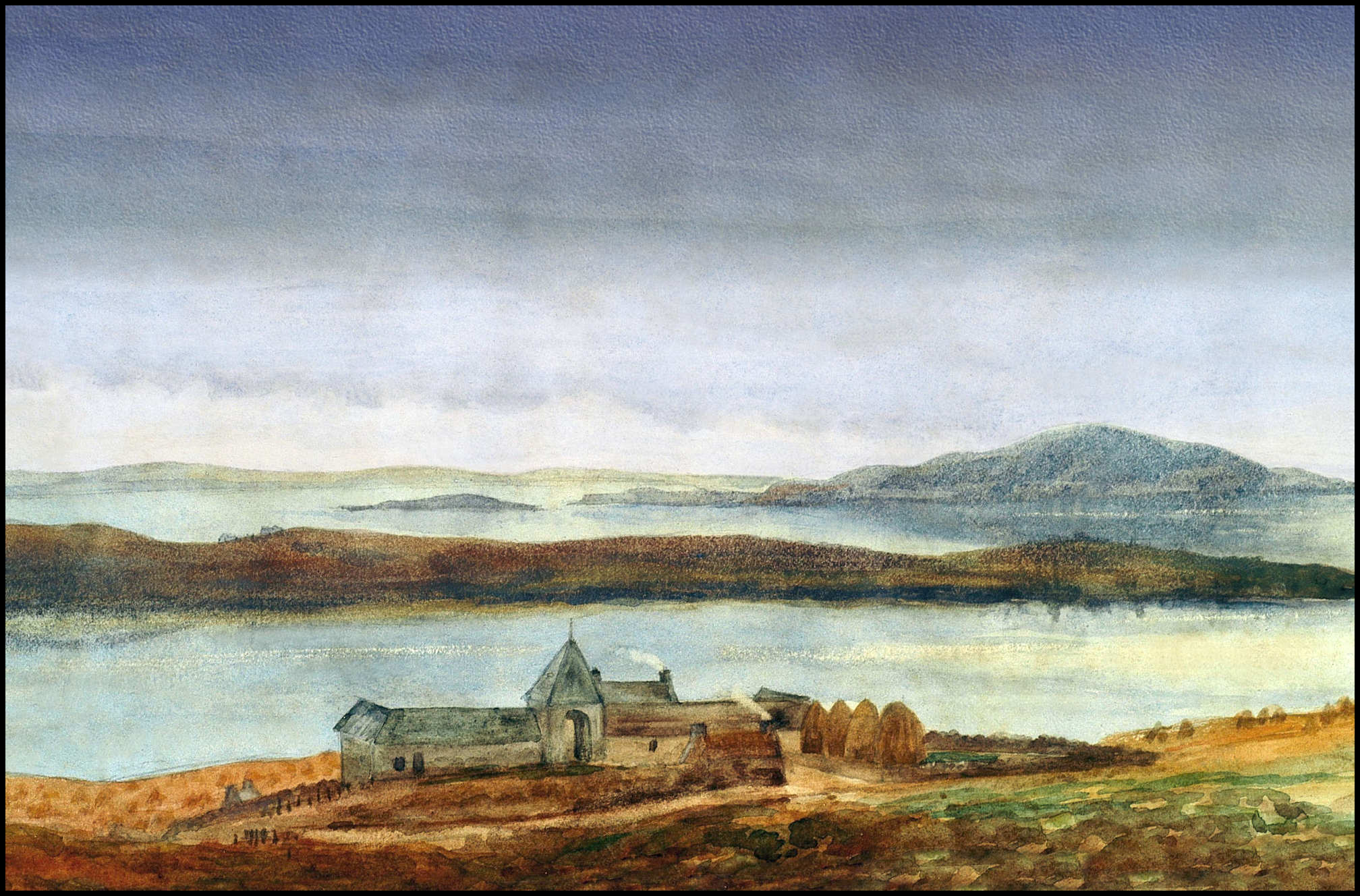

Trumland Farm is first mentioned in old parish records as being occupied by ‘John of Trimland’ in 1503. In the 1595 Rental Trumland was skatted as a 2d. land, lying on either side of the Burn of Trumland, which flows down from the Hass of Trumland, on the southern slopes of the hills of Blotchniefiold and Knitchin. Later tenants were named as Magnus Trumbland, between 1653 and 1655, William Miller in 1702, Magnus Bancks, in 1706, and James Banks between 1737 and 1774.
In the 1840’s Trumland was farmed by Peter Yorston. He originally lived at Oldman, Sourin, and in 1813 at Corse, Frotoft, he married Rebecca Craigie, daughter of Mitchell Craigie and Rebekah Marwick of Hullion. They had three children; Peter, was born on May 8th 1814; Mary, on July 23rd 1816; and Ann, who was born on January 19th 1823.
Another tenant at Trumland at this time was James Yorston, who was in his 80’s. His son, also called James, farmed the land alongside Peter Yorston, but to my knowledge they were not directly related.
By the time the census of 1851 was carried out James Yorston and his family had left Rousay. Peter Yorston had died and his widow Rebecca lived at Bare Braes, a small croft above Cogar, with her daughter Ann, who by then was a 27-year-old straw plaiter.
Robert Scarth was the notorious factor of George William Traill’s Rousay estate and it was he who was the architect of the clearance of the Quandale crofters after the harvest of 1845. These clearances occurred in two phases: 1845-48, and 1855-59, by which time the cottars finally lost residual rights to keep animals and cultivate land.
The farm at Trumland had been taken over by Robert Scarth’s son George, a 30-year-old farmer from Kirkwall, paying an annual rent of £39 12s 3d, with the interest on improvements added. He lived there with his Orphir-born wife Catherine Robertson, sons Robert (6) and James (3), who were born in Firth, and 8-month-old daughter Catherine. Also living at Trumland at this time were farm labourers John Shearer (22) from Stronsay, and 19-year-old James Inkster, housekeeper Mary Craigie, who was 24 years old, and John Johnston, a 13-year-old herd.
By the time of the next census, 1861, George and Catherine had had another four children, John, George, Robina, and Thomas. George was farming 70 acres of land at Trumland, but this had increased to 92 by 1871. George Scarth retired as factor in 1873 – and after that things were different at Trumland. Rent arrears hardly existed under Scarth, despite a steady increase in rent, but he saw to it that tenants managed to pay their dues with relative ease. Very soon after his retirement rents increased rapidly between 1873 and 1883. Robert Scarth’s son-in-law John MacRae acted as factor during the first three years of this period and was very unpopular with the Rousay crofters. He was also Orkney’s Procurator Fiscal and the laird, General Burroughs’ personal lawyer, which didn’t help matters much either.
In the 1870’s Burroughs spent £2,608 on Trumland farm, but despite this ambitious programme of building, draining, reclaiming, and fencing, there was never a time when the farm operated at a profit as long as it was under Burroughs’ management. The loss on Trumland Farm was regularly about £180 a year. He spent a further £1,320 on non-agricultural improvements, largely houses for his servants, including his yacht-master, and a cottage for the drill sergeant of the Rousay Volunteers. In 1875 a new resident factor was employed to manage the estate. He was George Murrison and he and his wife Mary lived at Viera Lodge.
The census of 1881 reveals no less than five families living and working on the Trumland estate. The first of these was Charles Johnston, his wife Ann Harrold, and their four children. Charles was the son of John Johnston, Brinian, and Elizabeth Reid, Pow, Westside. Charles’s wife Ann was the daughter of James Harrold of Boray, Gairsay, and his first wife Isabella Gibson of Langskaill.
Farm labourer James Logie was employed as a farm labourer at Trumland at this time. He was the son of John Logie, Geo, Westness, and Mary Craigie, Whome, and he was born in June 1829. He was married to Betsy Gibson, daughter of Alexander Gibson and Isabel Marwick, and she was born in June 1823 when the family were living at Stennisgorn, Wasbister.
36-year-old John Manson was employed as Trumland’s grieve. In those days a farm’s grieve held the responsibility of managing the farm, and was mainly engaged in supervision and allocation of duties; he would also superintend the work of agricultural labourers, e.g., carters, cowman; and was at liberty to buy and sell produce and equipment on the laird’s behalf. John was from Watten, Caithness, as was his wife Alexandrina. They had five children at that time, Sidney, John, Duncan, Donald, and Jessie. Under the same roof were four farm workers – James Marwick (24), Donald Allan (22), Mary Marwick (20), who were farm servants, and 20-year-old Mary Leask, from Stenness, who was a dairymaid.
By 1891 Trumland Farm had a manager – 47-year-old Peter Swanson from Thurso. His wife Margaret Manson was from Canisbay, and with them were their children; George, a fifteen-year-old apprentice joiner, scholars John, Peter, Catherine and William. Under another roof at the farm were Barbara Rosie, a 33-year-old dairymaid from Burray; William Leask from Kirkwall, who was employed as a farm servant; and Mary Marwick, a 32-year-old general servant.
Living at the Old Mill at this time were farm servant John Cutt and his wife Mary Craigie – and general labourer James Logie and his wife Betsy Gibson.
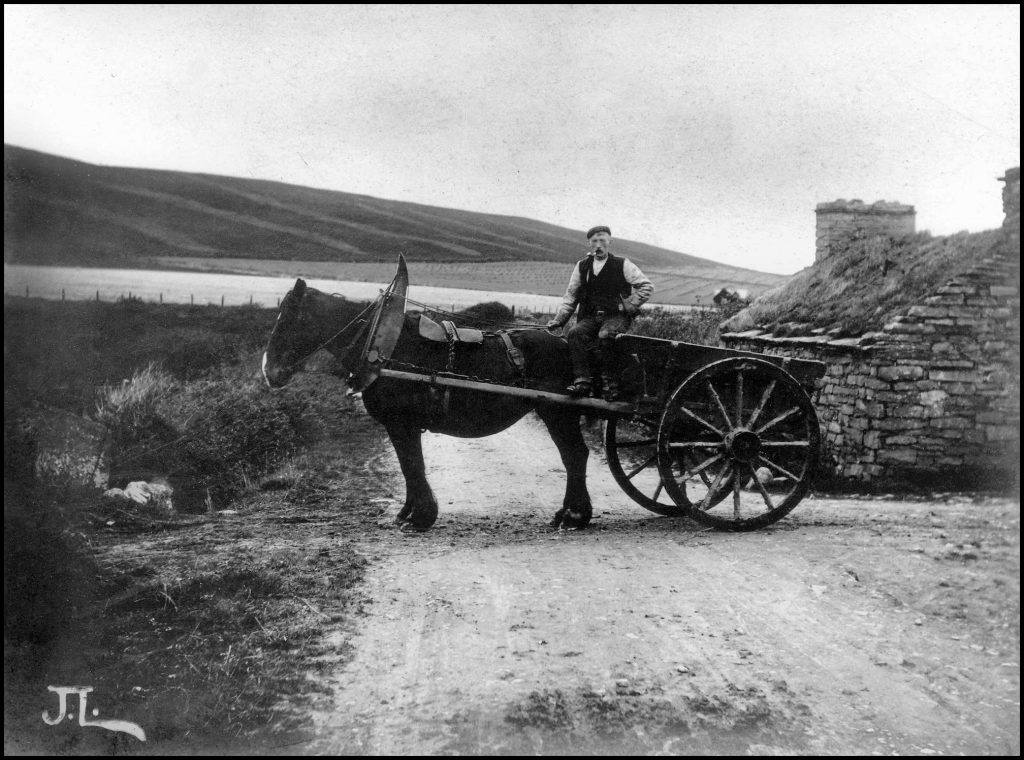
Dishans was the name of a cottage on the left of the track down to Trumland farmhouse. Little or nothing is known of it – but it could well have been named after its occupants – Mr and Mrs Dishan! The 1901 census tells of crofter James Dishan [52] from Evie and his wife Christina [53] of Westray living at West Craye, Sourin. By the time the 1911 census was carried out Christina was a ‘ploughman’s widow’, living at Gue, Westness. I’m guessing James was employed on the farm and this is where he and Christina lived during that time.
Between 1894 and 1900 David Wood was paying an annual rent of £110 at Trumland farm. Come the census of 1901 the resident farmer was 26-year-old Hamilton Hebden Horne [known as Hamish] from Warsetter, Sanday. He was the son of farm factor Adam Horne and Robina Strong. On November 23rd 1900 he married 29-year-old school teacher Betsy Ann Marwick, daughter of carpenter Hugh Marwick and Lydia Gibson, Guidall, Sourin. Under the same roof lived Margaret Louttit, a 24-year-old domestic servant, and two farm servants, Donald Robson (16), and James Inkster (24). The Old Mill was occupied by 42-year-old ploughman John Shearer, who was born in Stronsay, and his wife Catherine (39) was from Sandwick. They had six children: Catherine, at that time a 16-year-old domestic servant, Janet (9), Eliza (7), and Peter (5) who were all at school, and 2-year-old William, and Violet, who was just 2 weeks old when the census was carried out.
Ten years on [1911] and 67-year-old widow Eliza Craigie from Evie was head of the household at Trumland, and registered as farmer/employer on the census return. With her was her unmarried 27-year-old daughter, a domestic worker, Hugh Marwick, a 23-year-old ploughman, and 15-year-old Tom Marwick, who was employed as a cattleman. Under another roof lived the Robertson family. 42-year-old William Robertson from Sandwick was the farm’s foreman. With him was his wife Isabella and 12-year-old son James. Four-year-old nephew George Wards was visiting at the time.
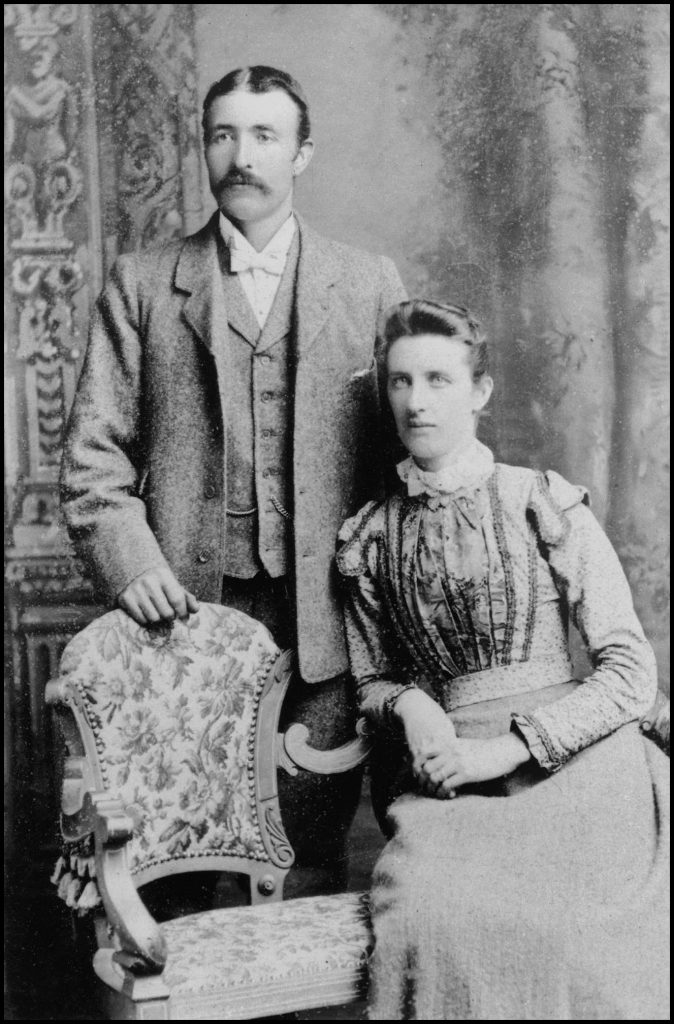
Frederick Traill Inkster moved from his father Hugh’s farm at Westness to farm land at Furse and Innister. He married Isabella Craigie, daughter of James Craigie, Claybank, and Isabella Kirkness, Quoyostray. They eventually moved from Wasbister to take over the tenancy of Trumland Home Farm in the early 1900s. When Frederick retired from farming he and Isabella took up residency at Greenfield, between the farm and the pier – that house’s name being the same as that of the farm in Shetland where Frederick was born in September 1868.
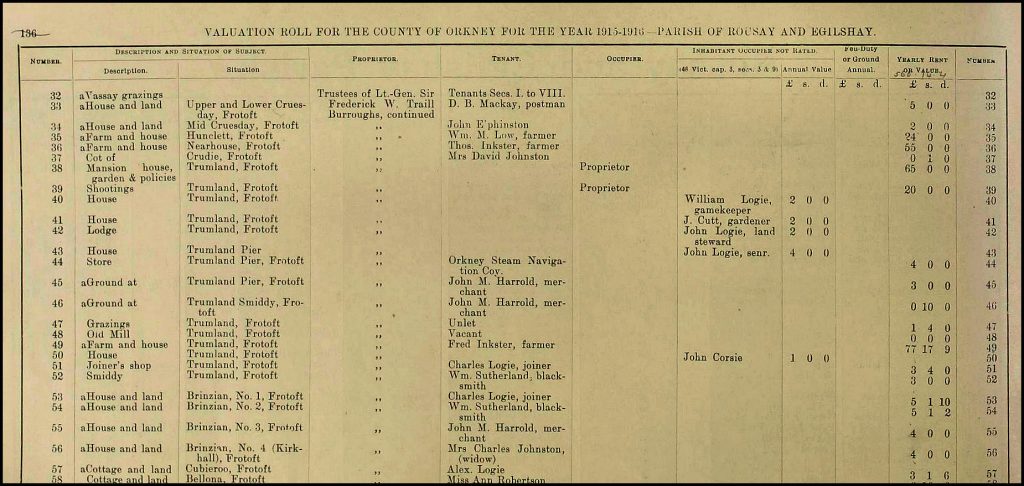
In 1922 Trumland Farm was occupied by James Halcro Johnston, his wife Margaret Ritch, and children Robert, James William, & Violet. James was born at Crook, Rendall, in June 1880, the son of farmer Jacob Johnston and Ann Wood who had married in Rousay in December 1875. James & Margaret [pictured below] married in February 1905. She was the daughter of farmer William Ritch, Orquil, Rendall, and Jemima Firth.
Their son James William was well-respected throughout the farming industry. Part of his obituary in the Sunday Herald newspaper, dated September 2001, give us an insight:-
Retired farmer and poultry expert James Johnston, 94, farmed at Newton of Fintray, near Aberdeen, for more than 50 years.
Orkney-born Mr Johnston – known to his relatives in the Orkney tradition as James-William and to his friends as Jimmy – hit the headlines in 1951 when his cross-bred heifer, Kilmeny, won the butchers’ cattle championship at the Scottish National Fatstock Show in Edinburgh and went on to win the reserve supreme championship at the Royal Smithfield Show at Earls Court, London.
He was born in 1907 in a small, two-roomed cottage on the farm of Crook, Rendall, Orkney, where his family had been tenants since 1840, and moved to Trumland on the island of Rousay in 1922 when his father took on the Home Farm. Despite colour blindness, he was naturally artistic and in his younger days painted watercolours which still hang in the homes of friends and family…..
[All black & white images are courtesy of Tommy Gibson]